In addition to conservation treatments, second-year master’s degree students need to complete scientific research projects for the course ARTC-898, a requirement for the Master’s degree in Art Conservation (M.A.C.). The abstracts and posters from these projects are shown in this section.
To access full-sized versions of abstract posters, click the link at the bottom of each abstract.
2023-2024
Emily Claire Docking
The provenance of a Tanagra figurine in the Diniacopoulos Collection at Queen’s University was investigated through validating previous pigment identification through optical and polarized light microscopy (O/PLM), fiber optics reflectance spectroscopy (FORS).The components of the clay body through x-ray diffraction (XRD) and scanning electron microscopy – energy dispersive spectroscopy (SEM-EDS). The presence of red ochre, yellow ochre, and ultramarine on the figurine was supported by FORS analysis, while the presence of synthetic ultramarine in the purple remains ambiguous. Quartz, calcite, muscovite, and albite were identified through XRD and supported by FTIR and SEM-EDS. The presence of calcite suggests a firing temperature between 500°C and 850°C, which is consistent with historic firing technologies. The use of these analytical techniques in conjunction with art historical research into the techniques and materials of both authentic Tanagra figurines and forgeries supports a deeper understanding of this figurine.
Maia C Donnelly
The recurring issues with pulp fills in conservation treatments are mostly related to matching the object being mended—in surface texture, translucency, thickness, and dimensional stability. What if conservators prepared their paper pulp for fills with more intent and with a better understanding of the ways in which pulp preparation affects the results? Could conservators consider the use of papermaking additives, such as formation aids, to achieve better outcomes? Beating method, beating time, formation technique, and the use of polyethylene oxide (PEO) formation aid were investigated to provide tangible ways with which conservators can ameliorate their pulp infills. Using a Hollander beater and a kitchen blender, pulp fill samples were be made with different combinations of beating times and formation aids before being assessed. Fibre length and degree of fibrillation will be measured using PLM; surface texture visualised using raking light imaging and the Hirox 3D digital microscope; formation and evenness evaluated using transmitted light; shrinkage measured using a grid; and the presence PEO in the infills tested using FTIR. The results largely confirmed hypotheses, showing that with increased beating time, pulps showed increased fibrillation and number of fines and that pulps beaten rather than blended had increased fibrillation and more fines. As expected, pulps showed increased shrinkage and more edge cockling with increased beating time, which also increased evenness in formation. The use of PEO increased evenness in formation and surface texture and did not lease residues behind in the dry pulp. Finally, fibre length average remained the same between both beating times in the beater, whereas fibre length shortened with increased time in the blender. The research drew connections between the different variables in creating pulp infills and put forward recommendations for ways in which they can be improved.
Caitlin Gallupe
Lichen dyes are naturally occurring colourants that were widely used throughout history for textile dyeing and select species are the source of “orchil” purple. This project focused on the investigation and analysis of textile samples dyed with the Umbilicaria mammulata lichen species to determine the lightfastness of this historical dye. Researchers in recent years have developed analytical methods to identify orchil purple dyes on textiles, but studies on this species are still lacking. The experimental methodology included three phases: identification and methods of extraction and dyeing; accelerated light aging, colour spectrophotometry and fibre optics reflectance spectrometry (FORS); and data analysis. Recipes following both historical methods and contemporary recreation methods were used to create two ammonia-based dye bath solutions, employing either urine or ammonium hydroxide, that dyed fabric samples of wool, silk and linen to mimic 18th-century textiles. Accelerated light ageing was undertaken at both Queen’s University in a Q-SUN test chamber and in collaboration with the Canadian Conservation Institute (CCI) in a custom fadeometer. Colour spectrophotometry and FORS then quantified changes from the different light exposure. CCI analyzed the samples before light aging to identify dye markers using gas chromatography-mass spectrometry, which offered a comparative dye analysis of the two ammonia-based dye bath solutions. Results from this research complemented the characterized collection of natural dyes at CCI that includes samples dyed using other orchil-producing lichen species. This data contributed information about the identification and characterization of the properties of lichen-dyed textiles and provided knowledge on how to care for historical textile objects.
John Habib
Manuscripts from the Islamicate have unique materials and methods of manufacture, yet these aspects have been understudied and subject to generalizations by both conservators and historians. The superficial treatment of these cultural materials can be exemplified by the very broad term in use—"Islamic manuscripts” —to describe a complex set of manuscripts made in more than 50 countries, throughout 1300 years of history, by a variety of intertwined cultural groups. This project focuses on a particular manuscript from Ottoman Egypt, which was a multicultural hub where different civilizations interacted with and influenced each other. This 18th-century manuscript at the Coptic Museum of Canada exemplifies this multicultural reality by having Greek, Arabic, and Coptic text written on paper made in Europe for specific export to the Middle East. The manuscript has many ornamental headers and three colourful, full-page illuminations. Various analytical techniques were used to identify the pigments and binders used in an illumination of Mary holding Christ. The manuscript was analyzed using digital microscopy, multimodal imaging, scanning X-ray fluorescence (XRF) spectroscopy, external reflectance Fourier-transform infrared (FTIR) spectroscopy, and fibre optic reflectance spectroscopy (FORS). Lead white, arsenic sulfide yellow, Prussian blue, red lead, vermilion, gold leaf, and iron gall ink were identified. Digital microscopy, multimodal imaging, FTIR, and FORS were used to corroborate the pigment identification and identify the binder of the paint layers as egg yolk. This study is the first to examine Coptic post-medieval manuscripts and would allow for further investigation into cultural links and trade routes leading to 18th-century Ottoman Cairo.
Carl Maggarro
This project was a continuation of an existing study conducted in 2015 by the Canadian Conservation Institute. Varnishes were investigated from 19th-century Ontario and New Brunswick furniture housed in the Canadian Museum of History (CMH) collection. This preliminary study focused on varnished surfaces of Quebec furniture at the CMH from the same era and the information gathered were compared to the 2015 study. By understanding the components used within these finishes, conservators can use the information collected from this research to make informed decisions for safeguarding Canadian furniture collections. Three furniture pieces were chosen for similar analyses from the CMH collection. Extracted microsamples were analyzed from these objects through reflected light and fluorescence microscopy and Fourier transform infrared spectroscopy (FTIR). These analytical methods were also used in the 2015 study.
Frances Opferman
The composition, solubility, and lightfastness of permanent colored pencils was investigated. Paper conservators may encounter colored pencils as a medium on a work of art or use them for retouching during treatment. The three primary colors of both artist-grade and student-grade colored pencils from two art material manufacturers (Caran d’Ache and Faber-Castell) were studied. Attenuated total reflectance Fourier transform infrared (ATR-FTIR) spectroscopy of the pencil leads was used to determine the organic components in the colored pencils. Solvent extraction methods were used to selectively analyze components with microspectroscopy. X-ray fluorescence (XRF) of the pencil leads was used to determine elemental information and identify the colorant. Drawn samples underwent light aging to determine their lightfastness and compare differences between pencil levels and brands. Colorimetry readings were taken with a color spectrophotometer before and after light aging to monitor color change, which was also compared to blue wool standards. The colored pencils all contained colorants, both organic and inorganic, waxes, and powdered fillers, though the type of compositional material often varied by brand and quality. Organic solvents solubilized components in all the colored pencils; the Caran d’Ache pencils also contained water-soluble material. The colored pencils had variable lightfastness depending on color, brand, and quality, and thus should be considered a light sensitive material. Further research in all areas is needed to draw more detailed conclusions.
Doris Fuller Ruiz
Portrait of a Nobleman is a 17th-century Spanish painting belonging to the National Gallery of Canada, by an unknown artist. In the past this portrait was attributed first to Velazquez and then Murillo, however the latest study has suggested Claudio Coello as a possibility. Recent studies have identified and characterized plant ash in preparation layers of 17th-century Spanish paintings including some of Coello. This research project aimed to identify the artistic materials used and their application, while also searching for the presence of plant ash in the paint and ground layers. Non-destructive and minimally invasive techniques were used to study the construction of the painting, examine changes to the composition and identify the elemental composition of pigments. Samples were analyzed with polarised light microscopy, Fourier transform infrared spectroscopy (FTIR) and scanning electron microscopy-energy dispersive spectroscopy (SEM-EDS) to obtain the layer structure, compositional information, and physical characteristics of particulates. Analysis with these techniques confirmed that the artist used a traditional 17th-century Spanish palette; and showed a build-up of a red priming layer over a ground layer with ash particles. This research provided more technical data on the work and in turn more information about the unknown artist to add to the body of technical knowledge on the works of 17th-century Spanish painters.
Travis Zuidema
An artist’s traveling case containing unknown materials has been stored in the Art Conservation Program’s Microscopy Lab at Queen’s University prior to 2002. The contents are mostly hand labeled glass vials. There are also discoloured and solidified materials in the bottom tray. Some of the dry pigments have spilled out into the case. The goal of this project is to identify the materials and tidy the case so that it may be used for display and safe storage. The project relied heavily on handheld x-ray fluorescence spectroscopy (XRF) for elemental analysis of the pigments, Fourier transform infrared spectroscopy (FT-IR) of the organic materials, and polarized light microscopy (PLM) of the pigments. It was important to minimize the amount of sample taken in order to preserve the contents of the case. Health and safety was a large focus for this project as well because materials needed to be treated as toxic until proven otherwise. There are likely several toxic pigments and more could be identified in a future project. It was important to create a methodological guide to approaching an unknown collection that encompassed: safety, identification, and storage. Data collected offer a suggestion to a time period of usage, and even a possible owner of the pigment case. A case study of Paul Kane’s paint box (National Gallery of Canada) was considered and compared to the presentation of this one.
2022-2023
Antonia Mappin-Kasirer
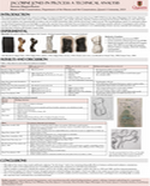 This research project investigated six artifacts by the British-Canadian sculptor Jacobine Jones (1897-1976) with the goal of shedding light on the artist’s materials and techniques. These objects are part of Queen’s University’s holdings of Jacobine Jones’ work, from the 1990 acquisition of her studio contents and archives. Over 170 objects including sculptures, moulds, casts, maquettes, tools and material samples are housed at the Agnes Etherington Art Centre. The Queen’s University Archives holds personal and business documents, photographs, sketches and notebooks. The six objects studied in this project were chosen from two series bookending Jacobine Jones’ career and include both “in-process pieces” and finished sculptures. From the series Happy Horse (1930), a metal-alloy cast, plaster cast, and rubber mould were examined. From the series Female Torso (1969), a clay maquette, plaster cast and plaster and rubber mould were examined.Methods of examination and analysis included multispectral imaging, X-ray fluorescence spectroscopy (XRF) and Fourier-transform infrared spectroscopy (FTIR). Analytical methods were combined with primary source archival research. Close study of the “in-process pieces” revealed complimentary information about the artist’s materials and techniques. Key takeaways from this research include Jones’ consistency in materials and techniques in her process of modelling and casting. Analysis suggests that Happy Horse (1930) is brass (copper-zinc alloy) rather than a bronze (copper-tin alloy), as previously identified in the sculpture’s documentation; that it was cast solid, with a mould pulled from the same plaster cast examined in this study.The plaster cast XRF of Happy Horse (plaster) revealed iron, copper, zinc and lead, suggesting that the original finish of the piece employed metallic pigments for a faux-bronze effect. The mould for Female Torso reveals information about its fabrication process: with evidence of burlap reinforcing the plaster mother mould, traces of a wax-based mould-release, and fading inscriptions of casting dates. In both mould polymers, analysis identified lead, sulfur and phthalate esters. Future research will include further investigation of the plastic mould material and variations in patination for plaster and metal-alloy casts.
This research project investigated six artifacts by the British-Canadian sculptor Jacobine Jones (1897-1976) with the goal of shedding light on the artist’s materials and techniques. These objects are part of Queen’s University’s holdings of Jacobine Jones’ work, from the 1990 acquisition of her studio contents and archives. Over 170 objects including sculptures, moulds, casts, maquettes, tools and material samples are housed at the Agnes Etherington Art Centre. The Queen’s University Archives holds personal and business documents, photographs, sketches and notebooks. The six objects studied in this project were chosen from two series bookending Jacobine Jones’ career and include both “in-process pieces” and finished sculptures. From the series Happy Horse (1930), a metal-alloy cast, plaster cast, and rubber mould were examined. From the series Female Torso (1969), a clay maquette, plaster cast and plaster and rubber mould were examined.Methods of examination and analysis included multispectral imaging, X-ray fluorescence spectroscopy (XRF) and Fourier-transform infrared spectroscopy (FTIR). Analytical methods were combined with primary source archival research. Close study of the “in-process pieces” revealed complimentary information about the artist’s materials and techniques. Key takeaways from this research include Jones’ consistency in materials and techniques in her process of modelling and casting. Analysis suggests that Happy Horse (1930) is brass (copper-zinc alloy) rather than a bronze (copper-tin alloy), as previously identified in the sculpture’s documentation; that it was cast solid, with a mould pulled from the same plaster cast examined in this study.The plaster cast XRF of Happy Horse (plaster) revealed iron, copper, zinc and lead, suggesting that the original finish of the piece employed metallic pigments for a faux-bronze effect. The mould for Female Torso reveals information about its fabrication process: with evidence of burlap reinforcing the plaster mother mould, traces of a wax-based mould-release, and fading inscriptions of casting dates. In both mould polymers, analysis identified lead, sulfur and phthalate esters. Future research will include further investigation of the plastic mould material and variations in patination for plaster and metal-alloy casts.
Keywords: Sculpture, Jacobine Jones, Bronze, Brass, Plaster, Mould, Modelling, Casting, Canadian Art, Woman Artist
Hélène Sirois
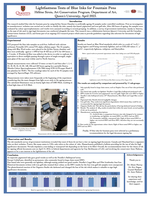 This research project evaluated the lightfastness of blue inks for fountain pens considering different classes of products: dye-based, pigmented and iron gall. This research also reviewed terminology used to market inks, and regional requirements for high significance documents in governmental institutions. It was a collaboration between Queen’s University and the Canadian Conservation Institute (CCI) researchers, Dr. Eric Hagan and Crystal Maitland, and forms part of an ongoing CCI research project. The aim of the CCI project is to provide guidelines regarding inks selection for documents of high significance, and also to develop open datasets for use in risk assessment tools related to exhibit lighting. After a literature review and a survey carried out on the standards of different countries, a selection of blue inks for fountain pens was tested to characterize their lightfastness. The purpose of the research was to assess lightfastness of these blue inks. A Q-Sun Xenon Test Chamber was used for accelerated light exposure simulating UV-filtered daylight, while similar experiments are underway at CCI using a custom LED fadometer to represent modern electric gallery lighting. Lightfastness results were assessed by colour spectrophotometry, and results were categorized according to several grouping: general dye-based inks of high light sensitivity, specialty dye-based inks of high lightfastness (Blue Wool 5 results or higher), pigmented inks, and iron gall inks. Results were also assessed according to manufacturers’ terminology used for marketing such as ‘archival’ or ‘permanent’.
This research project evaluated the lightfastness of blue inks for fountain pens considering different classes of products: dye-based, pigmented and iron gall. This research also reviewed terminology used to market inks, and regional requirements for high significance documents in governmental institutions. It was a collaboration between Queen’s University and the Canadian Conservation Institute (CCI) researchers, Dr. Eric Hagan and Crystal Maitland, and forms part of an ongoing CCI research project. The aim of the CCI project is to provide guidelines regarding inks selection for documents of high significance, and also to develop open datasets for use in risk assessment tools related to exhibit lighting. After a literature review and a survey carried out on the standards of different countries, a selection of blue inks for fountain pens was tested to characterize their lightfastness. The purpose of the research was to assess lightfastness of these blue inks. A Q-Sun Xenon Test Chamber was used for accelerated light exposure simulating UV-filtered daylight, while similar experiments are underway at CCI using a custom LED fadometer to represent modern electric gallery lighting. Lightfastness results were assessed by colour spectrophotometry, and results were categorized according to several grouping: general dye-based inks of high light sensitivity, specialty dye-based inks of high lightfastness (Blue Wool 5 results or higher), pigmented inks, and iron gall inks. Results were also assessed according to manufacturers’ terminology used for marketing such as ‘archival’ or ‘permanent’.
Kristen Fader
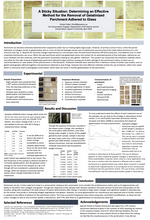 A major tool in conservation treatments for paper conservators is water, subsequently making parchment conservation a precarious endeavor. Unlike cellulose-based materials which can typically absorb and desorb water with its known risks being generally accepted depending on the treatment, parchment being a proteinaceous material is very hygroscopic and can gelatinize in contact with water leading to a loss of internal hydrogen bonds and a fundamental restructuring of the triple helical structure to a coil structure. This gelatinization results in undesirable translucency and stiffness. Consequently, if a parchment becomes adhered to another material, it can be difficult to proceed with its treatment, even more so if the parchment becomes gelatinized and adhered to glass. Compared to other materials that may become adhered to parchment with a specific adhesive, such as fabric tapes or other protein-or cellulose-based products, glass cannot preferentially absorb aqueous or nonaqueous solutions and the parchment itself would be the material to take up these solutions in its matrix. Though the conservation literature for parchment is expansive and well developed, there is a scarcity of case studies or research on the topic of parchment adhered to glass due to gelatinization. Literature for other historic objects adhered to glass, such as photographs and paintings, provided preliminary research into the techniques used, however, no suitable or applicable treatments were discovered. Therefore, through this research, various treatments were tested on prepared samples, using historical parchment from the Queen’s University Archives, to determine the most effective method for the removal of parchment on glass while preserving and safeguarding the aesthetic and mechanical and chemical properties of the parchment. In addition to a multi-spectral analysis and FTIR characterization of collagen degradation of the parchment upon removal, colour measurements and weight were taken to determine the efficacy of each removal method. The most successful treatments when looking holistically at every analytical method were those utilizing humidity rather than direct contact of solvents with the samples, such as the humidification chamber, and water vapour using Gore-tex. It appears the samples using ethanol had positive effects for treatment visually, but after FTIR analysis, these were shown to cause the most damage to the parchment collagen structures. The reason for this is undetermined and further research will be needed to determine the cause.
A major tool in conservation treatments for paper conservators is water, subsequently making parchment conservation a precarious endeavor. Unlike cellulose-based materials which can typically absorb and desorb water with its known risks being generally accepted depending on the treatment, parchment being a proteinaceous material is very hygroscopic and can gelatinize in contact with water leading to a loss of internal hydrogen bonds and a fundamental restructuring of the triple helical structure to a coil structure. This gelatinization results in undesirable translucency and stiffness. Consequently, if a parchment becomes adhered to another material, it can be difficult to proceed with its treatment, even more so if the parchment becomes gelatinized and adhered to glass. Compared to other materials that may become adhered to parchment with a specific adhesive, such as fabric tapes or other protein-or cellulose-based products, glass cannot preferentially absorb aqueous or nonaqueous solutions and the parchment itself would be the material to take up these solutions in its matrix. Though the conservation literature for parchment is expansive and well developed, there is a scarcity of case studies or research on the topic of parchment adhered to glass due to gelatinization. Literature for other historic objects adhered to glass, such as photographs and paintings, provided preliminary research into the techniques used, however, no suitable or applicable treatments were discovered. Therefore, through this research, various treatments were tested on prepared samples, using historical parchment from the Queen’s University Archives, to determine the most effective method for the removal of parchment on glass while preserving and safeguarding the aesthetic and mechanical and chemical properties of the parchment. In addition to a multi-spectral analysis and FTIR characterization of collagen degradation of the parchment upon removal, colour measurements and weight were taken to determine the efficacy of each removal method. The most successful treatments when looking holistically at every analytical method were those utilizing humidity rather than direct contact of solvents with the samples, such as the humidification chamber, and water vapour using Gore-tex. It appears the samples using ethanol had positive effects for treatment visually, but after FTIR analysis, these were shown to cause the most damage to the parchment collagen structures. The reason for this is undetermined and further research will be needed to determine the cause.
Rose Émond-Gagnon
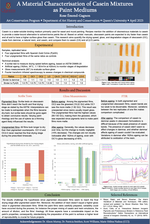 Casein is a natural milk phosphoprotein where the treated curds form a powder historically used as a water-based adhesive or binding medium. At the beginning of the 20th century, casein regained popularity as a medium for easel, architectural and mural paintings. Recipes mention the addition of varnish to make oleocasein improves its properties compared to casein, for instance speeding up drying time and providing gloss to the film. The following study explores how oleocasein differs from pure casein and oil since publications on the characterisation and degradation of oleocasein in the realm of conservation are sparse. In order to study the mechanical and chemical properties, pigmented and unpigmented oleocasein blends composed of casein and dammar were prepared with different ratios. The drying speed of the films was determined by scribe tests. The samples were analysed before and after artificial ageing. Fourier transform infrared spectroscopy (FTIR) was used to identify compounds during different stages of degradation. Gloss measurements were taken to characterise the films’ surface gloss. Observations were compiled concerning the paint-making process and the paints’ handling properties. Due to high variability between the films, the results were difficult to interpret and compare; consequently, only tentative conclusions can be formulated. The drying speed of oleocasein films varied greatly depending on the ratio of casein to dammar. Moreover, based on visual observations, the glossiness of oleocasein films increases with the quantity of dammar. Standardising the preparation of the paint and incorporating changes in the experimental section are essential for future projects.
Casein is a natural milk phosphoprotein where the treated curds form a powder historically used as a water-based adhesive or binding medium. At the beginning of the 20th century, casein regained popularity as a medium for easel, architectural and mural paintings. Recipes mention the addition of varnish to make oleocasein improves its properties compared to casein, for instance speeding up drying time and providing gloss to the film. The following study explores how oleocasein differs from pure casein and oil since publications on the characterisation and degradation of oleocasein in the realm of conservation are sparse. In order to study the mechanical and chemical properties, pigmented and unpigmented oleocasein blends composed of casein and dammar were prepared with different ratios. The drying speed of the films was determined by scribe tests. The samples were analysed before and after artificial ageing. Fourier transform infrared spectroscopy (FTIR) was used to identify compounds during different stages of degradation. Gloss measurements were taken to characterise the films’ surface gloss. Observations were compiled concerning the paint-making process and the paints’ handling properties. Due to high variability between the films, the results were difficult to interpret and compare; consequently, only tentative conclusions can be formulated. The drying speed of oleocasein films varied greatly depending on the ratio of casein to dammar. Moreover, based on visual observations, the glossiness of oleocasein films increases with the quantity of dammar. Standardising the preparation of the paint and incorporating changes in the experimental section are essential for future projects.
Caroline Longo
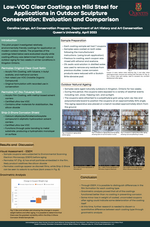 Volatile Organic Compounds are compounds that can enter the air from chemical application and have the potential to harm both people and the environment. The field of art conservation has recently been engaged in research to find more sustainable coatings and corrosion inhibitors for outdoor sculpture, and this project contributes to those efforts by investigating the efficacy of three clear coatings, including two that are labeled as Ultra-Low VOC (less than 50g/L produced). The three coatings investigated include Ship-2-Shore Corrosion Shield (calcium alkylsulfonate surfactant compound, ultra-low VOC), Permalac Clear Coat Satin (acrylic coating), and Permalac NT Satin (acrylic coating, ultra-low VOC). The sample size for each coating type was seven mild steel coupons, with the addition of an uncoated control group. Samples were naturally aged outdoors in winter conditions in Kingston Ontario for a period of two weeks. Gravimetric analyses were conducted in accordance with ASTM Standard G01 Standard Practice for Preparing, Cleaning, and Evaluating Corrosion Test Specimens; however a modified approach was used since there were only small amounts of corrosion produced on test specimens over the aging period. This study is intended to serve as a preliminary comparison and evaluation of the various coatings tested in order to assist conservators in making treatment material choices based on the requirements of their specific object. Although all coating types provided better protection for mild steel than no coating, the Ship-2-Shore Corrosion Shield appeared to have the highest variability in coating formation, warranting the need for further study.
Volatile Organic Compounds are compounds that can enter the air from chemical application and have the potential to harm both people and the environment. The field of art conservation has recently been engaged in research to find more sustainable coatings and corrosion inhibitors for outdoor sculpture, and this project contributes to those efforts by investigating the efficacy of three clear coatings, including two that are labeled as Ultra-Low VOC (less than 50g/L produced). The three coatings investigated include Ship-2-Shore Corrosion Shield (calcium alkylsulfonate surfactant compound, ultra-low VOC), Permalac Clear Coat Satin (acrylic coating), and Permalac NT Satin (acrylic coating, ultra-low VOC). The sample size for each coating type was seven mild steel coupons, with the addition of an uncoated control group. Samples were naturally aged outdoors in winter conditions in Kingston Ontario for a period of two weeks. Gravimetric analyses were conducted in accordance with ASTM Standard G01 Standard Practice for Preparing, Cleaning, and Evaluating Corrosion Test Specimens; however a modified approach was used since there were only small amounts of corrosion produced on test specimens over the aging period. This study is intended to serve as a preliminary comparison and evaluation of the various coatings tested in order to assist conservators in making treatment material choices based on the requirements of their specific object. Although all coating types provided better protection for mild steel than no coating, the Ship-2-Shore Corrosion Shield appeared to have the highest variability in coating formation, warranting the need for further study.
Jocelyn Hillier
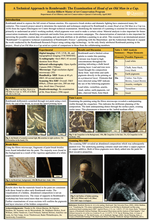 Rembrandt aimed to express the full extent of human emotion. His expressive brush strokes and dramatic lighting have enamoured many for centuries. This research project aims to determine the materials and techniques employed by Rembrandt to create Head of an Old Man in a Cap (ca. 1630) from the Agnes Etherington Art Centre through technical examination. Initial documentation was completed using Nikon studio cameras to capture the front, reverse, raking light, UV reflectance, and infrared reflectance. Further examinations were carried out using X-radiography, infrared reflectography (IRR) (Apollo), multi-spectral imaging (VSC8000), handheld X-ray fluorescence (p-XRF) spectroscopy (Bruker Tracer 5g), and macro-XRF (MA-XRF) (Bruker M6 Jetstream). The various analytical techniques provided insight into the pigments used by Rembrandt and the layer structure of the painting. The MA-XRF elemental maps revealed an abandoned composition rendered with paint rich in cobalt and copper. The results have been used to guide sampling locations to confirm the pigments and the layer structure of the hidden painting. The research is part of an international research project “Rembrandt? Co-operative technical examinations of Rembrandt's Tronies”, in partnership with the Mauritshuis in the Hague, Netherlands and the Ashmolean Museum in Oxford, England.
Rembrandt aimed to express the full extent of human emotion. His expressive brush strokes and dramatic lighting have enamoured many for centuries. This research project aims to determine the materials and techniques employed by Rembrandt to create Head of an Old Man in a Cap (ca. 1630) from the Agnes Etherington Art Centre through technical examination. Initial documentation was completed using Nikon studio cameras to capture the front, reverse, raking light, UV reflectance, and infrared reflectance. Further examinations were carried out using X-radiography, infrared reflectography (IRR) (Apollo), multi-spectral imaging (VSC8000), handheld X-ray fluorescence (p-XRF) spectroscopy (Bruker Tracer 5g), and macro-XRF (MA-XRF) (Bruker M6 Jetstream). The various analytical techniques provided insight into the pigments used by Rembrandt and the layer structure of the painting. The MA-XRF elemental maps revealed an abandoned composition rendered with paint rich in cobalt and copper. The results have been used to guide sampling locations to confirm the pigments and the layer structure of the hidden painting. The research is part of an international research project “Rembrandt? Co-operative technical examinations of Rembrandt's Tronies”, in partnership with the Mauritshuis in the Hague, Netherlands and the Ashmolean Museum in Oxford, England.
Rebecca Anne Clendinen
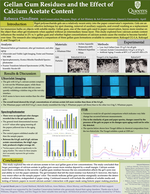 Rigid polysaccharide gels are a relatively recent entry into the paper conservator’s repertoire. Gels are an effective technique for spot cleaning, removal of auxiliary supports, and overall washing as a replacement for immersion baths on objects with soluble media. One of the main gels used in paper conservation, gellan gum leaves more residue on the object than other gel treatments when applied without an intermediary tissue layer. Calcium acetate affects the structural and mechanical properties of gellan gum. This study explored how calcium acetate content influences the residue in 2% w/v gellan gum and whether higher concentrations of calcium acetate cause the residue to become harmful over time. The research also integrated a comparison of three gellan gum formations available to conservators: Kelcogel F, Kelcogel CG-LA, and Ticagel L-6. The results were recorded using ultraviolet imaging, Fourier transform infrared spectrometer (FTIR), and color spectrophotometry. Measurements were taken before the gel application, after the samples dried, and after artificial aging. The results indicate calcium acetate concentration has little effect on the severity of gellan gum residues. This research supports the conclusions of prior literature stating calcium acetate facilitates the making of gellan gum. The research adds that as the calcium acetate concentration increases, it begins to hinder the gel’s even formation and hydration.
Rigid polysaccharide gels are a relatively recent entry into the paper conservator’s repertoire. Gels are an effective technique for spot cleaning, removal of auxiliary supports, and overall washing as a replacement for immersion baths on objects with soluble media. One of the main gels used in paper conservation, gellan gum leaves more residue on the object than other gel treatments when applied without an intermediary tissue layer. Calcium acetate affects the structural and mechanical properties of gellan gum. This study explored how calcium acetate content influences the residue in 2% w/v gellan gum and whether higher concentrations of calcium acetate cause the residue to become harmful over time. The research also integrated a comparison of three gellan gum formations available to conservators: Kelcogel F, Kelcogel CG-LA, and Ticagel L-6. The results were recorded using ultraviolet imaging, Fourier transform infrared spectrometer (FTIR), and color spectrophotometry. Measurements were taken before the gel application, after the samples dried, and after artificial aging. The results indicate calcium acetate concentration has little effect on the severity of gellan gum residues. This research supports the conclusions of prior literature stating calcium acetate facilitates the making of gellan gum. The research adds that as the calcium acetate concentration increases, it begins to hinder the gel’s even formation and hydration.
Tirza Harris
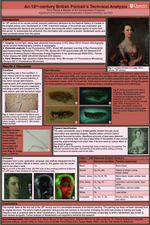 An 18th-century oil on canvas portrait received preliminary attribution by Stephen Gritt of the National Gallery of Canada (NGC). He connected the work to the English portrait painter John Vanderbank (1694—1739). A comprehensive technical analysis of the portrait was performed to create a technical profile of the work. This analysis was compared against literature and technical reports discussing artist’s materials and components typical of works from this period, to connect the work firmly to the 18th century. To substantiate Gritt’s hypothesis further, a comparative analysis of known works attributed to Vanderbank and his working contemporaries, housed at various global institutions, was made. Non-destructive analysis using a high magnification digital microscope, infrared reflectography (IRR), ultraviolet fluorescence photography (UVF), and x-radiography were used. Non-destructive analysis using the scanning XRF provided an overview of the elemental makeup on the painting’s surface. These results revealed the artist used pigments consistent with their period, including earth pigments, iron oxides, and lead-based pigments and ground. This information guided minimally invasive techniques that involved strategically sampling damaged areas. Techniques included examining cross-sections under polarised and fluorescent light to map the painting’s layers and materials, and using scanning electron microscopy – energy dispersive spectroscopy (SEM-EDS) to understand further layers’ components. The samples revealed the artist’s gradual build-up of red and brown grounds and a dry-on-dry application of paint and thin glazes. A lack of technical research into attributed Vanderbank portraits means the outcomes of this research were to establish the groundwork for future lines of inquiry into Vanderbank and his works.
An 18th-century oil on canvas portrait received preliminary attribution by Stephen Gritt of the National Gallery of Canada (NGC). He connected the work to the English portrait painter John Vanderbank (1694—1739). A comprehensive technical analysis of the portrait was performed to create a technical profile of the work. This analysis was compared against literature and technical reports discussing artist’s materials and components typical of works from this period, to connect the work firmly to the 18th century. To substantiate Gritt’s hypothesis further, a comparative analysis of known works attributed to Vanderbank and his working contemporaries, housed at various global institutions, was made. Non-destructive analysis using a high magnification digital microscope, infrared reflectography (IRR), ultraviolet fluorescence photography (UVF), and x-radiography were used. Non-destructive analysis using the scanning XRF provided an overview of the elemental makeup on the painting’s surface. These results revealed the artist used pigments consistent with their period, including earth pigments, iron oxides, and lead-based pigments and ground. This information guided minimally invasive techniques that involved strategically sampling damaged areas. Techniques included examining cross-sections under polarised and fluorescent light to map the painting’s layers and materials, and using scanning electron microscopy – energy dispersive spectroscopy (SEM-EDS) to understand further layers’ components. The samples revealed the artist’s gradual build-up of red and brown grounds and a dry-on-dry application of paint and thin glazes. A lack of technical research into attributed Vanderbank portraits means the outcomes of this research were to establish the groundwork for future lines of inquiry into Vanderbank and his works.
Ève L’Heureux
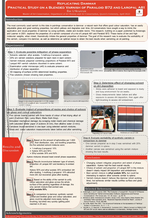 Based on a research conducted by Arslanoglu and Learner in 2001 analyzing the optical, chemical and aging properties of a varnish composed of a mix of Paraloid™B72 and Laropal®A81, the present study aimed at evaluating unexplored parameters in the use of this varnish, which was first designed as a stable substitute to dammar. The first step served to establish if the phase separation of the two resins noticed in the 2001 research could be mitigated by changing the solvents used and adjusting the proportion of each resin. The solvents selected were xylene, 1-methoxy-2-propanol, and ethyl acetate. Drops of varnish mixtures with predetermined proportions of each resin were examined under the microscope to evaluate phase separation and levelling properties. Changing the solvent proved to have, indeed, an effect on the miscibility of the two resins and mitigated phase separation. To assess if the solvents used could influence dirt deposition, the same slides were exposed to a busy, dirty environment for six weeks, and gloss measurements taken before and after showed which mixtures attracted or imbibed dust. Some tendencies were observed for specific mixtures, for example 1-methoxy-2-propanol 10% attracted more dirt but regained most of its gloss after a light dusting, indicating it does not imbibe dirt. For the third step, five varnish solutions showing the least phase separation, the smallest particles and the best levelling properties were selected and applied onto test panels mimicking damaged oil paintings. This served to establish the capacity of the selected varnish mixtures to unify gloss and colour saturation across a painting, despite damage. A glossmeter and a colour spectrophotometer were used to quantify the differences at this stage. Only one varnish mixture fulfilled both requirements, ethyl acetate 50%. Finally, the practical handling characteristics of the selected synthetic varnish mixture was compared to dammar by varnishing two test canvases, one for each varnish. The flow, drying rate and the possibility to adjust gloss while brushing were qualitatively evaluated and compared. It showed that the synthetic varnish, even if its handling properties were different than dammar, allowed to achieve similar effects. The results gathered with this research contributed to assess this varnish’s efficiency, its similarity to dammar and to develop an optimal method for its use in art conservation practice.
Based on a research conducted by Arslanoglu and Learner in 2001 analyzing the optical, chemical and aging properties of a varnish composed of a mix of Paraloid™B72 and Laropal®A81, the present study aimed at evaluating unexplored parameters in the use of this varnish, which was first designed as a stable substitute to dammar. The first step served to establish if the phase separation of the two resins noticed in the 2001 research could be mitigated by changing the solvents used and adjusting the proportion of each resin. The solvents selected were xylene, 1-methoxy-2-propanol, and ethyl acetate. Drops of varnish mixtures with predetermined proportions of each resin were examined under the microscope to evaluate phase separation and levelling properties. Changing the solvent proved to have, indeed, an effect on the miscibility of the two resins and mitigated phase separation. To assess if the solvents used could influence dirt deposition, the same slides were exposed to a busy, dirty environment for six weeks, and gloss measurements taken before and after showed which mixtures attracted or imbibed dust. Some tendencies were observed for specific mixtures, for example 1-methoxy-2-propanol 10% attracted more dirt but regained most of its gloss after a light dusting, indicating it does not imbibe dirt. For the third step, five varnish solutions showing the least phase separation, the smallest particles and the best levelling properties were selected and applied onto test panels mimicking damaged oil paintings. This served to establish the capacity of the selected varnish mixtures to unify gloss and colour saturation across a painting, despite damage. A glossmeter and a colour spectrophotometer were used to quantify the differences at this stage. Only one varnish mixture fulfilled both requirements, ethyl acetate 50%. Finally, the practical handling characteristics of the selected synthetic varnish mixture was compared to dammar by varnishing two test canvases, one for each varnish. The flow, drying rate and the possibility to adjust gloss while brushing were qualitatively evaluated and compared. It showed that the synthetic varnish, even if its handling properties were different than dammar, allowed to achieve similar effects. The results gathered with this research contributed to assess this varnish’s efficiency, its similarity to dammar and to develop an optimal method for its use in art conservation practice.
Katharyn Hernández
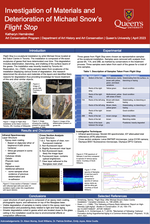 Toronto Art Restoration, Inc. (TARI) treated the 60 geese which make up Michael Snow’s installation, Flight Stop, at the Eaton Centre in Toronto, Ontario. The geese are composed of Styrofoam, fiberglass, photograph collages, and resin coatings. Flight Stop remains installed under a glass ceiling, where it has undergone deterioration in the form of delamination, chalking, and blanching. In this study, the chemical processes these materials have undergone were investigated to aid in finding ways to prevent further degradation of the coatings. Analytical investigation was undertaken to determine the composition of the coatings and degradation products, to aid in identification and treatment of the issues associated with this degradation. Adverse interactions between materials were considered as well as degradation of individual layers. The analytical techniques used were cross-section analysis, Fourier-transform infrared spectroscopy (FTIR), and environmental scanning electron microscopy coupled with energy-dispersive X-ray Spectroscopy (ESEM-EDS). Degradation was mainly noted in the epoxy resin coating layer and is explained by degradation mechanisms related to heat and light, particularly yellowing and blanching that occurs in the presence of UV radiation. Geese hung closer to the glass ceiling experienced greater deterioration overall, showing higher incidence of blanching and chalking. A difference in composition of the epoxy resin coating layer was also noted in the samples from the more degraded goose, indicating the addition of silica in this sample as compared to other samples. This could have contributed to the deterioration of this layer; further research would be necessary to determine the validity of these claims.
Toronto Art Restoration, Inc. (TARI) treated the 60 geese which make up Michael Snow’s installation, Flight Stop, at the Eaton Centre in Toronto, Ontario. The geese are composed of Styrofoam, fiberglass, photograph collages, and resin coatings. Flight Stop remains installed under a glass ceiling, where it has undergone deterioration in the form of delamination, chalking, and blanching. In this study, the chemical processes these materials have undergone were investigated to aid in finding ways to prevent further degradation of the coatings. Analytical investigation was undertaken to determine the composition of the coatings and degradation products, to aid in identification and treatment of the issues associated with this degradation. Adverse interactions between materials were considered as well as degradation of individual layers. The analytical techniques used were cross-section analysis, Fourier-transform infrared spectroscopy (FTIR), and environmental scanning electron microscopy coupled with energy-dispersive X-ray Spectroscopy (ESEM-EDS). Degradation was mainly noted in the epoxy resin coating layer and is explained by degradation mechanisms related to heat and light, particularly yellowing and blanching that occurs in the presence of UV radiation. Geese hung closer to the glass ceiling experienced greater deterioration overall, showing higher incidence of blanching and chalking. A difference in composition of the epoxy resin coating layer was also noted in the samples from the more degraded goose, indicating the addition of silica in this sample as compared to other samples. This could have contributed to the deterioration of this layer; further research would be necessary to determine the validity of these claims.
Robin Langmuir
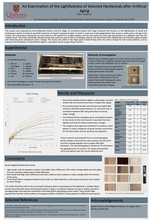 This study was proposed by Anne-Stéphanie Etienne and Eric Hagan at the Canadian Conservation Institute to contribute toward their larger research on the lightfastness of wood and developing a system to improve wood fill treatment. This study specifically selected hard woods that could be used as fills for mahogany objects and determined their lightfastness by artificially aging samples and measuring their subsequent colour change. All woods were uncoated, with the exception of one sample which was finished with a pigmented shellac coating. Samples were aged in the Q-SUN Xenon Test Chamber at Queen’s University for 504 hours. Colour changes were measured with the Spectrophotometer CM 700d using the CIE L*a*b* colour system. All samples were found to lighten over time, with light-to-orange woods experiencing the smallest overall colour changes and the earliest plateaus in colour change. None of the dark woods sampled here reached a plateau during this experiment; however, several of the dark woods were found to be the most lightfast. The best performing sample was the finished African mahogany. It was both the most lightfast and the most resilient to colour change. These results aide in the larger goal of determining feasibility of using different aged or ‘pre-faded’ woods as gap filling materials.
This study was proposed by Anne-Stéphanie Etienne and Eric Hagan at the Canadian Conservation Institute to contribute toward their larger research on the lightfastness of wood and developing a system to improve wood fill treatment. This study specifically selected hard woods that could be used as fills for mahogany objects and determined their lightfastness by artificially aging samples and measuring their subsequent colour change. All woods were uncoated, with the exception of one sample which was finished with a pigmented shellac coating. Samples were aged in the Q-SUN Xenon Test Chamber at Queen’s University for 504 hours. Colour changes were measured with the Spectrophotometer CM 700d using the CIE L*a*b* colour system. All samples were found to lighten over time, with light-to-orange woods experiencing the smallest overall colour changes and the earliest plateaus in colour change. None of the dark woods sampled here reached a plateau during this experiment; however, several of the dark woods were found to be the most lightfast. The best performing sample was the finished African mahogany. It was both the most lightfast and the most resilient to colour change. These results aide in the larger goal of determining feasibility of using different aged or ‘pre-faded’ woods as gap filling materials.
2021-2022
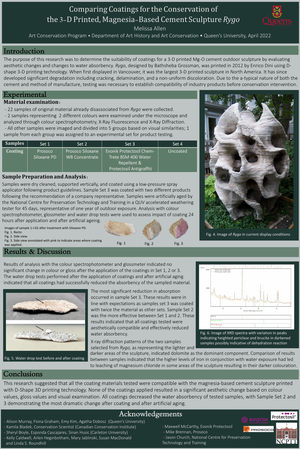 Melissa Allen
Melissa Allen
The large-scale concrete sculpture Rygo, by artist Bathsheba Grossman, was 3D printed in 2012 using magnesia-based cement. Now privately owned, Rygo is displayed outdoors and suffering severe cracking and delamination. Due to the unique combination of an atypical cement and the 3-D printing process, there is currently no literature to draw upon concerning which conservation materials might effectively be used to slow the deterioration of the sculpture. Previous research shows that the application of a coating material could be beneficial. To determine which coating material is most compatible, samples from the sculpture that had already become disassociated from the whole were used for this research. The samples were imaged, examined under the microscope, and analyzed with x-ray fluorescence spectroscopy (XRF) and x-ray diffraction (XRD). Coatings from Evonik Protectosil and Prosoco were evaluated. Visual changes were assessed using a handheld colour spectrophotometer and glossmeter. Changes to porosity were assessed with a water drop test. Samples were evaluated before and after application of the coatings, as well as after artificial aging at the National Center for Preservation Technology and Training (NCPTT) in a QUV accelerated weathering tester for 45 days, the industry standard to represent one year of outdoor exposure. This research indicated that all silane and siloxane-based water repellant coatings were appropriate for application to magnesia cement, 3-D printed concrete structures thereby increasing the chances that Rygo will be appreciated for years to come.
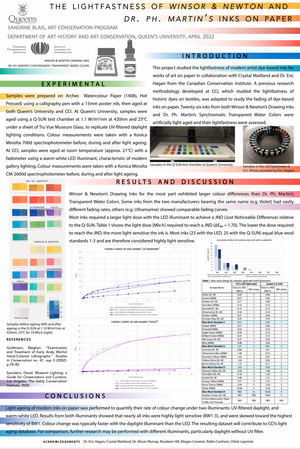 Sandrine Blais
Sandrine Blais
Synthetic dye-based inks have been used by artists since their invention in the 19th century. They have been greatly appreciated for their high tinctorial strength and colour brilliance but are known to be fugitive. Winsor and Newton’s drawing inks were first sold in the 1890s and Dr. Ph. Martin’s Synchromatic Transparent Water Colours in 1934. Both lines of inks can still be purchased today by artists. This project studied the lightfastness of these modern artist dye-based inks for works of art on paper. Jennifer Poulin and Eric Hagan from the Canadian Conservation Institute developed a methodology using a custom fadometer to study the lightfastness of historic dyes on textiles. That same methodology was adapted to study the fading of dye-based inks on paper. Dye-based inks are advertised by the manufacturers as not being lightfast, as opposed to pigment-based inks that they also sell. Inks from both Winsor and Newton’s Drawing Inks and Dr. Ph. Martin’s Synchromatic Transparent Water Colors were tested. Samples were prepared on Arches Hot Pressed watercolour paper (140lbs) using a wide calligraphy nib. Light ageing was achieved at both Queen’s University in a Q-SUN test chamber with an arc xenon lamp and UV filter, and at CCI in a custom fadometer with a warm-white LED. Colour measurements were taken with a colour spectrophotometer before, during and after light ageing. Results from illumination sources were compared. Results from both illuminants showed that nearly all inks were highly light sensitive, a large amount of them being in the highest sensitivity category of
blue wool standard 1. Colour change was typically faster with the daylight illuminant than the LED. This study helped expand CCI’s lightfastness dataset.
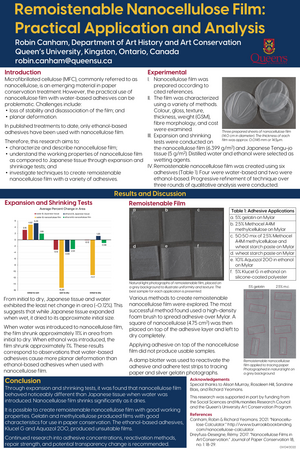 Robin Canham
Robin Canham
Microfibrillated cellulose (MFC), commonly referred to as nanocellulose, is an emerging material in the conservation field. Due to its properties of transparency and high mechanical strength, nanocellulose film offers novel potential in paper conservation when Japanese tissue may not be suitable for use in treatments. However, the reaction of nanocellulose film to the direct application of water is particularly different to that of Japanese tissue. When water or aqueous adhesives are applied to nanocellulose, the wet film loses stability and becomes pulpy, making practical use problematic. Additionally, nanocellulose film can shrink upon drying, causing planar deformation. For these reasons, adhesives used with nanocellulose are limited in published treatments to date.
Remoistenable tissue has been used in paper conservation for many years as a standard material for mending and lining damaged paper objects, especially those that are moisture sensitive. Therefore, the possibility to create remoistenable nanocellulose film using an established methodology may hold promise. This research examines the potential of using nanocellulose film in a remoistenable form and aims to build upon current understanding of how nanocellulose film reacts when water and ethanol are introduced, through expansion and shrinking tests.
Results demonstrated that the nanocellulose film used in this study behaved considerably different than the Japanese tissue when water was introduced. Practical techniques are also recommended to create remoistenable nanocellulose film with a selection of adhesives. Notably, films created with 2.5% Methocel® A4M methylcellulose and 5% gelatin showed promising initial results.
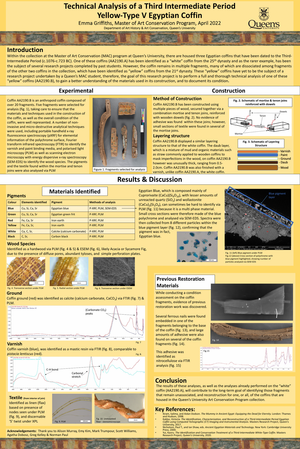 Emma Griffiths
Emma Griffiths
Within the collection at the Master of Art Conservation (MAC) program at Queen’s University, there are housed three Egyptian coffins that have been dated to the Third-Intermediate Period (c.1076-c.723 BC). One of these coffins (AA2190.A) has been identified as a “white” coffin from the 25th dynasty and as the rarer example, has been the subject of several research projects completed by past students. However, the coffin remains in multiple fragments, many of which are dissociated among fragments of the other two coffins in the collection, which have been identified as “yellow” coffins from the 21st dynasty. These “yellow” coffins have yet to be the subject of a research project undertaken by a Queen’s MAC student, therefore, the goal of this research project was to perform a full and thorough technical analysis of one of these “yellow” coffins (AA2190.B), to gain a better understanding of the materials used in its construction, and
to document its condition. The goal was that this analysis would yield information that may make it possible to differentiate between the remaining fragments that cannot be identified via surface decoration or morphology alone. A number of non-invasive and micro destructive analytical techniques were used, including portable handheld x-ray fluorescence spectroscopy (pXRF) for elemental information of the polychrome surface, Fourier transform infrared spectroscopy with attenuated total reflectance (FTIR-ATR) to identify the varnish and paint binding media, x-ray diffraction (XRD) to characterize the daub layer, and polarised light microscopy (PLM) as well as environmental scanning electron microscopy with energy dispersive x-ray spectroscopy (ESEM-EDS) to identify the wood species used for the coffin. Scanning electron microscopy and PLM were also used to further characterise the pigments used in the polychrome of the coffin. The wood was found to be a hardwood, most likely Moraceae Ficus Sycomorus L., and the ground layer to be calcium carbonate. The pigments were found to be consistent with those commonly used during the Third Intermediate Period, and the yellow and black varnishes were identified as Pistacia resin and bitumen respectively. Analysis of the binding medium was found to be inconclusive.
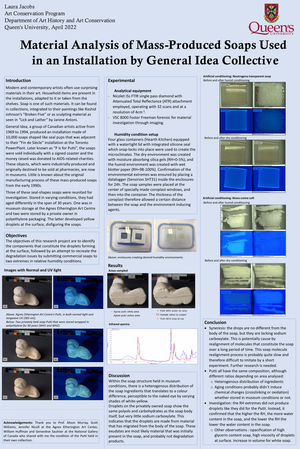 Laura Jacobs
Laura Jacobs
General Idea, a group of Canadian artists active from 1969 to 1994, produced an installation made of 10,000 soaps shaped like seal pups. Later known as Putti, these soaps were then sold and the money raised was donated to AIDS-related charities. These objects, which were industrially produced and originally destined to be sold at pharmacies, are now in museums and private collections. Little is known about the original manufacturing process of these mass-produced soaps from the early 1990s. This project studied three of the objects that have been stored in two different environments for nearly three decades. The soap items showed different rates of degradation. These issues present themselves by the formation of droplets, yellowing, and crystallization patterns that visually disrupted the surface of the soaps. Fourier-transform infrared (FTIR) analysis, colour spectrophotometry and X-ray fluorescence (XRF) spectroscopy were used to characterize the objects and their degradation products. Results indicate that the droplets forming at the surface of the items was probably due to syneresis. Alongside this characterization of the General Idea items, a similar study of commercial soap bars was instigated. Additionally, two of the commercial soap coupons were exposed to different environments with the aim of understanding the impact of high and low relative humidity on them. Results of this second part of the research project show a correlation between the humidity content in the environment and within the soap body. Preventive guideline strategies were then devised from the results, which are applicable to the care of collections containing sculptures and carvings made of soap.
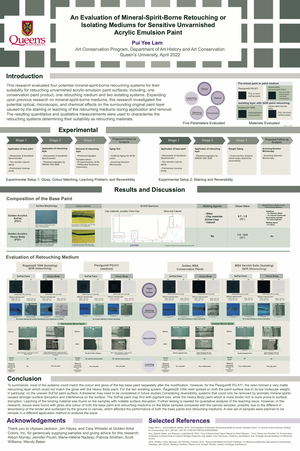 Pui Yee Lam
Pui Yee Lam
This research evaluated four potential mineral-spirit-borne retouching systems for their suitability for retouching unvarnished acrylic emulsion paint surfaces. Golden MSA Conservation Paint was tested directly on acrylic paint surfaces, while the resin, Plexigum® PQ 611, was tested mixing with pigment; and one varnish and one resin, Golden MSA Varnish with Satin and Regalrez® 1094, were applied as an isolating layer for water-based retouching on top. Expanding upon previous research on mineral-spirit-borne mediums, this research investigated the potential optical, microscopic, and chemical effects on the surrounding original paint layer caused by the staining or leaching of the retouching mediums during application and removal. Two acrylic emulsion paint products, the Golden Acrylics SoFlat and Golden Acrylics Heavy Body, were chosen as the base paint because of their significant difference in surface gloss. In this research, the components of the two products contributing to the different in gloss were first accounted for and then five properties of the retouching mediums were evaluated: gloss, color, staining (during application), leaching (after removal), and reversibility. Two different experiments were designed to test these properties. The first set of experiments evaluated ease of matching the surface characteristics of gloss and color. The retouching systems were then tested for reversibility and impact of solvents on the original paint layer. The second set of experiments focused on staining behavior during application and techniques for mitigating this phenomenon. Analytical methods used for the research included gloss measurements, color measurements, photomicrographs, analysis of cross-section samples under the stereomicroscope, and attenuated total reflectance-Fourier transform infrared spectroscopy (ATR-FTIR). The resulting semi-quantitative and qualitative measurements were used to determine their suitability as retouching materials. The results identified that the system of using a mineral-spirit-borne isolation layer with water-based retouching or Golden MSA conservation paint could achieve a “knocking back” effect for retouching both the Heavy Body and SoFlat paint but required modification with matting agents. The Plexigum retouching had a particular low gloss, which was suitable for retouching the SoFlat paint. The low molecular weight and viscosity resin Regalrez® 1094 was found to have significant spreading on this type of acrylic matte paint. Thickening agents may need to be considered in future studies. Considering reversibility, systems that could only be removed by aromatic mineral spirits caused stronger surface disruption. For this experiment, ATR-IR spectroscopy identified a low, trace amount of binder material from the base paint, detected from the swab removing the retouching layer. However, there was no noticeable amount of leached surfactant detected. Differential scanning calorimetry (DSC) and scanning electron microscopy analysis was suggested to be done in experimental setup 3 which was designed to modify the testing parameters in the future.
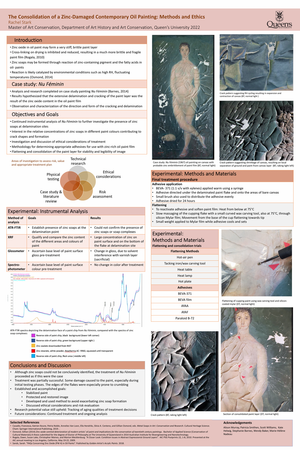 Rachel Stark
Rachel Stark
Zinc oxide has been incorporated into oil paints since the 19th century, initially used in commercial applications followed by the adoption of zinc white into artist’s materials in the 1900s. The zinc oxide content in oil paint has been associated with the deterioration of paintings, with in-depth research into the chemical and physical aging processes examining the pathways of damage. Conservation issues include the formation and effects of zinc soaps and the physical drying processes of zinc oxide in oil paint resulting in brittle paint films. These have led to questions surrounding the long-term effects of even the most basic conservation treatments. The 1967 oil painting Nu Féminin, by Canadian artist Jori Smith, is an example of a mid-century painting exhibiting severe deterioration. Showing overall delamination of the paint layers from the ground and support structure, Nu Féminin has undergone extensive analysis to investigate the cause of the damage. High levels of zinc found at the delamination interface as well as within the paint layers has been hypothesized as the leading cause of the deterioration. This research examines the practical aspects of treating a fragile and delaminating paint film, such as deciding upon appropriate adhesives and application methods, while also probing the ethical considerations a conservator must balance regarding intervention. In addition, the documented treatment of a work of art with known zinc oil paint content will add to the greater body of research on the long and short-term effects of materials and methods relating to similar paint structures.
Cracking and delamination of the paint layer similar to others with high concentrations of zinc within the paint layer, as well as continued FTIR analysis of the paint film and delamination interface confirmed that zinc within the oil paint was likely the major cause of the paint cleavage and delamination. The final procedure for flattening and consolidating the paint layer eschewed the use of water, relying on heat alone to soften the paint film, gentle heated pressure to press the cupping paint flat, and to reactivate previously applied BEVA 371, resulting in a passable final consolidation outcome.
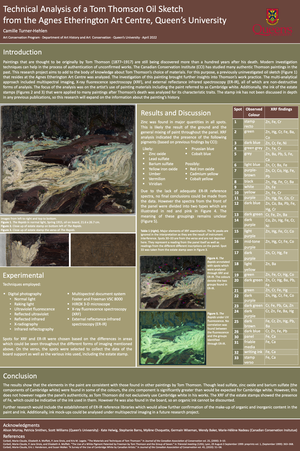 Camille Turner-Hehlen
Camille Turner-Hehlen
Artworks that are thought to be by Tom Thomson (1877–1917) are still being discovered more than a hundred years after his death. Unfortunately, the reliability of these paintings’ provenance, which would help authenticate them, varies. Modern investigation techniques can help fill in the gaps remaining in the documentation. The Canadian Conservation Institute (CCI) has studied many authentic Thomson paintings in the past; the technical knowledge gained through these investigations has been used to assess newly discovered works. This research project adds to the body of knowledge about Tom Thomson’s choice of materials. For this purpose, a previously uninvestigated oil sketch that resides at the Agnes Etherington Art Centre was analyzed. The investigation of this painting brings further insights into Thomson’s work practice, determining how consistent it is across his paintings. The multi-analytical approach employed includes ultraviolet fluorescence imaging, infrared reflectography (IRR), X-radiography, X-ray fluorescence spectroscopy (XRF) and external reflectance infrared spectroscopy (ER-IR), all of which are non-destructive forms of analysis. Particular attention was given to the artist’s use of painting materials including the paint referred to as “Cambridge white,” formerly “Freeman’s white.” Additionally, the ink used for the estate stamp that was applied to many paintings after Thomson’s death was analyzed for its characteristic traits. These have not been discussed in depth in any previous publications, so this research expands on the information about the painting’s history.
2020-2021
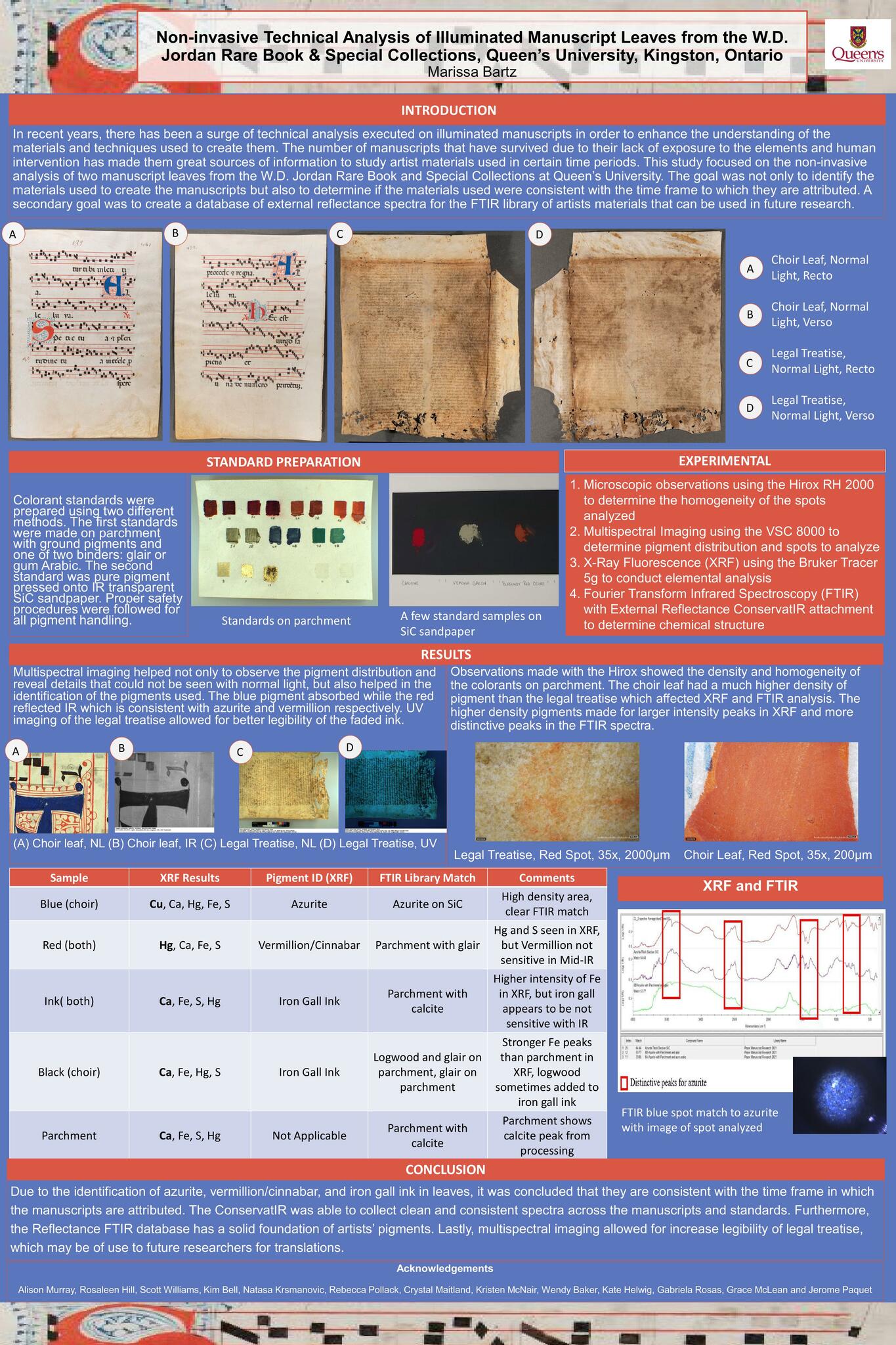 Marissa Bartz
Marissa Bartz
In recent years there has been a surge of technical analyses applied to the understanding and evaluation of illuminated manuscripts. Due to the sheer volume and lack of exposure to the elements or human intervention, illuminated manuscripts make excellent sources of artists’ materials and techniques. This research was a collaboration with the other second-year paper conservation students at Queen’s University to examine eight manuscript leaves from the W.D Jordan Rare Book and Special Collections at Queen’s University. The manuscript leaves were donated to the Special Collections in 2016 from one donor. However, the leaves come from a variety of manuscripts thus potentially have a wide range of artists’ materials and techniques. One of the main questions that this study answers is whether the pigments, binders, and techniques used are consistent with the time frame to which they are attributed. The dates of the leaves range from the 13th to the 16th century. This study focused on the analysis of two of the leaves that included a choir leaf and a possible Italian legal treatise. They were analyzed using only non-invasive techniques including x-ray fluorescence spectroscopy (XRF), external reflectance infrared spectroscopy (ER-IR), and multi-spectral imaging with the VSC 8000. These analytical techniques complemented one another well with XRF providing elemental data, ER-IR giving more information on functional groups and organic materials, and finally multispectral imaging showcasing underdrawings as well as the overall distribution of pigments. In addition to the technical analysis of the leaves, standards were made of known pigments and binders (gum Arabic and egg white) that were commonly used in the time of the manuscripts’ creation. These standards were examined using the same analytical instruments as the leaves for reference material This project not only expanded the understanding of manuscript materials and techniques, but also gave the Jordan Special Collections valuable information about the objects in their collections that they can now share with future researchers. Some of the artists’ materials identified were azurite, vermillion, and iron gall ink, which are consistent with the late medieval period. Additionally, UV imaging was able to make legible the faded text on the legal treatise thus allowing for future translation.
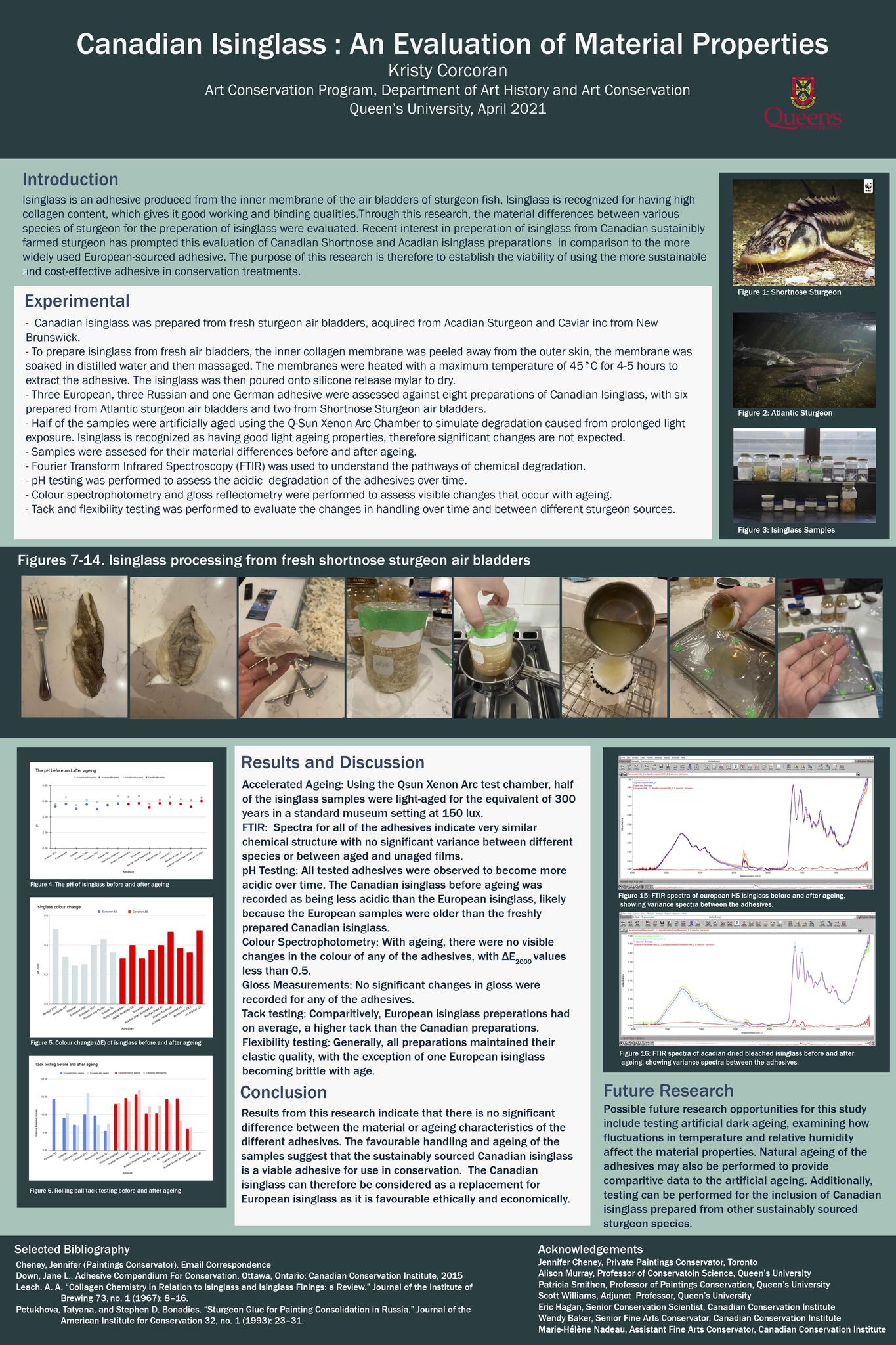 Kristy Corcoran
Kristy Corcoran
Russian isinglass is a highly celebrated adhesive, known for its excellent material and ageing properties. Often used in conservation, isinglass is prepared from the inner membrane of the air bladder of the sturgeon fish, traditionally sourced from Russia or other European countries. This adhesive has, however, become increasingly difficult to find and more expensive as the European sturgeon species are critically endangered. As a result, Russian isinglass has begun to fall out of favour compared with the more easily accessible cellulose-based or synthetic adhesives. There is, therefore, a growing interest in the possibility of using a different species of sturgeon for the continued use of isinglass in conservation. Through this research, sustainably sourced Canadian isinglass (fresh isinglass preparations from both Acadian and Shortnosed sturgeon species) was compared to six preparations of European isinglass (two Russian samples, one German and three listed only as European). Working and mechanical properties were evaluated by testing for flexibility and tack of the samples. Samples were artificially aged using Xenon arc bulb exposure to understand the degradation of aged samples. Analysis of samples before and after ageing was performed using Fourier transform infrared (FTIR) spectroscopy, colour spectrophotometry, gloss measurements, and pH testing. Results of this research indicated that Canadian isinglass had similar ageing characteristics to the European isinglass, with comparable results for all of the tests performed. It is therefore concluded that the more sustainable Canadian isinglass can be used as a viable replacement for European isinglass.
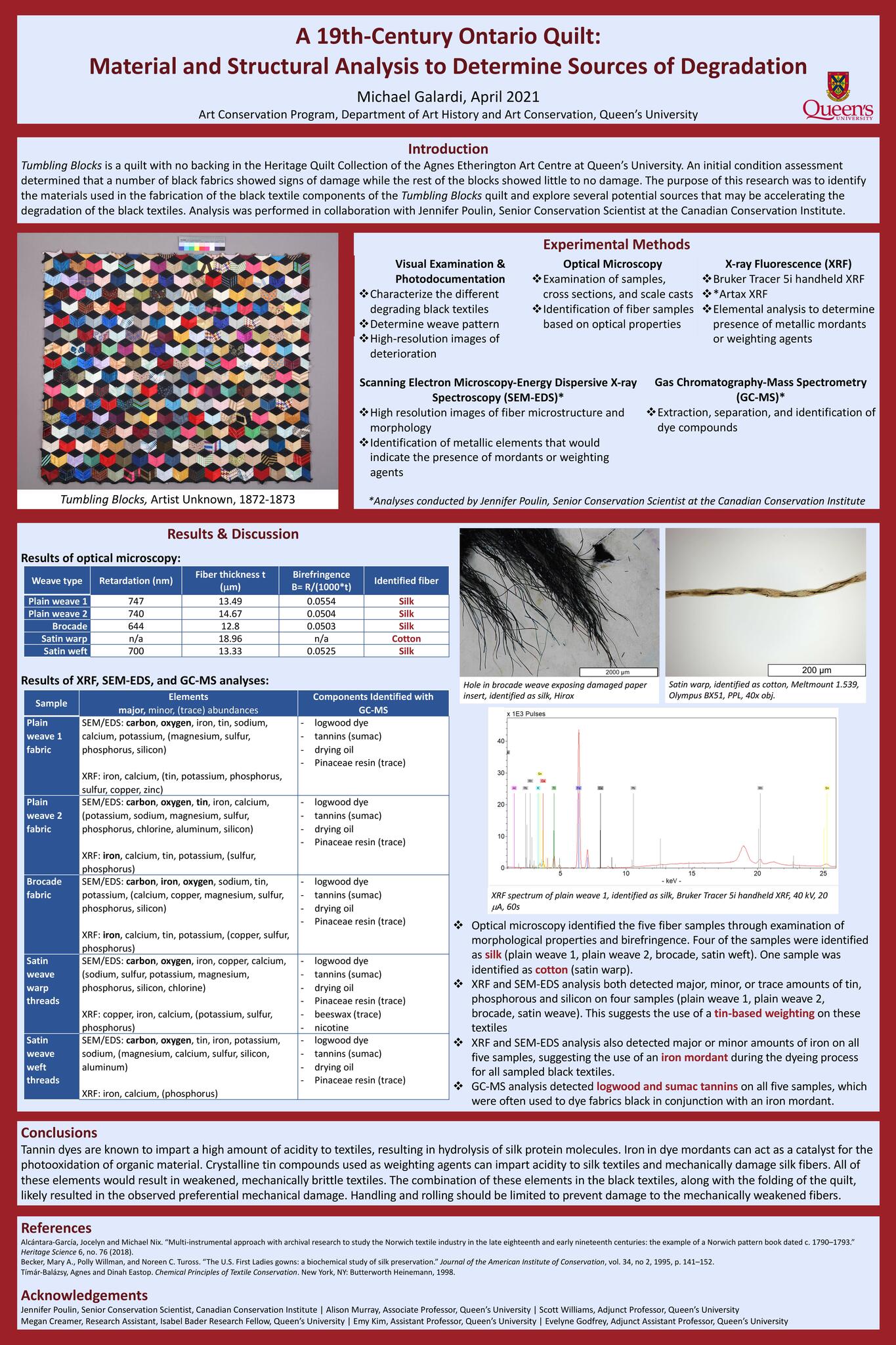 Michael Galardi
Michael Galardi
This research project was an analysis of a 19th-century quilt titled Tumbling Blocks from the Heritage Quilt Collection at the Agnes Etherington Art Centre. The main goals of this research were the identification of deteriorating black textile fibers along the fold lines in the quilt and analysis of fiber samples to identify any mordants, dyes, or weighting agents that may be contributing to the degradation of the black textiles in the quilt. An initial condition assessment identified components of the quilt that are suffering from degradation. A Hirox microscope characterized and documented the different damaged textile pieces. Polarized light microscopy was used to characterize and identify the deteriorating fibers. Infrared spectroscopy complemented the identification results. Scanning electron microscopy with energy dispersive X-ray spectroscopy and X-ray fluorescence spectroscopy were used to identify inorganic compounds in the fibers. Organic analysis of the textiles was carried out using gas chromatography-mass spectrometry. This identified components of the dyes used in the production of the black textiles. The results of this research determined possible sources for the preferential damage to the black textile components of the quilt, including iron mordants, tannin dyes, and tin weighting. Based on these findings, preventive conservation measures were recommended, including flat storage and decreased light levels when on display.
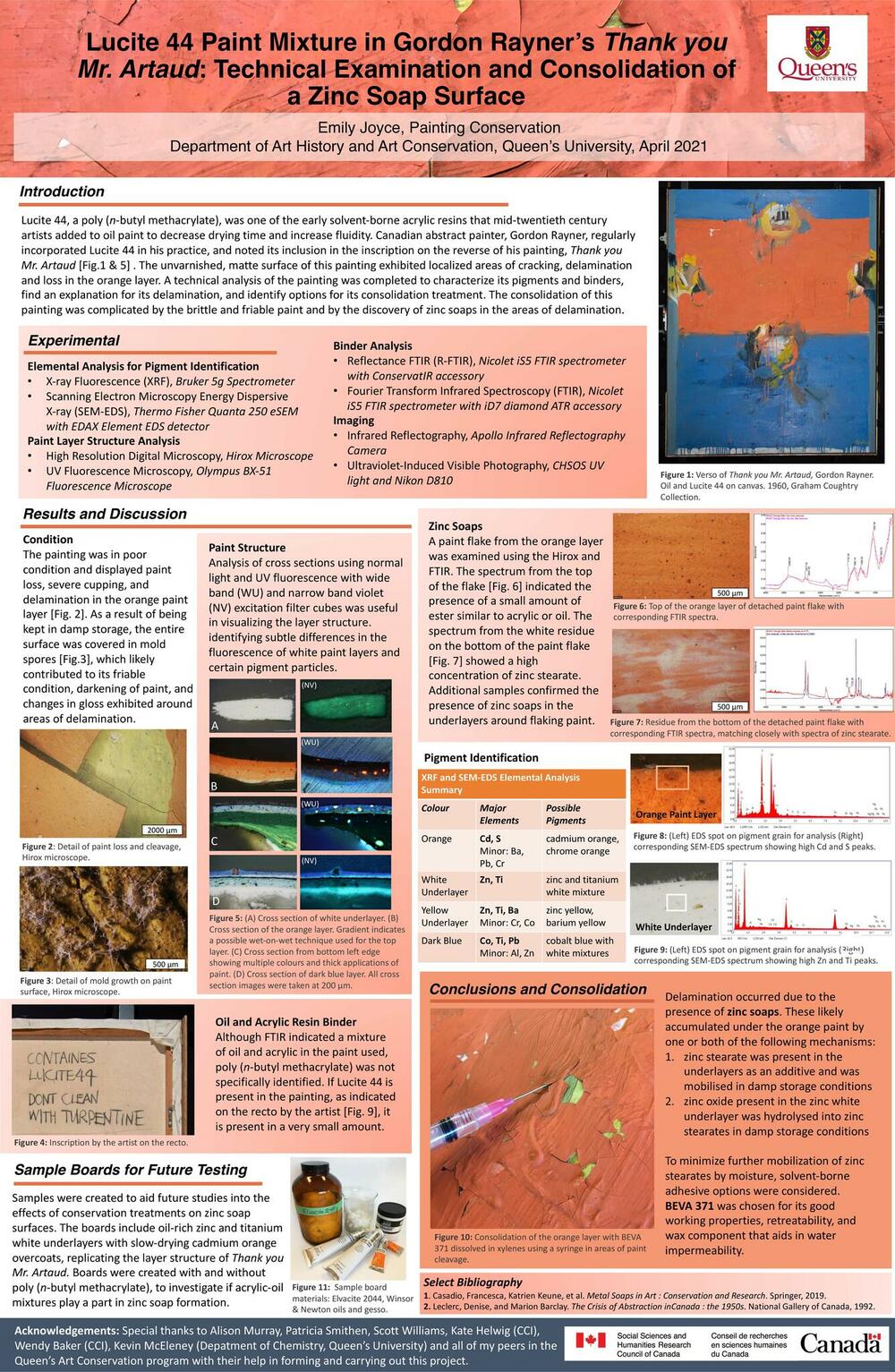 Emily Joyce
Emily Joyce
Lucite 44, a poly (n-butyl methacrylate), was one of the early solvent-borne acrylic resins that mid-twentieth century artists added to oil paint to decrease drying time and increase fluidity. Canadian abstract painter, Gordon Rayner, regularly incorporated Lucite 44 into his practice, and noted its inclusion in the inscription on the reverse of his painting, Thank you Mr. Artaud. The unvarnished, matte surface of this painting exhibited localized areas of cracking, delamination and loss in the orange layer. A technical analysis of the painting was completed to characterize its pigments and binders, find an explanation for its delamination, and identify options for its consolidation treatment. The consolidation of this painting was complicated by the brittle and friable paint, and by the discovery of zinc soaps in areas of delamination. Paint samples and cross sections from the painting were examined using high resolution digital microscopy, ultraviolet fluorescence microscopy, x-ray fluorescence spectroscopy, attenuated total reflectance Fourier transform infrared spectroscopy, external reflectance infrared spectroscopy, and scanning electron microscopy energy dispersive x-ray spectroscopy to gather information on the painting’s layered structure and chemical composition. Microscopic analysis of the paint structure highlighted Rayner’s working process, while pigment analysis showed that the main pigments in areas of flaking were cadmium orange and zinc white. The discovery of zinc soaps through binder analysis informed the painting’s consolidation treatment and inspired the creation of sample boards using poly (n-butyl methacrylate) and oil paint mixtures for future study of delamination due to zinc soaps in Lucite 44 paint mixtures.
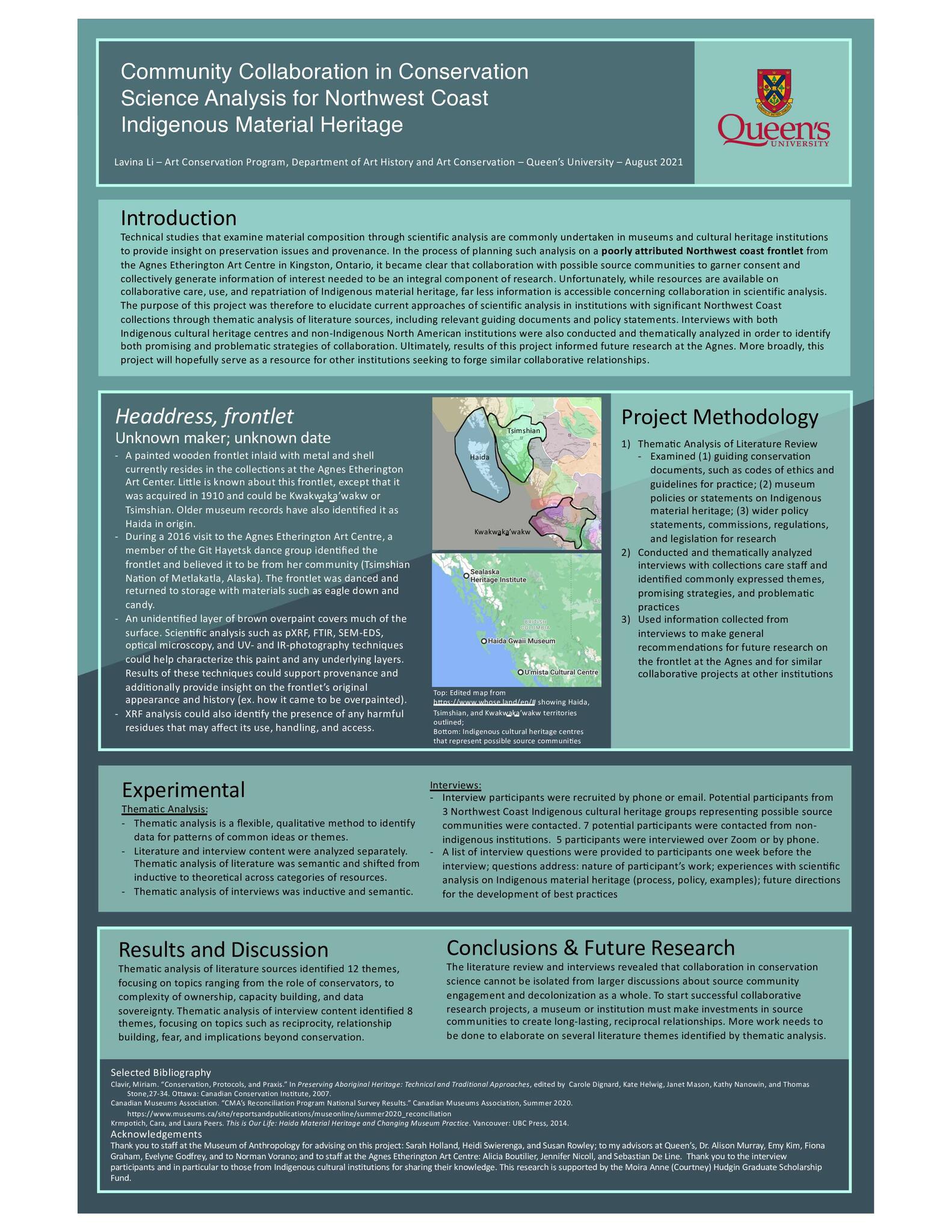 Lavina Li
Lavina Li
Technical studies that examine material composition through scientific analysis are commonly undertaken in museums and cultural heritage institutions to provide insight on preservation issues and provenance. In the process of planning such analysis on a poorly attributed Northwest coast frontlet from the Agnes Etherington Art Centre, it became clear that collaboration with possible source communities to garner consent and collectively generate information of interest needed to be an integral component of research. Unfortunately, while resources are available on collaborative care, use, and repatriation of Indigenous material heritage, far less information is accessible concerning collaboration in scientific analysis. For example, many museums have published their repatriation policies online, but policies, case studies, or reports that discuss collaboration in scientific analysis is sparse. The purpose of this project was therefore to elucidate current approaches of scientific analysis in institutions with significant Northwest Coast collections. This was done in two phases using thematic analysis. Firstly, guiding conservation documents and relevant museum literature were examined. Secondly, interviews with both non-Indigenous North American institutions and Indigenous cultural heritage centres were conducted in order to identify promising and problematic strategies of collaboration. Ultimately, results of thematic analysis showed that collaborative research is just one part of the complex, expansive area of community engagement and cannot be discussed in isolation from other issues surrounding decolonization. Results of this project informed future research at the Agnes, and, more broadly, will serve as a resource for other institutions seeking to forge similar collaborative relationships.
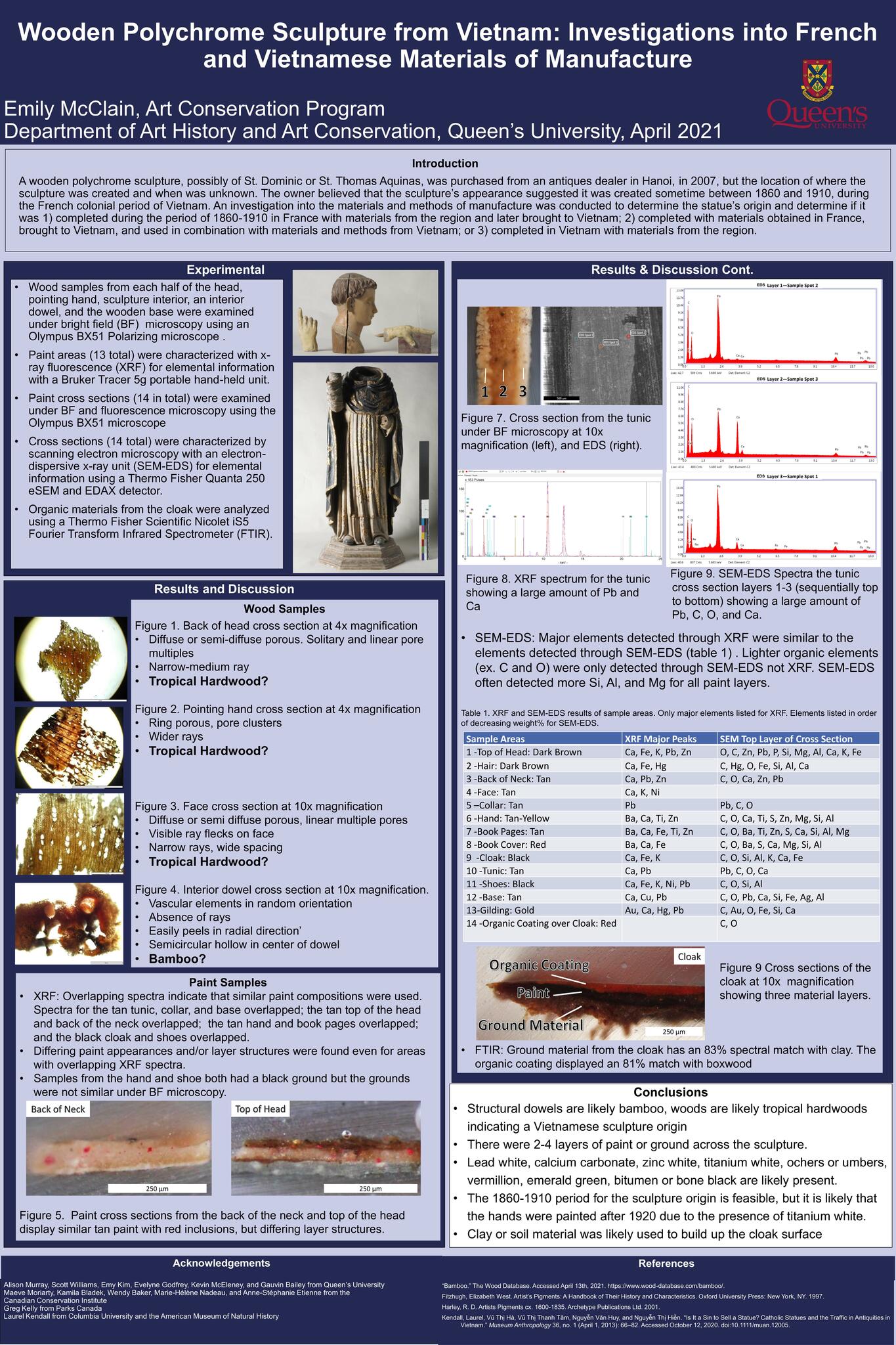 Emily McClain
Emily McClain
This research project investigated the origins of a wooden polychrome sculpture of St. Dominic or St. Thomas Aquinas. The sculpture was purchased in Vietnam but was thought to have French origins and been created any time from 1860-1910, aligning with the French colonial period of Vietnam. The goal of this research was to determine whether the sculpture was: 1) completed during the period of 1860-1910 in France with materials from the region and later brought to Vietnam; 2) completed with materials obtained in France, brought to Vietnam, and used in combination with materials and methods from Vietnam; or 3) completed in Vietnam with materials from the region. Nondestructive, non-contact X-ray fluorescence spectroscopy (XRF) was used for preliminary elemental analysis of unique paint colors to guide sample taking for the techniques that followed. Bright field microscopy was used to determine the species of the wood and bright field and fluorescence microscopy were used to investigate the layering of the paints used in the sculpture. The paints were then analyzed by XRF to determine the elemental compositions of pigments. Fourier transform infrared spectroscopy (FT-IR) was used to identify organic materials in a coating covering the cloak, and preparation layer under the cloak. Results of the chemical compositions of the pigments and organic materials were verified with scanning electron microscopy-electron dispersive x-ray spectroscopy (SEM-EDS) analysis. Species of the wooden dowels included in the sculpture were tentatively identified as bamboo indicating the materials at least in part were likely harvested in or near Vietnam. The identification of pigments and organic materials was found consistent with historic materials used in both France and Vietnam during this time period.
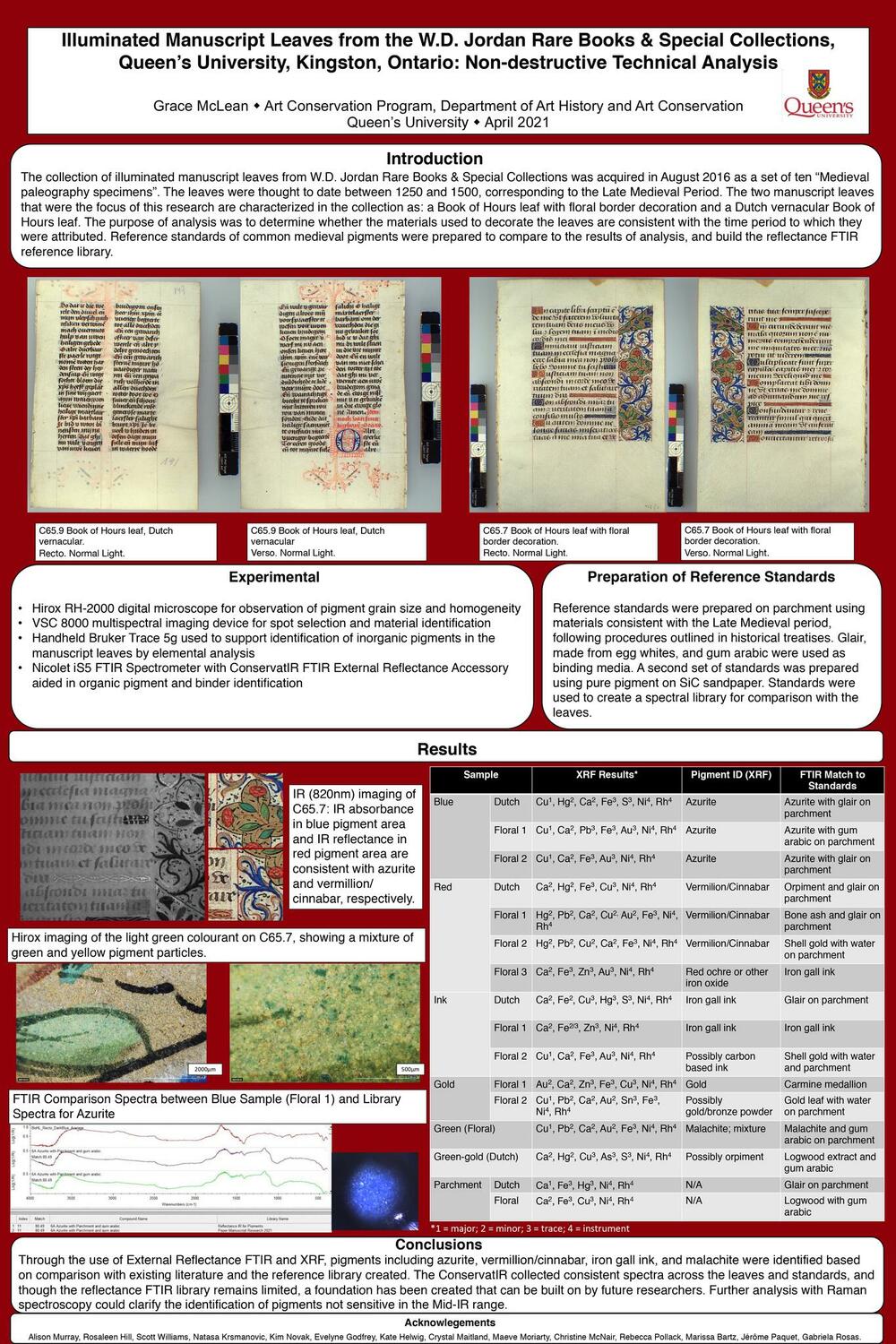 Grace McLean
Grace McLean
In this research project, two medieval illuminated manuscript leaves from W.D. Jordan Rare Books & Special Collections at Queen’s University were investigated using non-destructive methods of analysis. The purpose of this analysis was to determine whether the materials and techniques employed are consistent with the presumed time period that the leaves were made. The leaves were purchased for the library’s study collection as a mixed lot of single pages from different manuscripts and are believed to date from 1250 - 1500. This case study, which was a collaborative project between the Master of Art Conservation candidates in the paper treatment stream, focused on a limited selection of leaves from the collection. Due to the nature of the objects, it was not possible for samples to be taken, but non-invasive material analysis was performed on-site at the Queen’s University Art Conservation Program facilities using a digital microscope, multi-spectral and hyper-spectral imaging, x-ray fluorescence (XRF), and external reflectance infrared spectroscopy. The digital microscope facilitated close examination of the leaves. The multi-spectral illumination and hyper-spectral imaging device aided in colorant identification. XRF analyzed pigments based on their qualitative elemental make-up. External reflectance IR was used for organic pigment analysis. The leaves were transported on temporary loan from the library for a short period during the Winter 2021 term for analysis. In addition, standards were prepared using materials and techniques consistent with the Late Medieval period for comparison during analysis, and to bolster the existing FTIR reflectance library. Instrumental analysis was supplemented with research on the art historical context of illuminated manuscripts, and historic materials and methods of application that were commonly employed for manuscripts during the medieval period. Pigments including azurite, vermillion/cinnabar, iron gall ink, and malachite were identified using the complimentary techniques listed above, and through comparison with existing literature and the ER-IR reference library created. Though the reflectance FTIR library remains limited, a foundation has been created that can be built on by future researchers.
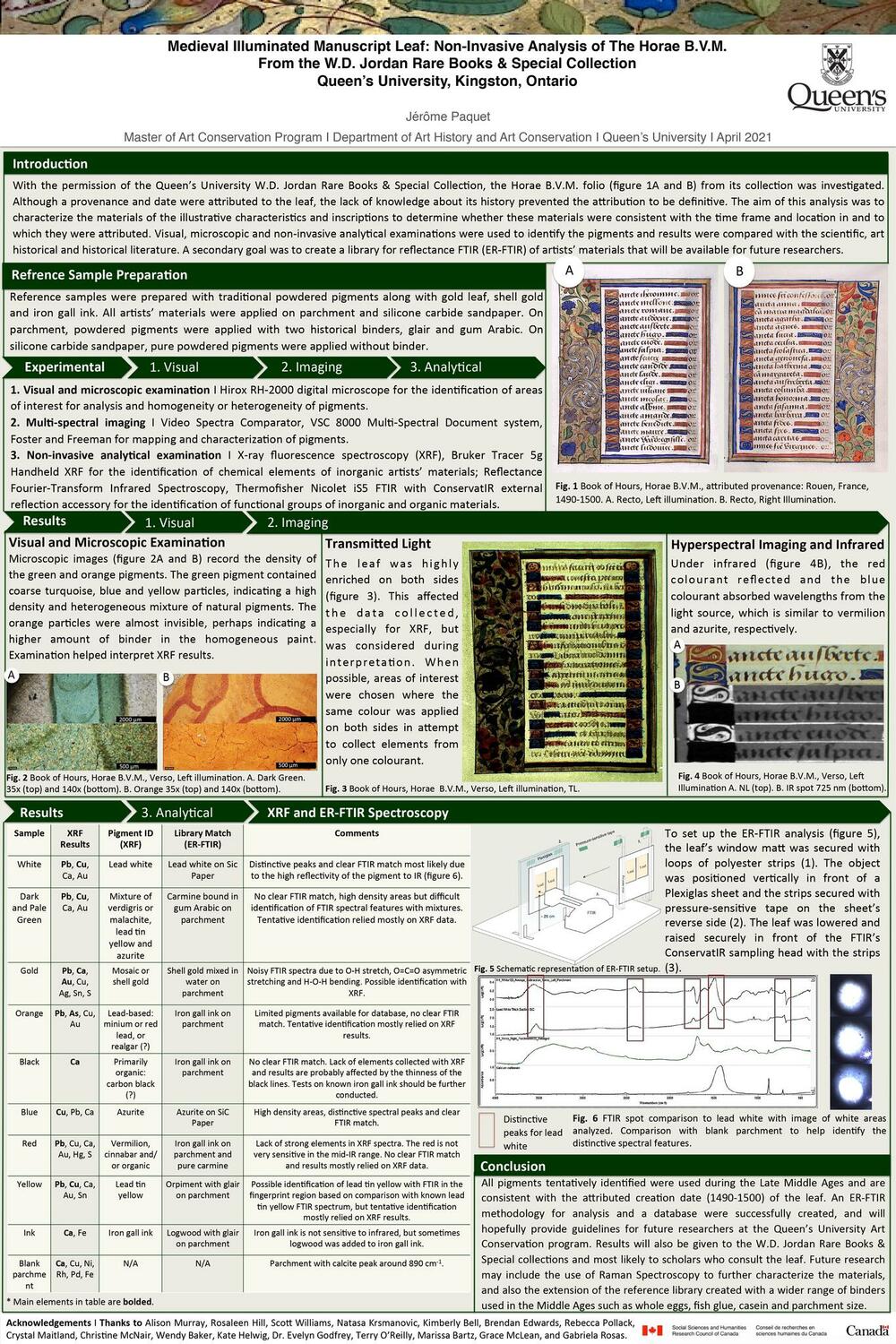 Jérôme Paquet
Jérôme Paquet
This collaborative research studies the components of illuminated medieval leaves from the Queen’s University W.D. Jordan Rare Books & Special Collection that have been dissociated from their original bound parchment manuscripts. Although part of the same collection, these double-sided delicate leaves, created between the 13th and 16th centuries, originate from different manuscript sources. As these richly decorated leaves are often consulted and may be the only surviving remains of the manuscripts they were once part of, and thus are highly valuable objects, the maintenance of their original structural integrity during scientific examination is of most great importance. Technological advances in the last two decades have allowed conservators and scientists to examine such valuable and delicate objects with non-destructive analytical methods. Using non-invasive analytical techniques such as X-ray fluorescence spectroscopy (XRF), external reflectance Fourier-transform infrared spectroscopy (ER-FTIR), and the VSC 8000 multi-spectral document system, this study analysed the pigments from two leaves, with a particular emphasis on the scientific examination of selected surface areas bearing the predominant colorants and gilding. To eliminate sample extraction and limit possible damage risks, reference samples were created and served as standards to which results obtained from the objects’ analyses were compared. These reference and comparative samples were created following medieval recipes. The processes, pigments, dyes, binders and gilding techniques used were mentioned in art historical, historical and scientific literature on medieval illuminated leaves. The main goal of this study was the characterization of the leaves’ components diversity through visual examination, multispectral imaging and non-invasive investigation. Such goal could therefore gave new insights into the authenticity, provenance, attribution and production of these objects, as little was known by the Special Collection about them. Building on previous research on illuminated parchment leaves, this study could also be a beneficial contribution by expanding knowledge on such artefacts.
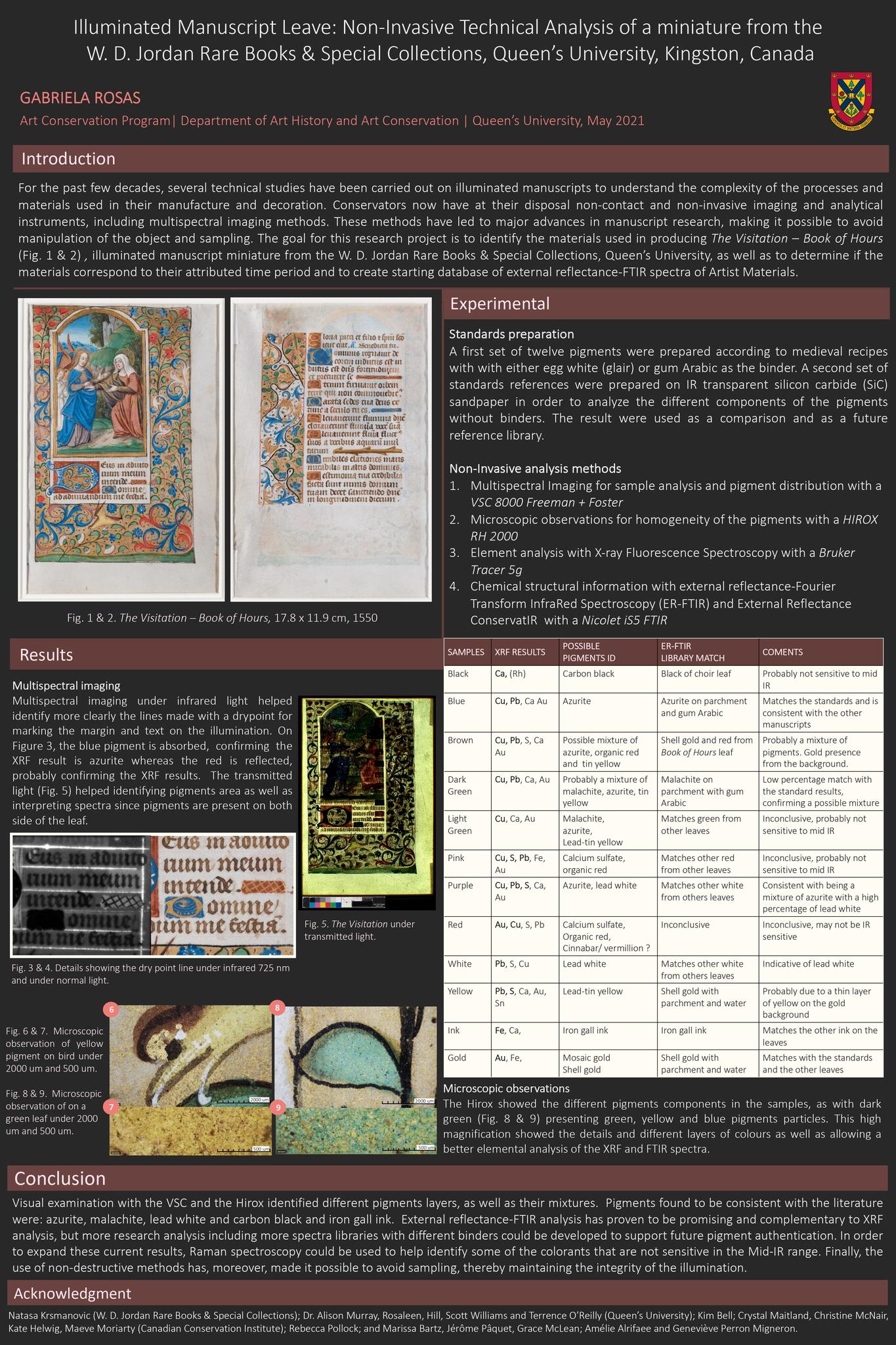 Gabriela Rosas
Gabriela Rosas
For the past few decades, several studies of technical and analytical examination have been carried out on illuminated manuscripts to understand the complexity of the processes and materials used in the manuscripts’ manufacture and decoration. Illuminated manuscripts are complex objects with multiple materials and layers that include the support, binder and colourants. This research project was a collaboration between the second-year paper conservation students at Queen’s University to examine eight manuscript leaves from the W.D Jordan Rare Book and Special Collections at Queen’s. This study combines in situ non-destructive analytical techniques on an illuminated manuscript miniature, The Visitation, from the 15th century. The miniature was analyzed using only portable non-invasive techniques including portable x-ray fluorescence spectroscopy (XRF), external reflectance-Fourier transform infrared spectroscopy (ER-FTIR), multispectral imaging with the VSC 8000 and microscopic observations with the Hirox RH 2000 microscope. This analysis was supplemented with historical research about medieval manuscripts and their creation. In addition, standards were prepared using materials and preparation techniques consistent with the Late Medieval period for comparison during analysis and to bolster the existing external reflectance-FTIR library. Visual examination with the VSC and the Hirox identified different pigments layers, as well as their mixtures. Pigments found to be consistent with the literature were: azurite, malachite, lead white and carbon black and iron gall ink. Reflectance FTIR analysis has proven to be promising and complementary to XRF analysis, but more research analysis including more spectra libraries with different binders could be developed to support future pigment authentication. Secondly, a new procedure for the external reflectance-FTIR attachment was established as well as begin a library of reflectance spectra of artists’ materials. All the data will be made available to the WD Jordan Rare Book and Special collections so they can pass it on to future researchers of the leaves.
2019-2020
Cailin Donohue Cser
Albumen photographs often account for the largest number of 19th-century prints within photographic collections. The thin substrate and inherent moisture sensitivities of albumen prints frequently impose limited treatment options. When there is unwanted media, such as ink, on the surface of an albumen print, there are important treatment considerations. Mechanically removing the ink with solvents and a cotton swab could result in abrasion of the image surface, irreversible damage from excess moisture, or further embedding the ink. While benzyl alcohol solubilizes the most common ballpoint pen inks, only a handful of gels have the ability to absorb polar solvents successfully without desiccating. For this reason, Nanorestore Gel® Medium Water Retention (MWR) and Velvesil Plus were compared as delivery systems for dissolving ballpoint ink with benzyl alcohol on historic albumen photographs. This study focused on the removal of two different inks: Bic® red and Parker® blue. Following various treatment approaches, changes to the topography of the albumen photographs were tracked using a Hirox digital microscope. Fourier transform infrared spectroscopy (FTIR) was used to confirm that no residues were left behind from the various treatment methods, while lateral dispersion of moisture was tracked using a fluorescein sodium salt to support visual analysis. The solvent-loaded Nanorestore Gel® MWR was more successful at clearing ink than the Velvesil Plus emulsification with benzyl alcohol; however, tidelines were a concern. A large part of this study focused on the behaviour of the Nanorestore Gel® MWR as it was loaded with benzyl alcohol and possible protocols for its use on photographic materials.
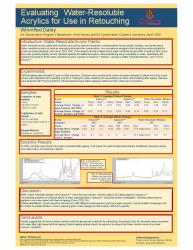 Winnifred Daley
Winnifred Daley
Water-resoluble acrylic paints are a recent development in the world of acrylic mediums. Several manufacturers created these water-resoluble formulas to increase options for artists who wished to use wet-in-wet and watercolour techniques while using acrylic paints. Research by Sims, Cross, and Smithen explored the colour stability and reversibility of Lascaux’s Aquacryl™, one of these new generation of paints. This research expanded upon previous work by exploring three clear mediums from two manufacturers to see if they displayed good ageing characteristics and remained water soluble over time. To determine ageing characteristics, samples of various brands of water-resoluble acrylic paints were measured for their colour and gloss, before and after light-based artificial ageing. Samples were also analysed with Fourier transform infrared spectroscopy before ageing to identify components in their formulations. Control and aged samples were tested for water solubility through testing with swabs. The creation of the samples also provided the opportunity to make qualitative judgements about the handling properties of the paints. Information collected on the stability of the paints, their formulation, their handling properties, and their solubility helped establish that these mediums age well, remain reversible, and are appropriate for retouching.
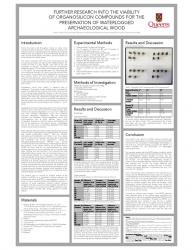 Hope La Farge
Hope La Farge
The preservation and treatment of waterlogged archeological wood is an important topic to address because of changing climates. More and more wet archaeological materials have been exposed due to melting glaciers. For some time, waterlogged archeological wood have been most commonly treated with polyethylene glycol (PEG) or sucrose. The use of both of these compounds is known to prevents dimensional change and further degradation of wet wooden artifacts. However, each material has drawbacks. PEG has a long application process, color shifts have been observed, and more recently high relative humidity has been shown to degrade the wood compound. Sucrose has a tendency to be a pest attractant and migrates with temperature fluctuations and high relative humidity changes. Thus, due to In lieu of these preservation issues, it is pertinent to look at other materials. Recent research has been published into the application of organosilicon compounds with added active groups on waterlogged wood. Organosilicon compounds have the potential to support and stabilize dimensional change, reduce flammability, protect against decay, and reduce the impact from weathering. More recently the compounds have also been used as surface modifiers, binding agents, and adhesion builders in conjunction with nanoparticles in other conservation applications. Preliminary results showed that (3-mercaptopropyl) trimethoxysilane (MPTES) had the highest potential for the treatment of waterlogged archaeological wood, with little dimensional or color change occurring. This proposed research project further investigates the effects of MPTES on waterlogged archaeological wood after accelerated aging, by exposing prepared wood samples to high relative humidity, at 100% RH for four days. The long-term preservation capabilities of the MPTES were analyzed by examining weight gain, color change, dimensional changes, and biodeterioration of the wood samples. These changes were examined with various techniques including Fourier transform infrared spectroscopy, Hirox microscopy, light microscopy, scanning electron microscopy, color photometry, and a digital scale. Results indicate there was a significant decrease between initial weight and after airdrying for MPTES/ethanol treated samples, however the difference is not as drastic as untreated samples. Color difference is minimal in both the treated and untreated samples. Initial visual observations indicate minimal dimensional changes to the treated wood, however drastic detrimental changes to the untreated samples.
 Emilee Lawrence
Emilee Lawrence
Abstract Writing-On-Stone/Áísínai’pi (“it is written”) Provincial Park, a UNESCO World Heritage site, is an important site of petroglyphs and pictographs. Located in Southern Alberta, the rock art and rock formations are extremely culturally and spiritually significant to many First Nations communities. However, due to environmental weathering, the inherent instabilities of certain rock substrates, as well as biological and anthropogenic impacts, there has been a loss of rock art panels. This research presents the preliminary evaluation of a Living Heritage Approach to conservation, using ethnographic methods to determine factors affecting the continuity of the original or intended function of the site, to inform future conservation practices and protocols at Writing-On-Stone/Áísínai’pi. Data collected from consultations with Elders of the Blackfoot Confederacy, which focused on the site significance, relationships with the site and landscape, traditional materials, and perceptions of conservation treatment and protocols, identified these factors which were then evaluated within Poulios’ (2014) Living Heritage framework. The results from this evaluation determined that in prioritizing the ties by the core community with Writing-On-Stone/Áísínai’pi and focusing on the preservation of the intangible and living qualities of the heritage, it was possible to identify meaningful and spiritually appropriate conservation and preservation strategies, allowing heritage to resume its’ active role in contemporary society. Additionally, through a Living Heritage Approach to conservation, it is possible to understand how the conservator can support sustainable conservation, by assisting the core or living communities in enacting their conceptions of conservation and preservation.
Marianne LeBel
Berlin work is a type of embroidery in which yarn is stitched onto an open-weave canvas, usually by following a grid pattern. It was the most popular form of needlework in the nineteenth century, being a very accessible craft due to its simple technique and to the wide availability of patterns. Among the frequent subjects embroidered by the practitioners of Berlin work is the reproduction of famous paintings. An example of these ‘needlepaintings’ is a large Berlin work, dated 1850, which reproduces Horace Vernet’s 1832 painting Raphael at the Vatican. Berlin work materials, like coloured yarn, were sold in specialized stores, ready to use by clients. Although wool was the most common fibre to be used for such embroideries, Berlin work repositories also sold other types of yarns which could be used for Berlin work. Before 1856, the yarn was usually coloured with natural dyes, which are known not to be lightfast and cause damage to the fibres during the dyeing process. The Berlin work of Raphael at the Vatican shows preferential degradation of certain grey yarns and discolouration of the middle portion of the object. The object was also exposed to moisture and possibly to pests. A technical investigation of the embroidery’s materials and degradation shed light on the causes of deterioration and informed the textile’s recommended treatment (procedures and materials for cleaning and repairs) as well as measures to be taken for its preventive conservation. Fibres were identified and their morphologies were assessed by polarizing light microscopy and scanning electron microscopy (SEM). The state of more degraded embroidered areas was compared to that of more intact areas by SEM and colorimetry. X-ray fluorescence (XRF) was used to give information on mordanting, and gas chromatography-mass spectrometry may be used at a later date to determine whether a purple dye is synthetic or natural in order to confirm the dating of the textile. It was found that the textile was created by embroidering wool yarn on cotton canvas. Quantifying the fading allowed to make informed guesses regarding the identity of certain dyes. The dark discolouration likely occurred because of chemical deterioration, and the selectively deteriorated wool was damaged because of corrosive iron mordants. Observations were made regarding the object’s materials and construction which might contribute to the emerging body of literature on Berlin work embroidery.
Corrine Long
This a preliminary assessment of acrylic gel mediums. An assortment of acrylic gel mediums within the same brand were analyzed to understand them better as materials for artists and conservators. The main interest was to identify the thickening agent or agents and compare their chemical components to other acrylic paint using Fourier transform infrared spectroscopy (FTIR). Liquitex offers several different kinds of acrylic gel mediums that have variations in sheen and viscosity. The behavior of acrylic gel mediums as a paint film was studied by making samples of various acrylic gel mediums. These mediums were examined in three different thicknesses (6 mil, 12 mil, 0.5 cm). Historic and contemporary additives that have been identified and published in conservation literature on acrylics aided in identifying what additives are used in Liquitex gels and paints a picture of the evolution of the material. The samples were studied for hardness, color and gloss, before and after accelerated aging. The gloss gels were softer and the matte gels were harder; all gels yellowed after drying in the dark and no differences were noticed after accelerated aging. The properties of acrylic gel mediums are revealed from this study to help conservators understand them more so that measures can be taken to prevent damage; such as controlled storage and display methods.
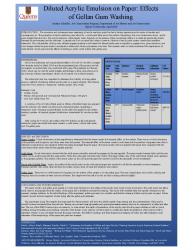 Sydney Schaffer
Sydney Schaffer
Acrylic emulsion paint is a common media used for canvas artwork; however, the lesser researched artwork is that of acrylic on paper. Identification of this technique can be difficult and can lead to a misidentification of the work, most commonly as a watercolor. Washing acrylic emulsion paint on paper could lead to irreversible changes in gloss and morphology of the acrylic surface; however, research into the use of gellan gum for cleaning is ongoing within the realm of conserving acrylic paint. This project explored the implications of gellan gum washing and identify if there was deterioration or changes in morphology to acrylic emulsion media on a paper substrate after cleaning. Gellan gum cleaning was to be compared with samples that did not undergo cleaning. The media of the samples examined were acrylic emulsion paints from Golden Artist Heavy Body Colors (titanium white, carbon black, phthalo green) diluted in distilled water at intervals of 2.5%, 5%, and 15% weight by volume. Two paper substrates were used: hot-press watercolour paper and cold-pressed paper. The onset of the coronavirus in March 2020 halted the research project. A pilot study was conducted and samples were prepared for future research. The eraser crumbs and gellan gum seemed to be the least disruptive to the surface of the acrylic wash under visual observation. In the initial findings of the experiment, gellan gum may be a suitable candidate for cleaning diluted acrylic paint on paper. In future research, cockling of the paper with the use of gellan gum should be addressed.
Lindsay Sisson
Developments in the use of rigid polysaccharide gels for targeted cleaning of works of art on paper over the past twenty years have provided conservators with more control and flexibility for modifying their treatment options to the needs of the individual objects. Rigid polysaccharides such as gellan gum (Gg) have many advantages including flexibility in their preparation (different aqueous solutions and the addition of organic solvents to the gel); modification of their concentration and thickness; precise and localized control of the gels; and easy removal from the object’s surface. Recent research has been focusing on the ability to introduce additives into the Gg to modify its efficiency; however, it is unclear how these additives affect the surface swelling of paper, potentially and irrevocably affecting the paper surface. In addition, the conductivity and pH of the water used in preparing the rigid polysaccharide gels may also affect the degree to which paper fibres swell. This study explored the surface swell behaviour of Gg infused with a deacidification additive, calcium propionate, using adjusted water at various conductivity levels. Two kinds of paper, a smooth, kaolin-containing calendered paper and a rough, gelatin-sized cold press Arches watercolour paper, were used to assess any differences in the conformability of modified Gg to the surface of different paper surface topographies. The two sample sets of paper were examined before and after treatment for topographical changes using a Hirox RH 2000 3D-microscope (Hirox). The Hirox captured a digital three-dimensional model of the paper surface that allowed for closer examination of surface swelling characteristics. Originally, this research expected to provide further information regarding the properties of modified Gg; however, there were several limitations and variables that appeared during these experiments including concerns with the sample preparation, instrumentation errors associated with the pH and conductivity measurements, and issues concerning reproducibility with the Hirox. As a result of these limitations and variables, it was difficult to draw any valuable conclusions from the data collected and each of these issues must be examined in order for future research of this nature to yield accurate results.
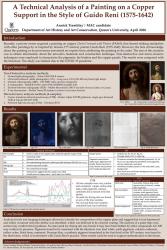 Annick Tremblay
Annick Tremblay
The aim of this research was the analysis of an oil on copper painting that was possibly painted by Italian painter Guido Reni (1575-1642), with the purpose of obtaining information about its materials and construction technique and finding any possible similarities with paintings by Reni or his studio. Non-destructive and micro-invasive methods were selected to characterise the painting’s components and its copper support. Non-destructive analyses included photo-documentation (normal light, raking light, ultraviolet radiation, infrared reflectography, X-radiography, electron-emission radiography [EER]) and X-ray fluorescence (XRF). Micro-invasive analyses included Fourier transform infrared spectroscopy (FTIR) and polarised light microscopy (PLM). XRF provided preliminary results about the elemental composition of the copper panel and the pigments – lead white and an arsenic-containing pigment such as cinnabar – but the information was limited due to the interference with the metallic substrate. FTIR provided further evidence about the pigments, especially earth pigments, a natural resin as a possible binder and confirmed the presence of copper carboxylate, a deterioration product of copper. Interestingly, no peak for drying oils was found, thus demonstrating the necessity of further analysis with gas chromatography – mass spectroscopy (GC-MS) to refine the results. All samples were then examined under PLM to characterise all found pigments. This study confirmed the use of Prussian blue, a pigment traditionally found in historical paintings from the late 1730s onward, therefore eliminating Guido Reni as a potential artist. Unfortunately, energy-dispersive X-ray spectroscopy could not be carried out as planned due to the limited access to laboratories during the COVID-19 crisis.
Kaoru Yui
In 2014-2015, the Master of Art Conservation program at Queen's University obtained three Egyptian coffins dating to the Third-Intermediate Period. Both technical analysis and digital imaging were performed on the white-type anthropoid inner coffin, which is recognized as a rare type of coffin. The materials, layering structure, and areas of loss and vulnerability of the coffin were examined. This project focused on the white coffin to identify materials that remain unstudied, including the species of wood used for dowels and splines with polarized light microscopy (PLM), Hirox digital microscopy and environmental scanning electron microscopy (ESEM); and the binding medium for the pigments with chemical spot tests and Fourier transform infrared spectroscopy (FTIR). The wood was identified as tamarisk. The binding medium was identified to be proteinaceous or starch-based materials. The second part of project included the evaluation of possible conservation treatment methods and materials, including cleaning using cosmetic sponges and monitoring using the Hirox digital microscope; also, the change in colour after using consolidants for the wood was measured with a spectrophotometer. Based on the evaluation results, a partial conservation proposal of superficial dirt cleaning with cosmetic sponges was provided. The experiment for the evaluation of consolidants was interrupted because of the university closure due to COVID-19 pandemic. Another important aspect of this research project was to address the ethical considerations surrounding the treatment of the decontextualized mortuary object. Through the study of partial hieroglyphs preserved on the coffin fragments and archival research, the reconsideration of the object’s values was discussed. The entire research project included steps towards the long-term goal to reconstruct the coffin.
2018-2019
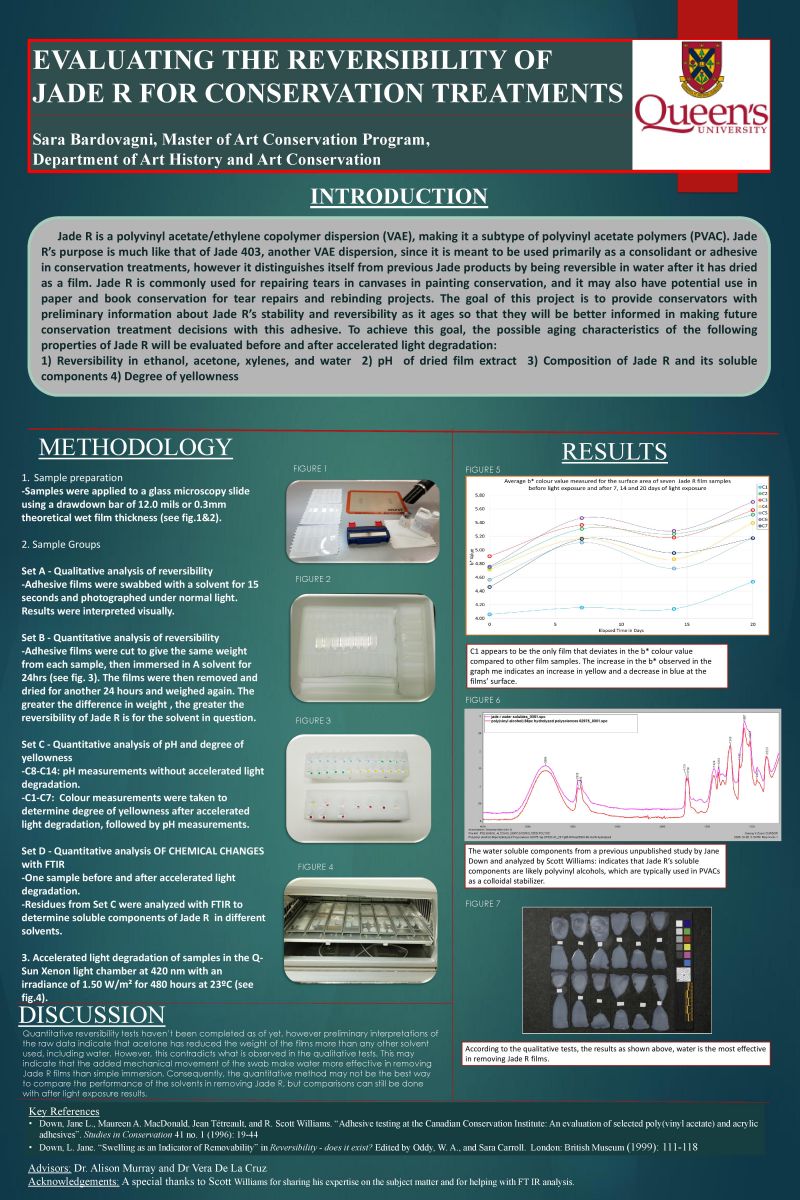 Sara Bardovagni
Sara Bardovagni
Jade R is a polyvinyl acetate/ethylene copolymer dispersion (VAE), making it a subtype of polyvinyl acetate polymers (PVAC). Jade R’s purpose is much like that of Jade 403, another VAE dispersion, since it is meant to be used primarily as a consolidant or adhesive in conservation treatments. However, Jade R distinguishes itself from previous Jade products by being reversible in water after it has dried as a film. Jade R is commonly used for repairing tears in canvases in painting conservation, and it may also have potential use in paper and book conservation for tear repairs and rebinding projects. The goal of this project is to provide conservators with preliminary information about Jade R’s stability and reversibility as it ages so that they will be better informed in making future conservation treatment decisions with this adhesive. To achieve this goal, the possible aging characteristics of the following properties of Jade R have been evaluated before and after accelerated light degradation: 1) Reversibility in ethanol, acetone, xylenes, and water 2) pH of dried film extract 3) Composition of Jade R and its soluble components 4) Degree of yellowness
To conclude, Jade R is quite stable according to aging tests done in this project, as it maintains an alkaline pH and resists yellowing in the short-term. It has also been revealed that lantic sugar is used as and additive in Jade R. Unfortunately, reversibility tests conducted in this project did not have conclusive results. Nonetheless Jade R’s chemical properties and short-term stability make it a very promising adhesive in conservation. Thus, further aging studies, perhaps with varied mixtures of solvents and water, should be conducted to learn more about this VAE adhesive.
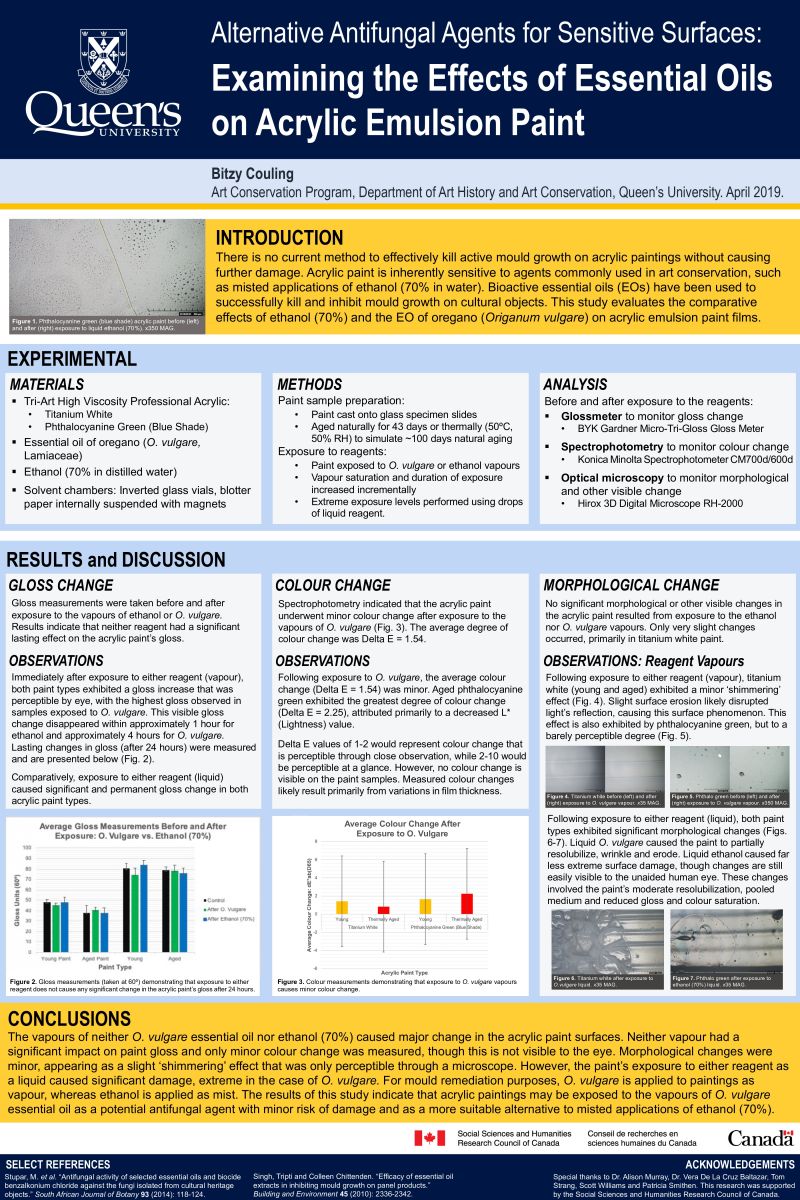 Elizabeth Couling
Elizabeth Couling
There is no current method to effectively kill or inhibit active mould on an acrylic paint surface without causing some degree of further damage. In recent studies, bioactive essential oils have been used to successfully kill and inhibit active mould growth on cultural objects. In this study, the comparative effects of Origanum vulgare (oregano) essential oil and ethanol (70% in water) on acrylic emulsion paint films were evaluated. Optical changes in the paint films were monitored using both glossimetry and colorimetry and through the evaluation of surface morphologies. In their volatile states, both reagents induced some paint swelling. Significant change, however, occurred in only one case: young titanium white paint films exposed to ethanol (70%) for twenty-four hours, which underwent a permanent visible increase in surface gloss. Exposure to either reagent in its liquid state caused significant surface changes in the paint films, most extreme in the case of O. vulgare. In practice, mould remediation is most often performed by administering a liquid mist of polar organic solvent onto the affected surfaces, whereas essential oils are applied as a vapour. The results of this study show that exposure to the vapours of O. vulgare essential oil cause less optical changes in acrylic emulsion paint films than exposure to liquid ethanol (70%), or no perceptible change at all. Further research should evaluate the effects of extended durations of exposure to the essential oil, potential changes in the acrylic paint’s mechanical properties, and the possibility and implications of essential oil residues.
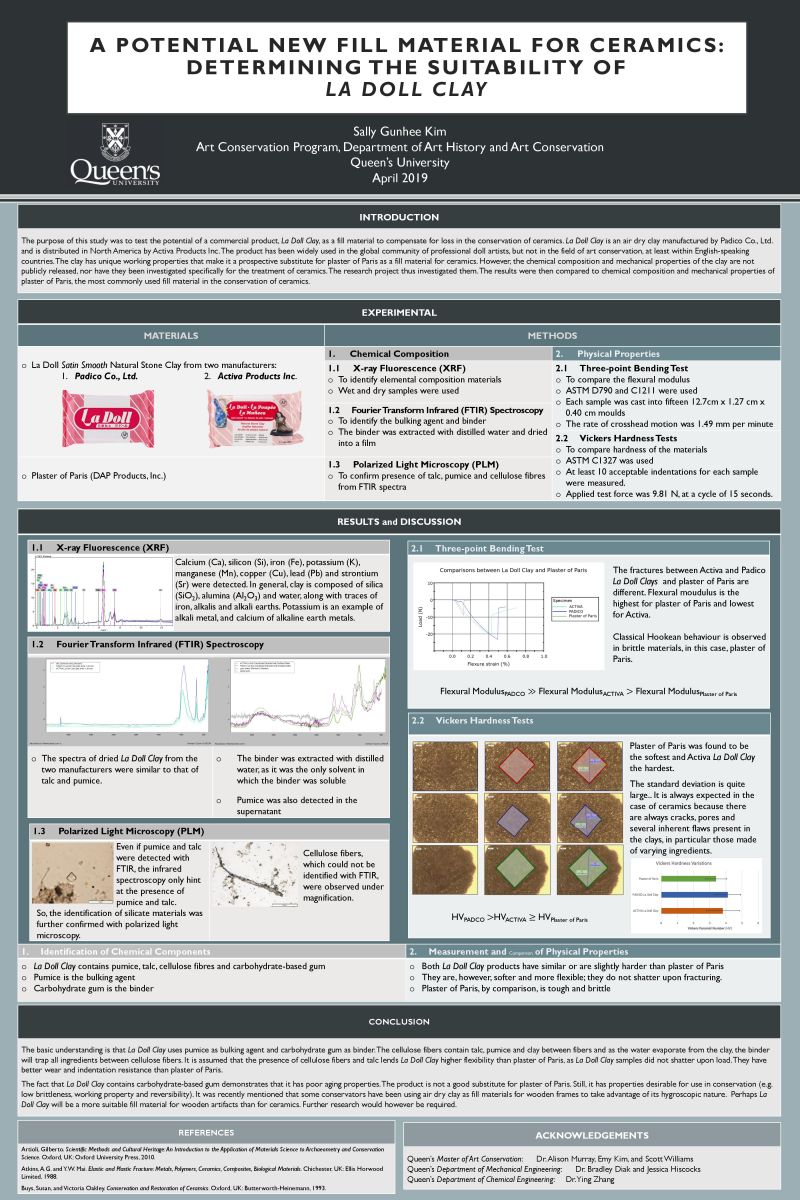 Sally Gunhee Kim
Sally Gunhee Kim
The purpose of this study was to test the potential of a commercial product, La Doll Clay, as a fill material for ceramics. La Doll Clay is an air-dry clay manufactured by Padico Co., Ltd. and is distributed in North America by Activa Products Inc. La Doll Clay has been widely used in the global community of professional doll artists, but not in the field of art conservation, at least within English-speaking countries. The clay has unique working properties that make it a prospective substitute for plaster of Paris as a fill material for ceramics. This commercial clay air-dries with minimal shrinkage, is very pliable, is miscible with water, adheres to various substrates (e.g. glass, plastic, wood), and readily accepts acrylic, oil and water-based paints. Even when dry, additional clay can be added with a few drops of water. When solidified, La Doll Clay can be sanded into a smooth finish. Unfortunately, the chemical composition and mechanical properties of the clay are not publicly released, nor have they been investigated specifically for the treatment of ceramics. Thus, the chemical components in the clay were identified with x-ray fluorescence (XRF) spectroscopy, Fourier transform infrared (FTIR) spectroscopy and polarized light microscopy (PLM). Also, the physical properties of the substrate were measured using Vickers hardness, three-point bending and volume shrinkage tests. The findings were then compared with those of plaster of Paris for effectiveness in treating areas of loss. The clay was concluded to be not a good substitute for plaster of Paris.
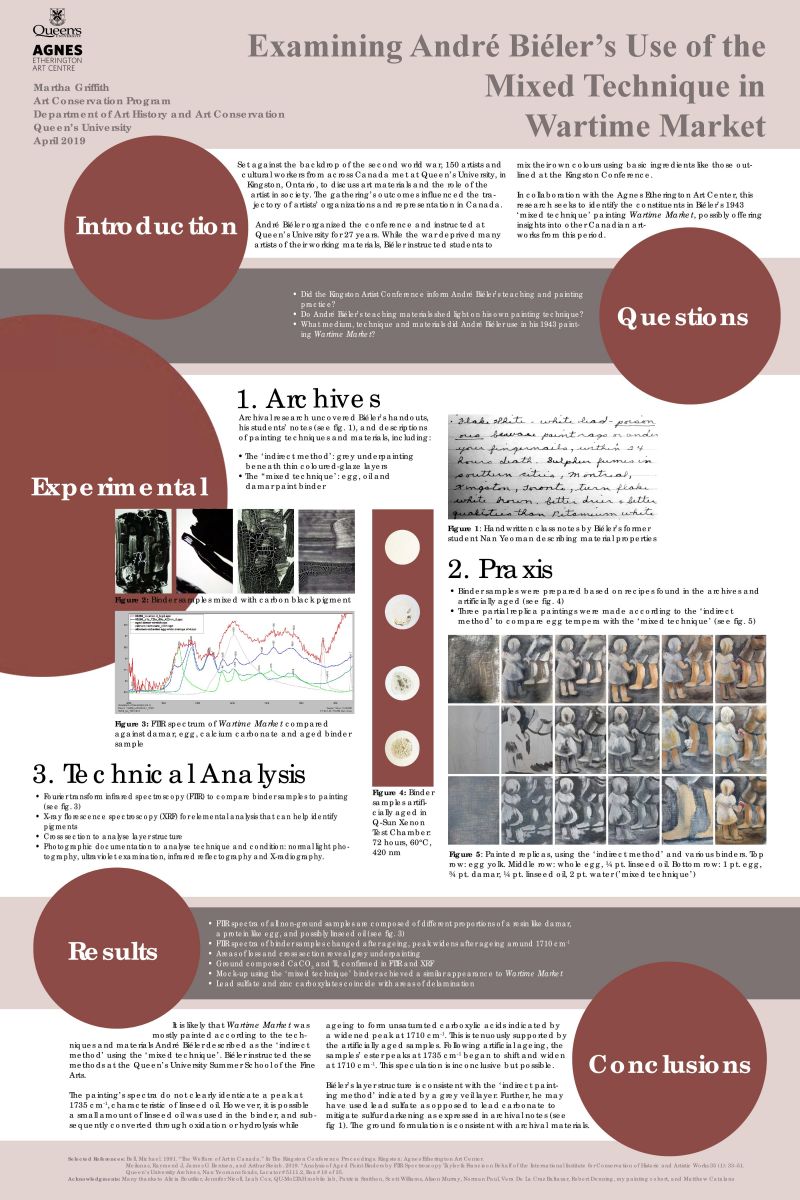 Martha Griffith
Martha Griffith
Set against the backdrop of the second world war, 150 artists and cultural workers from across Canada met in Kingston, Ontario, to discuss art materials and the role of the artist in society. During the 1940s, several Canadian painters experimented with the ‘mixed technique’ including André Biéler, the conference organizer. Biéler was an influential artist in Canada and a professor at Queen’s University in Kingston, Ontario for 27 years. As such, his artistic technique, use of materials and instructional methods influenced other artists of the period. In collaboration with the Agnes Etherington, this research investigated Biéler’s use of the ‘mixed technique’ in his 1943 painting Wartime Market. Wartime Market was examined through archival research and technical analysis to determine if his didactic materials reflected his own painting practice. Technical analysis began with photographic documentation and examination to identify potential coatings and underdrawings. Photographic techniques included normal light photography, ultraviolet examination, infrared reflectography and X-radiography. Further analysis included cross-section analysis to identify the painting’s layer structure, X-ray fluorescence (XRF) to identify prominent pigments and Fourier-transform infrared spectroscopy (FTIR) to identify the binding agents. Next, a partial replica was painted based on Biéler’s didactic materials found in the Queen’s University Archives. Samples from the replica were artificially aged and compared to samples from Wartime Market using FTIR analysis. Analytical results and the results of the painted replicas indicated that Biéler likely used a natural resin and a protein, such as dammar and egg, for his binder. Additionally, Biéler may have used linseed oil in the binder, but results are inconclusive with FTIR. Lastly, cross-section and photographic examination revealed that Biéler applied his paint in a series of layers that he called the ‘indirect method,’ as outlined in his teaching materials.
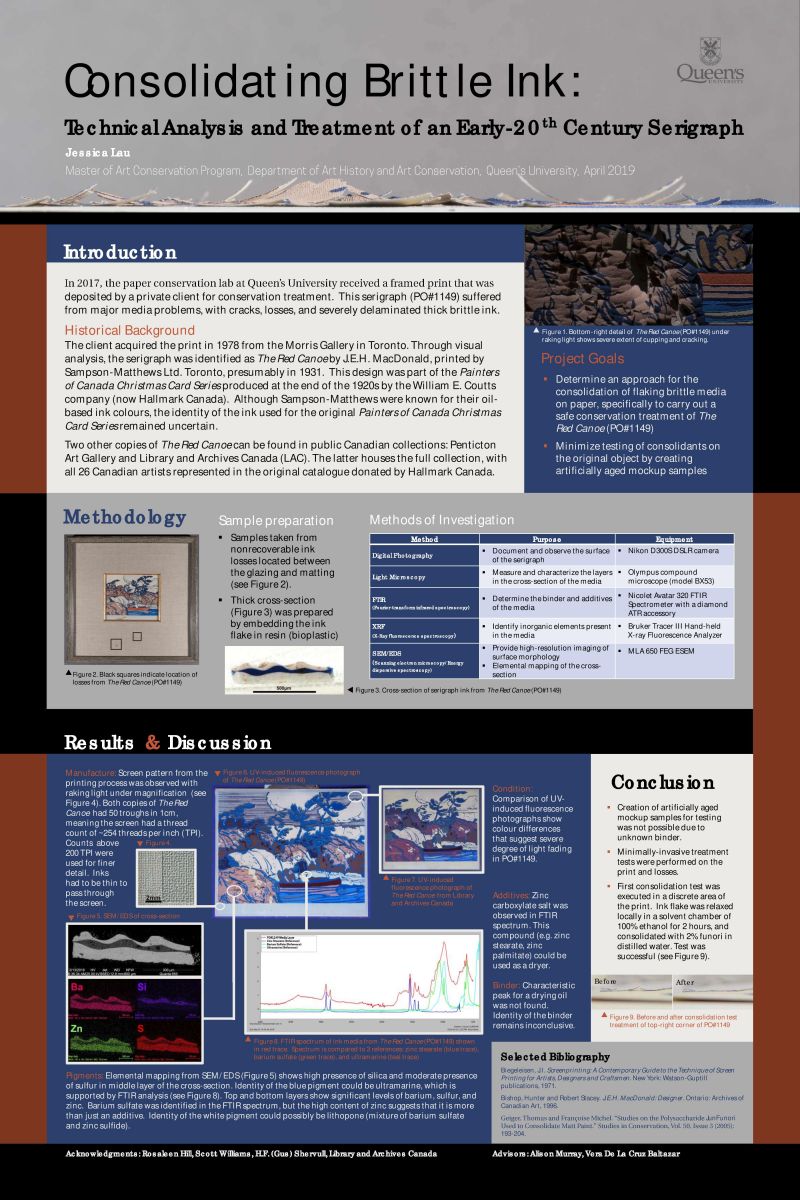 Jessica Lau
Jessica Lau
The Painters of Canada Christmas Card Series (c. 1931) was an early endeavour by the Canadian graphic art company Sampson-Matthews Ltd. (1918-1980) to produce serigraphs that would popularise the works of Canadian artists throughout the nation. However, due to the economic instability of the time, the series was a financial failure and the surviving cards now remain scarce. One of these serigraphs, The Red Canoe by J.E.H. Macdonald, was deposited for conservation treatment by a private client to the paper conservation lab at Queen’s University. The media layer of the print showed a severe state of deterioration, with major areas of delamination and cracking. The goal of this project was to determine an approach for the consolidation of thick brittle ink on paper, and to minimize testing on the original print by creating artificially aged mockup samples. A technical analysis of the materials and methods of The Red Canoe was therefore carried out, with a primary focus on the identification of the binder. Scanning electron microscopy/ energy dispersive x-ray spectroscopy (SEM/EDS), Fourier transform infrared spectroscopy (FTIR), and x-ray fluorescence spectroscopy (XRF) were used to identify two pigments: ultramarine blue and lithopone (i.e. barium sulfate and zinc sulfide). Zinc carboxylate salt was also identified in the FTIR spectrum, but the identity of the binder remained inconclusive. Mockup samples could not be created due to insufficient results, and testing was instead carried out on minimally invasive areas of the print.
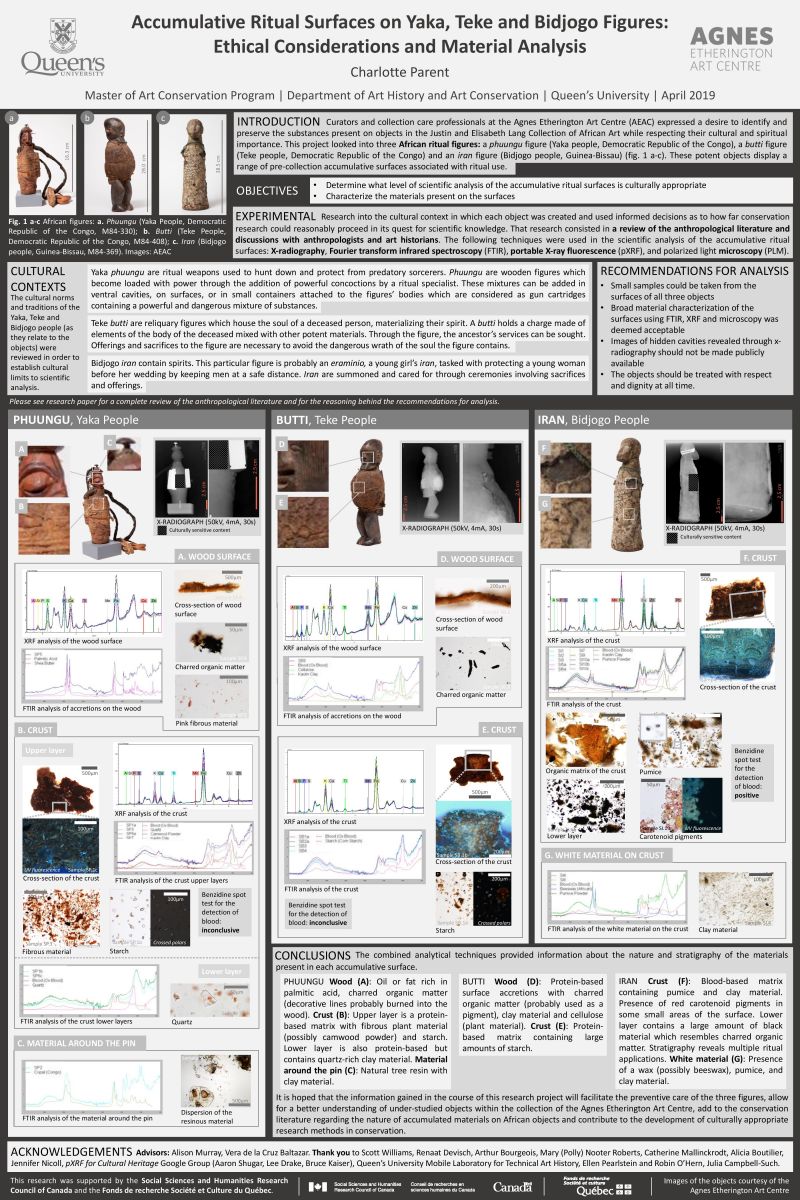 Charlotte Parent
Charlotte Parent
The historic arts of Africa take on many critical roles in their communities of origin: they are instruments of knowledge, bridges between the living and the ancestral or spiritual, agents of memory, implements of private and social well-being, and actors in the political life of a community. The meaning and spiritual value of African figures is rooted in their use, which is often visible in the form of ritual materials accumulated on their surfaces. When those African objects entered Western collections, they often did so without proper documentation or provenance information. Concerns about the degradation of accumulative surfaces and about their potential harmful effects on other objects within collections are hard to address without adequate knowledge of their composition. This project focuses on three wooden figures from the Justin and Elisabeth Lang Collection of African Art of the Agnes Etherington Art Centre: a Phuungu figure (Yaka people, Democratic Republic of the Congo - M84-330), a Butti power figure (Teke people, Democratic Republic of the Congo - M84-408) and an Iran figure (Bidjogo people, Guinea-Bissau - M84-369). These ritual objects display a range of pre-collection accumulative surfaces. This project looks into these accumulative surfaces: their material composition and the ethical implications of identifying their constituent components. Much effort was placed in conducting a project which is culturally appropriate and which seeks to preserve both the tangible and intangible aspects of the objects. Art historical and ethnographical research informed decisions as to how far conservation research can reasonably go in its quest for scientific knowledge in the case of these sensitive objects. In order to perform scientific analysis of the objects, X-radiography, Fourier transform infrared spectroscopy (FTIR), X-ray fluorescence (XRF), chemical spot tests and polarized light and stereo microscopy were used. Combining these analytical techniques provided information about the types of materials present as well as the structure (stratigraphy) of the surfaces. The substances identified on the three figures include oil or fat, waxes, resin or gum, proteinaceous materials (including blood), camwood, starch, charred organic material, ground vegetable material, quartz, pumice, and clay materials. It is hoped that the information gained in the course of this project will facilitate the preventive care of the three figures, allow for a better understanding of under-studied objects within the collection of the Agnes Etherington Art Centre, add to the conservation literature regarding the nature of accumulated materials on African objects, and contribute to the development of culturally-appropriate research methods in conservation.
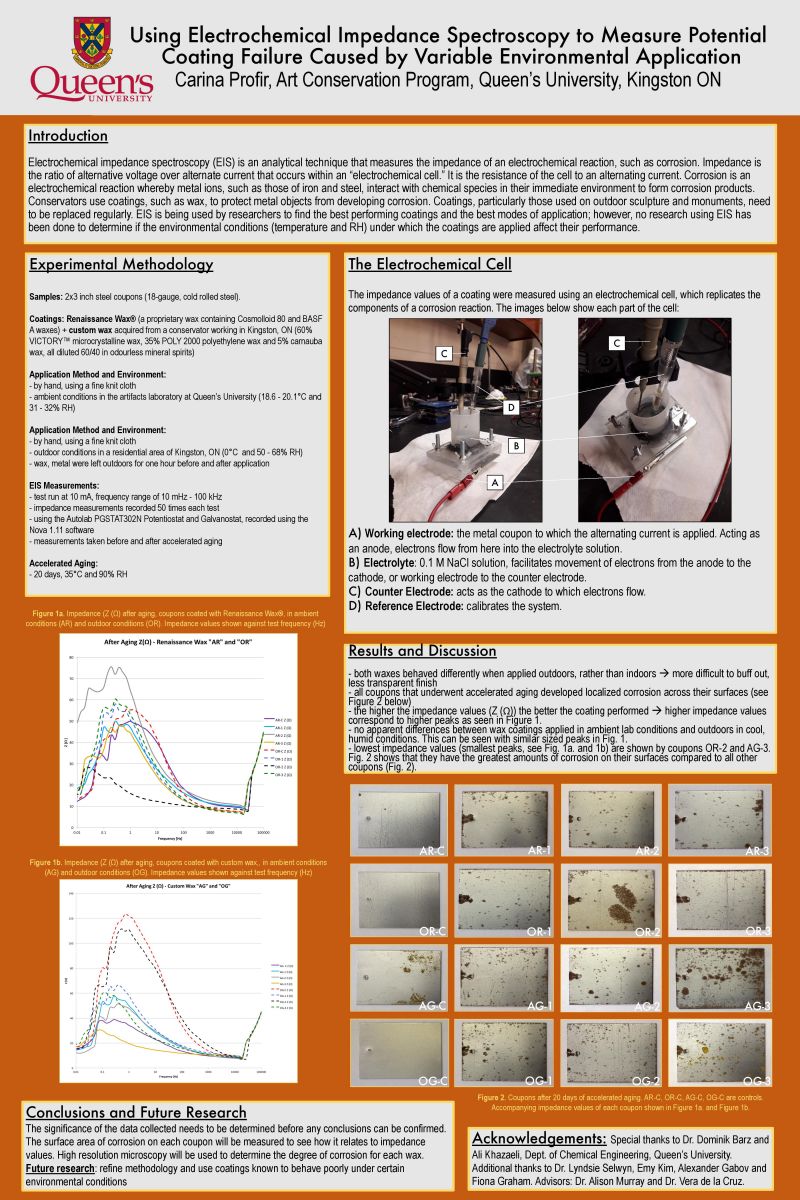 Carina Profir
Carina Profir
Metals exposed to variable and uncontrollable environmental conditions are typically coated in order to protect them and maintain their longevity. Electrochemical impedance spectroscopy (EIS) is a non-destructive method that has been used to measure and predict the performance of a coating on metal. In the context of cultural heritage, EIS has been used extensively to test a number of coatings, especially on bronzes. There has been less published on the use of EIS to test coatings on iron and steel artifacts, which can include anything from historical artifacts, industrial objects, or contemporary sculpture. The quality of a coating depends on a number of factors, including application methods, and temperatures and humidity levels under which the coating should be applied, as recommended by specific manufacturer instructions. However, because of time, budget, and other factors, conservators and heritage technicians may be required to apply these paints or coatings under less than ideal conditions, thus compromising the quality of the coating. EIS was used to detect differences in the performance of wax coatings applied to steel coupons under two environmental conditions: 1) ambient conditions in a conservation laboratory (18 - 20°C, 31 - 32% RH) and 2) outdoor conditions in a residential area (0°C, 50 - 68% RH). EIS measurements of the coupons were taken before and after accelerated aging in a temperature and relative humidity chamber, for a period of 20 days. Preliminary results show great variability in impedance values, Z, from between coupons and coupon set, with higher values for coatings applied outdoors, overall.
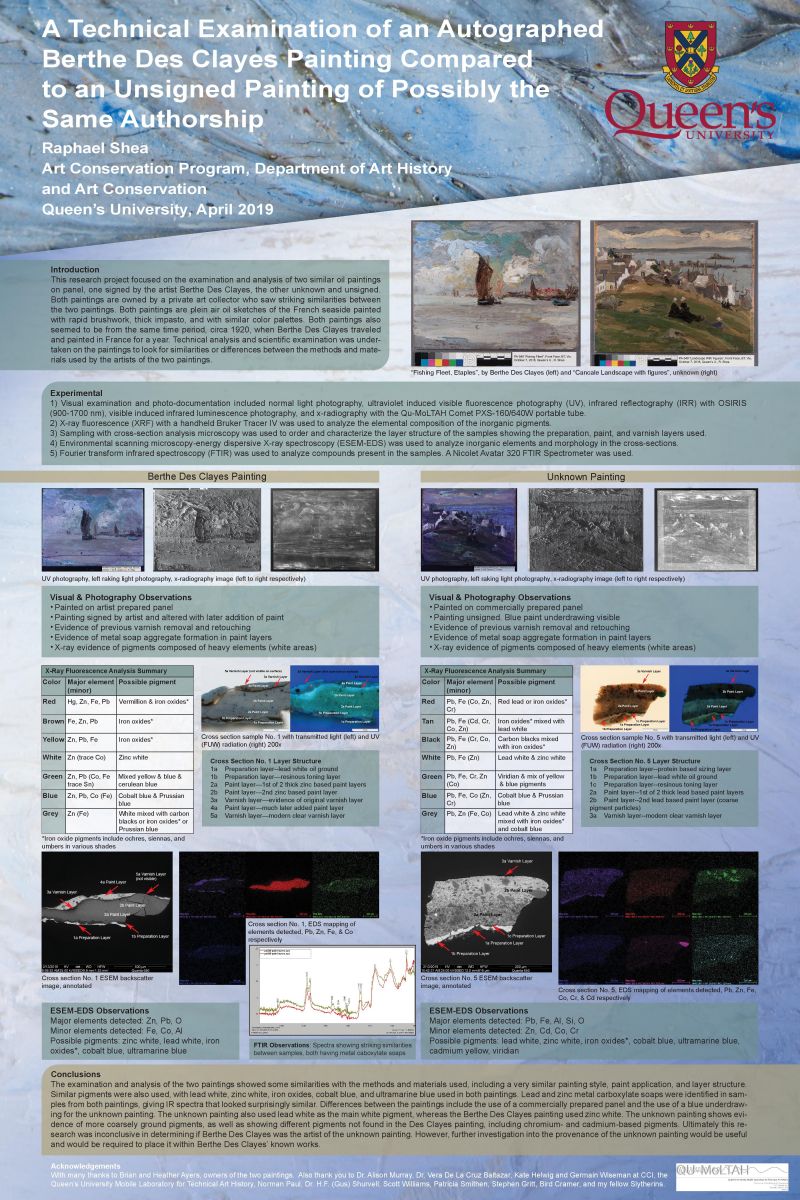 Raphael Shea
Raphael Shea
This research project was initiated after a private art collector believed that two paintings that he and his wife owned looked to be by the hand of the same artist. Both were oil paintings on panel circa 1920 which appeared to be plein air oil sketches depicting scenes from the French coast. Both showed heavy impasto and were painted with a similar gestural manner while showing some similarities in the color palette. One painting was an autographed painting by the Scottish/Canadian artist Berthe Des Clayes; the other was an unsigned painting with the possibility of the same authorship. Using scientific analysis, this technical examination compared the two paintings to determine how similar the methods and materials were. The technical methods of analysis included normal light examination and photography including raking light, ultraviolet radiation, infrared reflectography, and x-radiography. X-ray fluorescence analysis (XRF) was used to analyze the ground and pigment layers. Scientific analysis involved micro samples taken to produce material for infrared spectroscopy (FTIR) and for cross-section analysis with polarized light microscopy (PLM). Further, environmental scanning electron microscopy-energy dispersive x-ray spectroscopy (ESEM-EDS) was employed to better determine the elemental composition of the ground and pigment layers found in the sampled cross sections. The methods of analysis produced many similarities between the paintings, including very similar paint application and layering structure. Other similarities included many common pigments and their use in similar paint layers. FTIR produced strikingly similar spectra from samples taken from each painting. The technical data suggested a consistency between the two works, possibly indicating that the unsigned painting could be by Berthe Des Clayes.
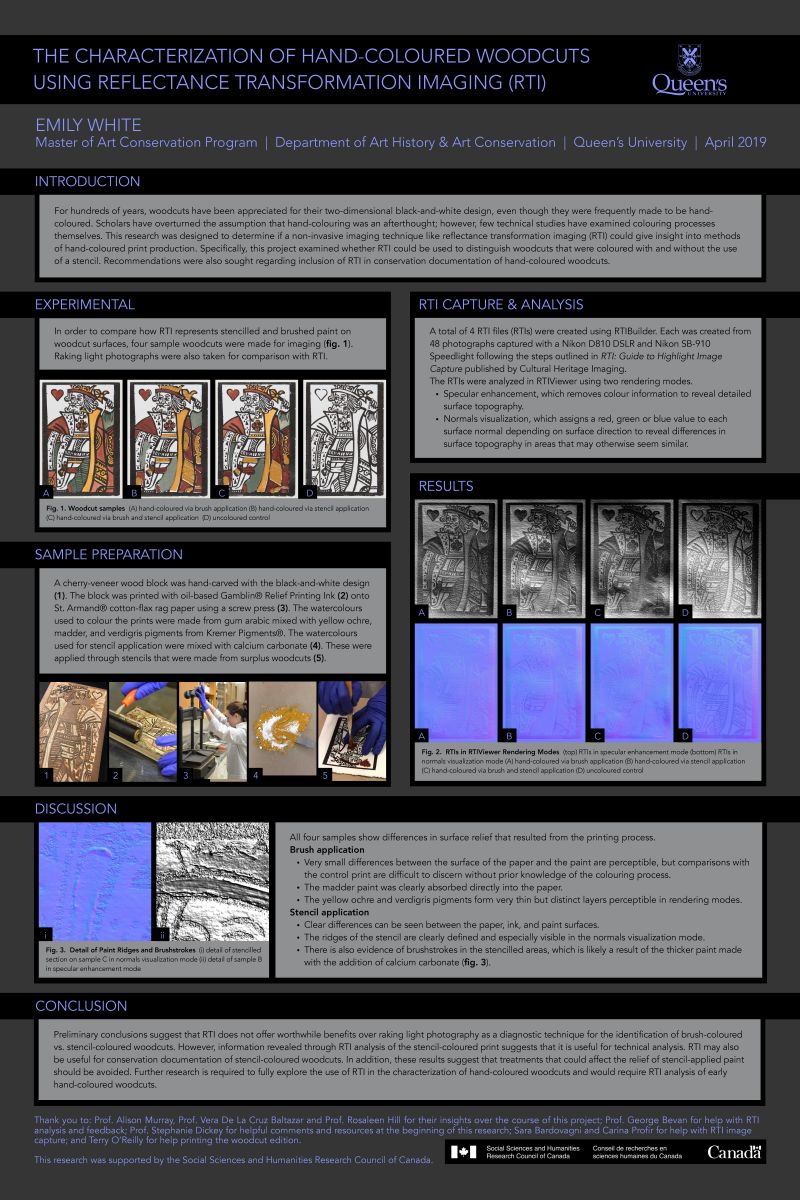 Emily White
Emily White
For hundreds of years, woodcuts have been appreciated for their two-dimensional black-and-white design, although they were frequently made to be hand-coloured. The colour applied to these prints, especially to those produced in the early modern period, has been derided or ignored by writers, omitted from reproductions and catalogues, and even washed off by some collectors. Only recently have scholars begun to overturn the assumption that the addition of colour was secondary to the printing process. Investigations into the language used to describe coloured prints, the roles of production and materials used in printing studios, and the function of prints as objects in the early modern period, have considered the role of colour in early printing. Despite this increased interest, few technical studies have examined how non-invasive imaging techniques can enhance our understanding of coloured print production. This research investigated whether the computational photography technique, reflectance transformation imaging (RTI), can be used to effectively characterize the processes used to hand-colour woodcuts. A woodcut edition was printed, hand-coloured with and without a stencil, and imaged with RTI. The resulting files were analyzed for evidence of colouring processes on the print surface. Analysis showed that RTI is likely unnecessary to characterize hand-colouring processes but revealed that RTI could be useful for the documentation and technical analysis of stencil-coloured woodcuts.
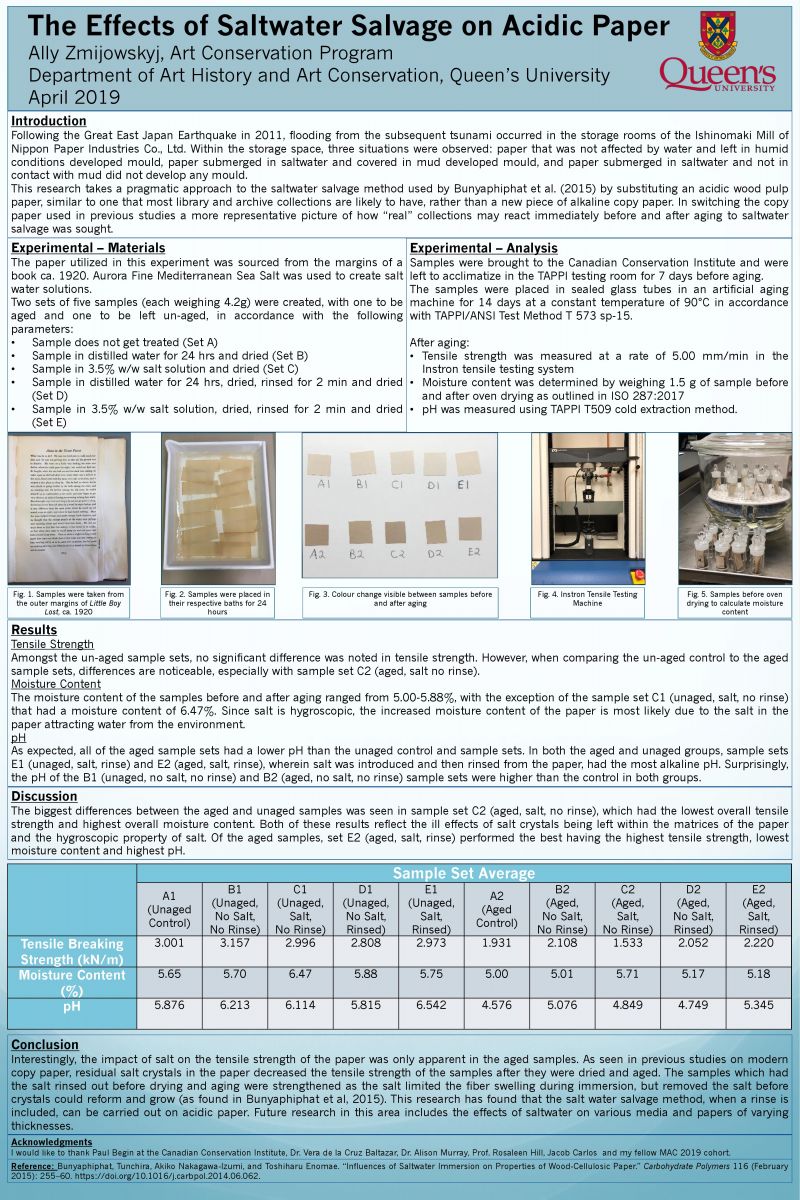 Alexandra K. Zmijowskyj
Alexandra K. Zmijowskyj
After the 2011 earthquake and tsunami in Japan, there were incidents of flooding wherein mould growth was observed on paper objects left in high humidity conditions, but this mould growth was not observed in a saltwater logged paper in the same room. Consequent studies have been carried out on copy paper to assess the efficacy and protocol for using saltwater in disaster recovery situations. However, the lasting effects of such saltwater interactions have not been investigated. This particular research examined the effects of the saltwater salvage treatment on an acidic, wood pulp paper, acting as a representative example of materials that would be found in a library or archival collection. Samples were immersed in a 3.5% aqueous solution of NaCl and then artificially aged in sealed glass tubes at a constant, elevated temperature. The tensile strength, moisture content, thickness, and pH of the samples that have undergone the saltwater salvage process were measured and compared to a control sample to evaluate the impact of the saltwater on the paper. The submersion of paper samples in a salt bath followed by a rinse in distilled water was found to have made the paper stronger and more alkaline than if it was submerged in distilled water alone. These results suggest that the saltwater salvage method, when carried out with a sufficient rinse, does not adversely affect acidic paper.
2017-2018
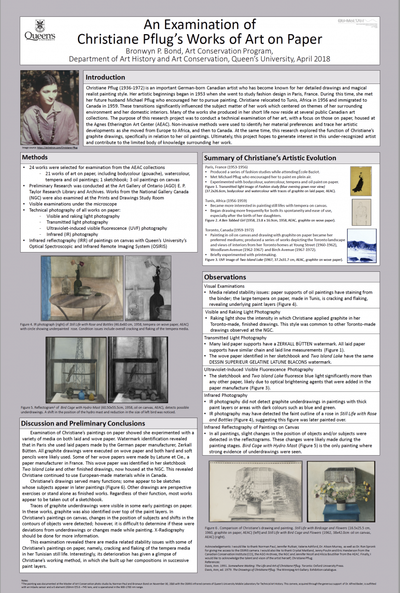 Bronwyn Bond
Bronwyn Bond
Christiane Pflug (1936-1972) is an important German-born Canadian artist who has become known for her unique detailed drawings and magical realist painting style. Her artistic beginnings began in 1953 when she went to study fashion design in Paris, France. During this time, she met her future husband Michael Pflug who encouraged her to pursue painting. Christiane relocated to Tunis, Africa in 1956 and immigrated to Canada in 1959. These transitions significantly influenced the subject matter of her work which centered on themes of her surrounding environment and her domestic interior spaces. Many of the works she produced in her short life now reside at several public Canadian art collections.
The purpose of this research was to conduct a technical examination of her art, with a focus on those on paper, housed at the Agnes Etherington Art Center (AEAC). Non-invasive methods were used to identify her material preferences and trace her artistic developments as she moved from Europe to Africa, and then to Canada. These methods included stereomicroscopy as well as technical imaging using visible light photography, raking light photography, transmitted light photography, infrared (IR) photography, IR reflectography (IRR) and ultraviolet-induced visible fluorescence (UVF) photography. At the same time, this research explored the function of Christiane’s works, specifically, her graphite drawings and their relationship to her oil paintings on canvas. Ultimately, this project hopes to generate interest in this under-recognized artist and contribute to the limited body of knowledge surrounding her work.
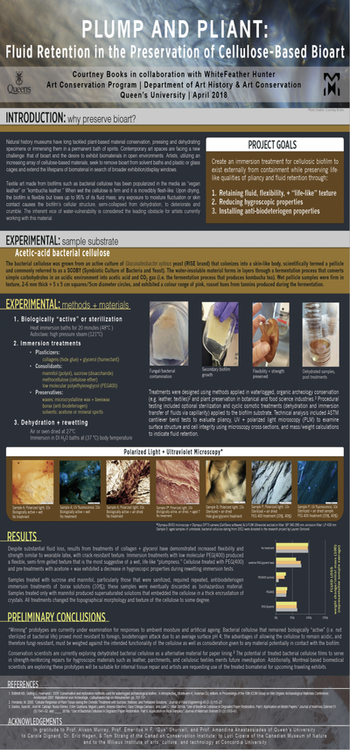 Courtney Books
Courtney Books
Textile bioartists often seek to extend the life spans of biomaterials subject to quick deterioration (e.g. rose-petal tapestries, cellulose-based leather). In compliance with the environmental safety of open-gallery display, bioart must be neutralized of biological activity, demanding the development of preservation methods that provide: 1) for the artist, a retention of the textile material as a plastic, pliant form and 2) for the conservator, the transfer of non-toxic, anti-biodeteriogen, and non-hygroscopic properties to the material.
Intersecting spheres of heritage conservation and material creation, this research presents the results of collaboration between the Art Conservation Program at Queen’s University and textile artist WhiteFeather Hunter at the Speculative Life Biolab, Concordia University. As a preliminary study, the goal was to create an immersion treatment for cellulosic biofilm to exist externally from containment while preserving life-like qualities of pliancy and fluid retention.
Immersion treatments were designed to reduce hygroscopicity and to minimize cellular-wall damage experienced by the biofilms during and after dehydration. Specific materials were tested for their physiochemical performances: collagen as plasticizers, polyols as consolidants, and either sugars or polyether compounds as preservatives. Procedural testing included sterilization and cyclic osmotic treatments (dehydration and immersion transfer of fluids via capillarity) applied to the biofilm test substrate: a yeast-derived, acetic acid bacterial cellulose. Technical analysis included ASTM cantilever bend tests to evaluate pliancy, mass/weight calculations to indicate fluid retention, and polarized light microscopy (PLM) to examine surface structure and cell integrity using microscopy cross-sections. Successful results produced a new form of treated bacterial cellulose that is water-resistant and exhibited an increase in flexibility and tensile strength. This treated cellulose, similar to latex in texture and tensile behavior, may offer applications within textile arts, art conservation, and biomedical fields.
Julia Campbell-Such
The Totem Pole at Belle Park in Kingston, Ontario was carved and painted in 1973 by members of the Native Brotherhood at Joyceville Institution and given to the city of Kingston on the 300th anniversary of colonial settlement in the area. Native Brotherhoods were inmate-run, grass-roots organizations formed to address the social, political, economic and cultural problems that have led to the incarceration of disproportionate numbers of indigenous people in the Canadian prison system. One focus of their activism was the revival of indigenous cultural and artistic traditions. The Belle Park pole is an important historical monument to the early days of this movement, as well as an important record of the history of Indigenous-settler relationships in the region. This project is a technical analysis of this monumental outdoor wooden sculpture, informed by ethical considerations surrounding the conservation of Indigenous art. Investigations centered on identification of the materials used to construct the pole and the extent of their degradation, but also considered intangible characteristics of the artwork. Archival research and community consultations allowed the research to contextualize this sculpture and spark discussions between the Indigenous community and the City of Kingston regarding the significance of the work. An analysis of the structural stability of the pole was conducted using the resistograph instrument. Analysis of paint samples was conducted using x-ray fluorescence (XRF) and Fourier transform infrared spectroscopy (FTIR). Microscopic analysis of wood samples was used to identify the species of wood used and characterize deterioration of the surface. The objective of this analysis was to provide the City of Kingston with data to inform any future conservation work on the pole, and to collaborate with the Kingston Indigenous community to advocate for the preservation of this monument.
Sarah Duffy
The Agnes Etherington Art Centre (AEAC) is home to three photo-transfer prints created by the Montreal-based artist Wendy Simon (1946-2002). These works of art on paper are titled; Pear Around, an oversized blue-coloured print with red crayon additions; Audeladesfemmes 1, a black and white print with layered papers and; etude en trois ecorces, a composite, tri-coloured print. A combination of documentary, observational and analytical techniques have been used to form a technical analysis of these three works for the purpose of identification and to gain insight into Simon’s process. An additional 22 works from the AEAC collection were selected and documented to form a reference collection for comparison and identification. The Simon works have been photographed using reflected light, raking light, UV illumination and infrared photography, with associated condition reports produced to inform their formation. Sampling and analysis of paper and adhesive samples has also been conducted to identify paper types and the adhesive tapes used. These methods positively identified Pear Around as a cyanotype, Audeladesfemmes 1 as a photo-transfer etching, and etude en trois ecorces as a chine collé print. Condition issue have been highlighted and reported to the AEAC for their consideration.
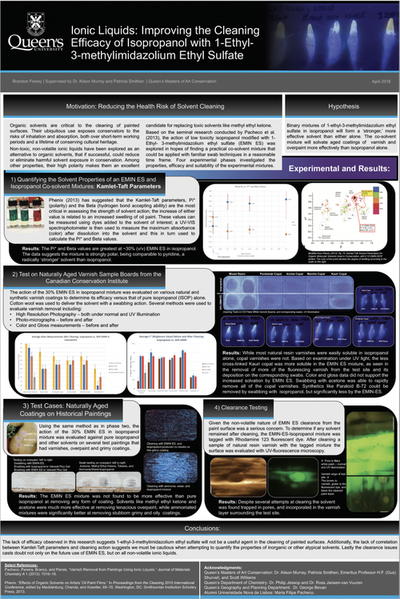 Brendan Finney
Brendan Finney
The substitution of toxic, volatile organic solvents for ionic liquids may hold several advantages for practising conservators, as ionic liquids like 1-ethyl-3-methylimidazolium ethyl sulfate are practically non-volatile, completely non-toxic, and non-irritating. In 2013, Pacheco et al. published their results on the first use of ionic liquids as alternatives for organic solvents in the removal of varnish from painted surfaces. The results showed promise, but several time-consuming applications of prohibitively expensive ionic liquids were necessary to remove test coatings. More recent research on the properties of ionic liquids as solvents suggested that binary mixtures of ionic liquids and organic solvents may prove more effective at solvating these coatings than ionic liquids alone, while only using a fractional proportion of ionic liquid. By combining the well-known properties of isopropanol with the ionic liquid 1-ethyl-3-methylimidazolium ethyl sulfate, new low-toxicity solvent mixtures may be formed that mimic the qualities of so-called ‘stronger,’ and often noxious, organic solvents. Mixtures of isopropanol and 1-ethyl-3-methylimidazolium ethyl sulfate were first characterized by spectroscopic determination of Kamlet-Taft (KAT) parameters. Solvent mixtures were then tested on naturally aged varnish sample boards made at the Canadian Conservation Institute in 1994 and several historical works in the Queen’s Masters of Art Conservation study collection. Clearance testing was undertaken with Rhodamine 123. Results suggest that this binary mixture is not effective, and that ionic liquids should be used with caution on paint surfaces due to clearance issues.
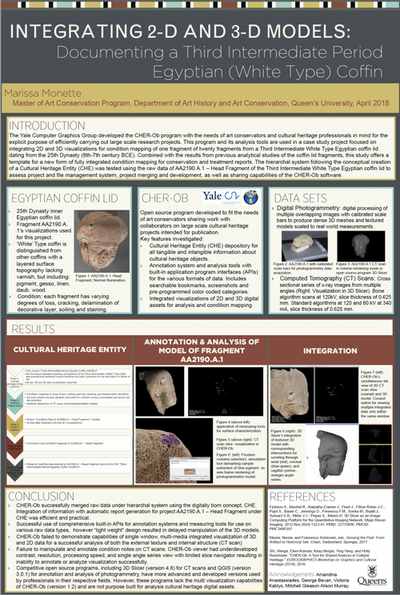 Marissa Monette
Marissa Monette
Conservators and related professionals in the field of cultural heritage are collaborating with specialists in computer science and geography to advance the application of imaging techniques in cultural heritage that enable a greater understanding of materials, original use, and construction of artifacts. This research project focuses on applying techniques from these interdisciplinary collaborations in the context of object conservation by using 2-dimensional and 3-dimensional imaging techniques to analyze a Third Intermediate White Type Egyptian coffin lid dating from the 25th Dynasty (8th-7th century BCE). The primary goal is to integrate the enhanced internal structural information from computed tomographic (CT) scanning and surface topographical information gained from photogrammetry using the open source software CHER-Ob (Cultural Heritage Object), developed by Yale University's Computer Graphics Group. The intention behind the standardization of a digital workflow for the integration and preservation of the digital models, specifically the head model is to produce a usable workflow from this project for the remaining seventeen fragments of this Egyptian White Type coffin lid. The integrated models in CHER-Ob, combined with the results from previous analytical studies of the coffin lid fragments, offers a template of integrated photogrammetry and CT data in the visual sense only. This improves upon the accessibility of using this data for condition mapping for conservation and treatment reports. The information gleaned from the integration of the digital models with CHER-Ob relates to the limitations of open source software within the cultural heritage sector operating as a single entity.
Valerie Moscato
The arrival of three paintings by Canadian artist Graham Coughtry (1931-1999) at the Queen’s University Master of Art Conservation program prompted this investigation into the artist’s practice. The paintings, which date from the 1950s and early 60s, were created in a period of Canadian art marked by a rebellion against figurative modes of representation and the integration of new, commercially developed painting materials. Coughtry, who is known for his reconciliation of the human figure with the period’s demand for abstraction, participated in the exploration of new paint media by combining traditional oil paints and Lucite 44, a poly(n-butyl methacrylate) resin. By characterizing the artist’s use of these binding media within the three paintings, this project seeks to better understand Coughtry’s working methods and contribute to the larger narrative of experimental paint use in Canada during the 1950s and 60s. Each painting underwent non-destructive examination documented via photography in visible reflected light, raking light, ultraviolet-induced fluorescence (UVF), and infrared reflectography (IR). Minimally invasive analysis of paint samples from each painting was performed first by plane polarized light microscopy (PLM) and ultraviolet microscopy (UVM) to understand the paintings’ layering structures, while analysis via Fourier transform infrared spectroscopy (FTIR) was performed to characterize the binding media. A method for determining a relative concentration of the constituent binders in the paint media was designed by comparing the spectra of prepared test films combining linseed oil and Lucite 44 in known concentrations to the spectra of paint samples with perceived Lucite 44 application. This analysis is contextualized by archival research of materials from the artist’s estate, informal interviews with members of the artist’s network, and FTIR analysis of Coughtry’s paintings with known Lucite 44 application from the National Gallery of Canada (NGC) in partnership with the Canadian Conservation Institute (CCI). While this research helped to inform the paintings’ conservation treatments by characterizing the materials present, the project could be beneficial for the broader understanding and care of Canadian artworks from this period.
Lauren Nadine Osmond
In the mid-nineteenth century, iridescent Jewel beetle elytra were used to adorn textiles being produced in India, specifically for British export. The Victoria and Albert Museum (V&A) owns many of these luxurious objects in their South Asia collections and continues to acquire such objects. During the conservation treatment of a nineteenth-century beetle elytra skirt panel (4411(IS)) at the V&A, it was observed that the colour of the elytra had shifted from a vibrant green to blue-violet where the elytra had been exposed to light, likely while being on display for decades after it was acquired in 1858. Many loose elytra from the textile had distinct stripes across the surface where embroidery thread had blocked the light. The iridescence and colour in this type of beetle, Buprestidae Julodinae Sternocera aequisignata, is structurally produced by many layers of chitin-protein fibres, meaning that this change in colour is the result of a structural change in the elytron microstructure. To inquire into this phenomenon, experiments were completed to replicate the colour shift. Modern beetle elytra of the same species were sourced and artificially aged by subjecting them to high exposure of light, temperature and relative humidity. These elytra were examined before and after aging using confocal microscopy to observe and measure the changes in the layering structure of the elytra. A preliminary survey of the beetle embellished textiles found in the V&A’s South Asia collection was also incorporated into this research project in an effort to provide insight into other contributing factors to this colour change, and also to provide guidance in future conservation treatments and methods of storage and display.
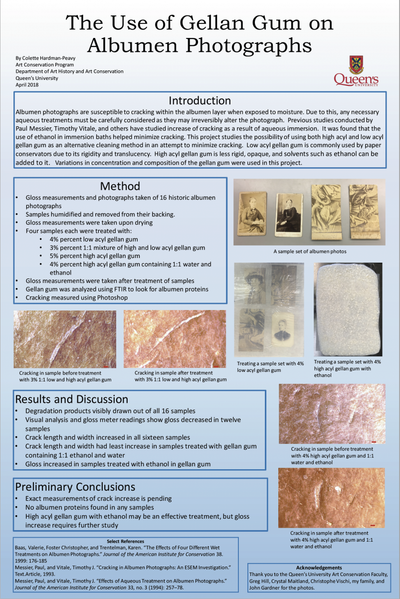 Colette Hardman-Peavy
Colette Hardman-Peavy
Aqueous immersion is sometimes used to clean badly degraded albumen photographs. Previous research has shown that the introduction of moisture causes an increase of cracking within the albumen layer of the photograph, and can result in a decrease in gloss and change in surface texture. Gellan gum, increasingly used as a cleaning method by paper conservators may be a more controlled alternative to aqueous cleaning treatments, such as immersion. This project studies the physical effects that gellan gum has on albumen prints, focusing specifically on the cracking within the albumen layer. Increase in crack size, number of cracks, surface gloss, and change in surface texture were measured prior to the use of the gel, as well as afterwards. The gellan gum was analyzed using Fourier transform infrared spectroscopy to look for evidence of albumen and gelatin proteins. The results were compared to one another to determine which gel may be most effective for this treatment. Gloss measurements were examined in an effort to determine if treatment with gellan gum was less detrimental than aqueous immersion. Results of the study were mixed, but crack length, width, and number increased in all cases and gloss decreased. This study should be seen as a preliminary investigation into gellan gum, and more study is needed to determine whether it is a viable cleaning option for albumen photographs.
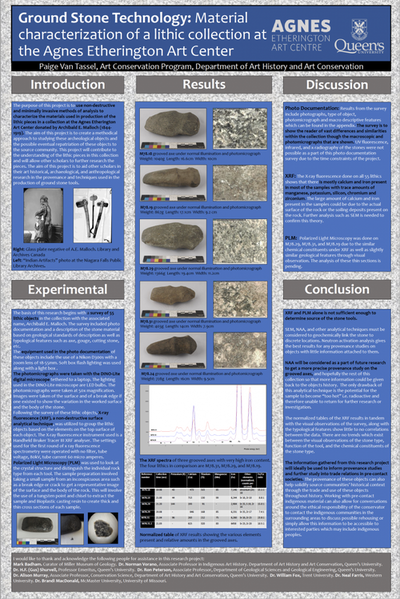 Paige Van Tassel
Paige Van Tassel
The purpose of this project was to use non-destructive and minimally invasive methods of analysis to characterize the materials used in production of the lithic pieces in a collection at the Agnes Etherington Art Centre donated by Archibald E. Malloch (1844-1919). The aim of this project is to create a methodical approach to studying these archeological objects and the possible eventual re-housing of these objects to the source community. This project examines the lithic collection with several instrumental techniques such as a stereomicroscope for surface analysis, X ray fluorescence (XRF) spectroscopy and polarized light microscopy (PLM). This project has contributed to the understanding of the lithic pieces in the Agnes collection and allow other scholars to further research the pieces. The aim of this project was to aid other scholars in their art historical, archaeological, and anthropological research in the provenance and techniques used in the production of ground stone tools. The results of this research project have allowed the Agnes Etherington Art Centre to publish the photos on their website to be accessible to a large audience who is interested in ground stone technology and production. The XRF and PLM results can be used by other scholars to further analyze semi-qualitative date from the XRF results and definitive material stone types from the PLM results.
2016-2017
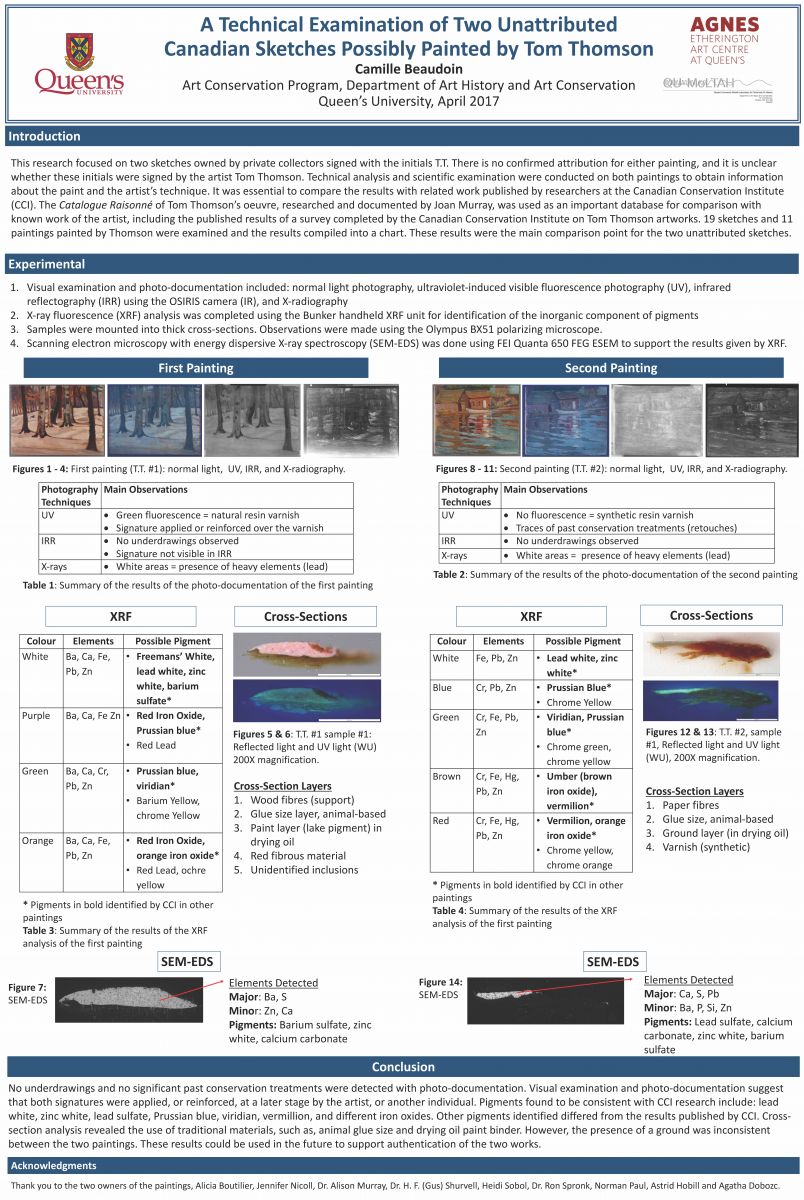 Camille Beaudoin
Camille Beaudoin
This research project was performed in collaboration with the Agnes Etherington Art Centre and the Art Gallery of Hamilton. These two galleries are working on an upcoming exhibition, which will include two paintings signed with the initials T.T. There is no confirmed attribution for either painting and it is unclear whether these initials were signed by the artist Tom Thomson. This research project focused on technical analysis methods applied to these two sketches, including normal light photography, ultraviolet examination, infrared reflectography (IRR), X-ray photographic examination, and X-ray fluorescence analysis. The equipment used for infrared reflectography and x-radiography belongs to QU-MoLTAH, a mobile laboratory for technical art history run by Professor Ron Spronk at Queen’s University. Scientific examination including micro-sampling, with the agreement of the owners, and scanning electron microscopy-energy dispersive X-ray spectroscopy (SEM-EDS), were performed to obtain more information about the paint and the technique of the artists. It was essential to compare the results with the related work published by researchers at the Canadian Conservation Institute (CCI). Other published literature regarding the materials used by Tom Thomson and the Group of Seven were used as sources of information for this research project. In conclusion, this research provided information about the materials and techniques of the two paintings, which in some cases corresponded to the information collected by CCI about Thomson’s material and technique. Other results did not correspond completely with CCI’s results on other paintings; however, further analyses are necessary, including the identification of supports.
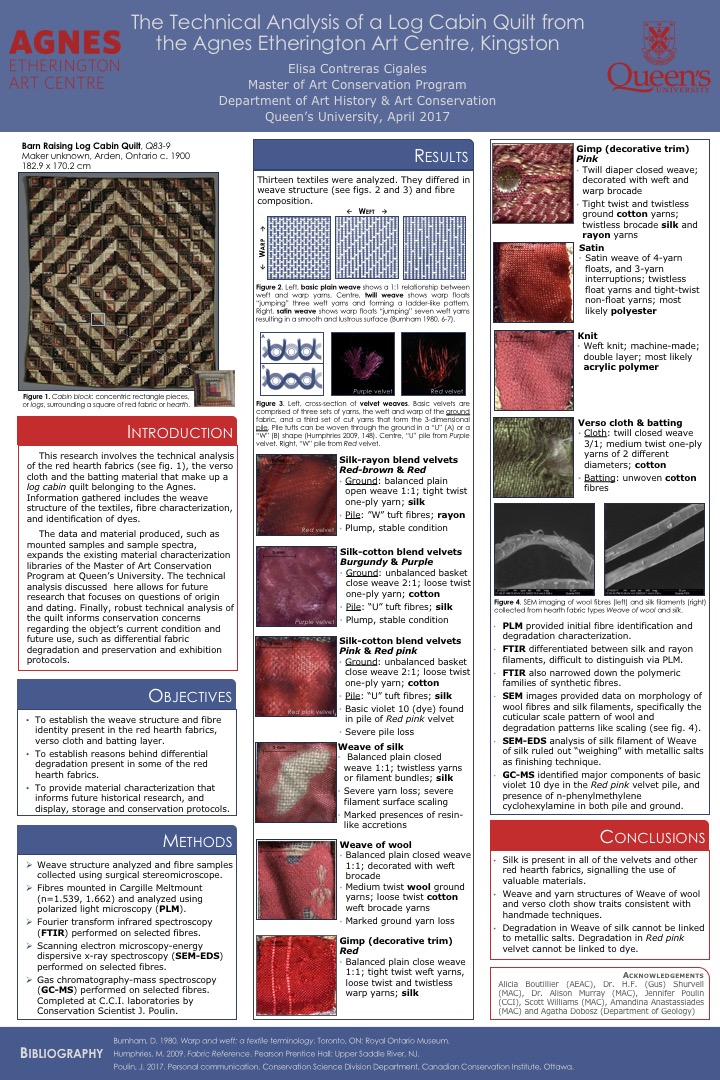 Eliza D. Contreras Cigales
Eliza D. Contreras Cigales
The Agnes Etherington Art Centre is steward to the Heritage Quilt Collection, consisting of over 44 textile objects. The Agnes has limited information on the material composition of these quilts and their historical antecedents. This research project involves the technical analysis of the major textiles components of a quilt bearing a log cabin pattern. This project principally looks at the red hearth fabrics, the verso cloth and the batting material that make up the quilt. Information gathered includes the weave structure of the textiles, fibre characterization, and dye and finishes identification. For these purposes, analytical techniques used were optical microscopy, scanning electron microscopy-energy dispersive X-ray spectroscopy (SEM-EDS), and Fourier transform infrared spectroscopy (FTIR) to carry out fibre characterization. Gas chromatography-mass spectroscopy (GC-MS) completed the analysis of dyes and finishes. The information gathered and material produced, such as mounted samples and sample spectra, expand the existing material characterization libraries of the Master of Art Conservation Program at Queen’s University. The technical analysis of this quilt is supported by the examination of its manufacturing methods and the analysis of its raw materials, which in turn allow for future research that focuses on questions of origin and dating. Finally, robust technical analysis of the quilt informs conservation issues stemming from the object’s current condition and future use, such as differential fabric degradation and preservation and exhibition protocols.
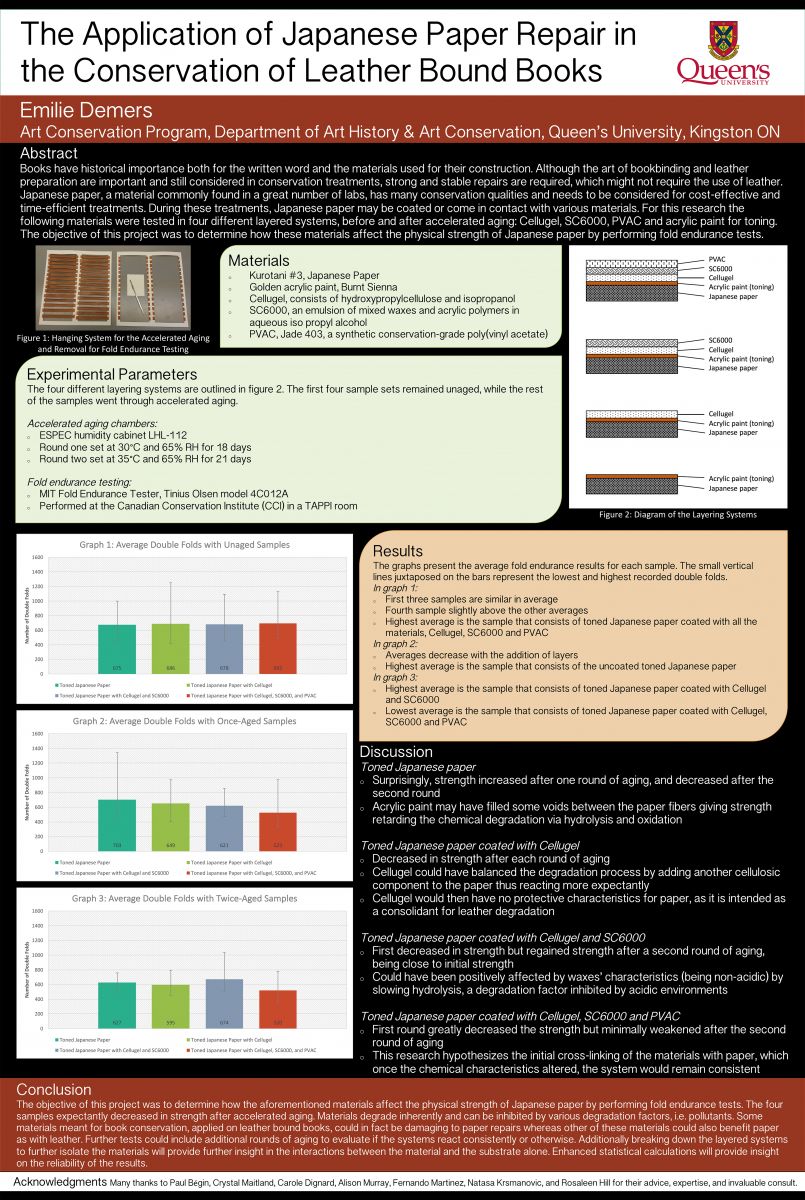 Emilie Demers
Emilie Demers
Since the invention of printing, information dissemination has increased importantly; books have historical importance both in the written word and the materials used for their construction. Bookbinding can give great insight in the bookbinder’s skills, the time period and common practices, the geographical location, the socio-economic situation and many more factors. Looking at the increasing number of books in need of conservation, many techniques have been developed in the last few decades. Knowing the number of books only keeps growing indicates a long future for book conservation and the need for research looking for alternative solutions. In order to accommodate the ever growing demand, such solutions have explored how to create strong and stable repairs which do not require the use of leather. The workmanship of leather preparation is important in the transmission of knowledge. These skills allow for a better comprehension of the materials and how they behave under various conditions through bookbinding, crucial in book conservation. Although the art of bookbinding and leather preparation are important and still considered in conservation, other options include the use of Japanese paper. These options prove to be cost effective and time efficient. Japanese paper is a material commonly found in a great number of labs and has many conservation qualities. During treatment, it may be coated or come in contact with various materials. For the purpose of this research, a selection of three materials were tested on Japanese paper toned with acrylic paint: Cellugel, SC6000, and PVAC. The object of this project is to observe how these materials affect the physical strength of Japanese paper by performing a fold endurance test. In order to observe the viability of such solutions through time, two thirds of the samples underwent accelerated aging. The results from the fold endurance testing show that all the samples decrease in strength after two rounds of aging although the Toned Japanese paper coated with Cellugel and SC6000 had close to the same strength as the unaged sample. Other surprising results were after one round of aging where the Toned Japanese paper increased in strength, as opposed to all the other samples. The Toned Japanese with Cellugel and the Toned Japanese paper with Cellugel, SC6000 and PVAC both decreased drastically. The former after a second round of aging, while the latter after the first round of aging.
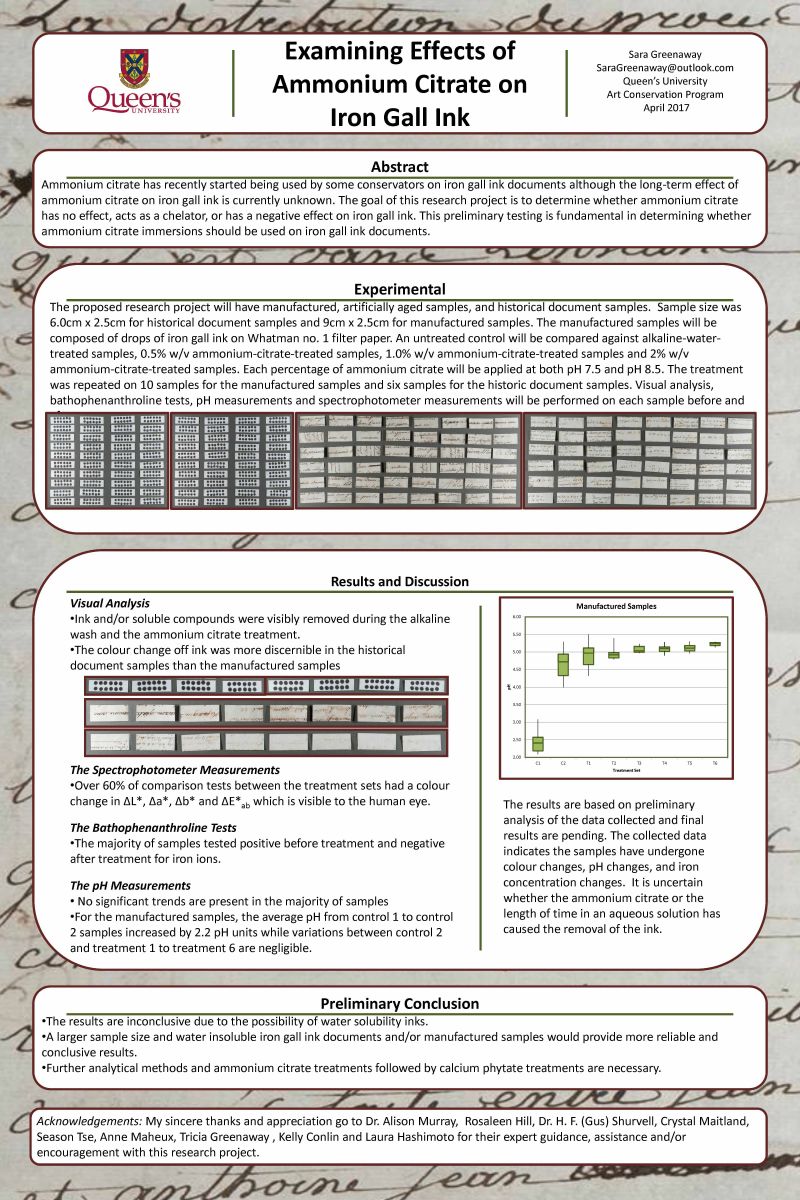 Sara Greenaway
Sara Greenaway
Ammonium citrate has recently started being used by some conservators on iron gall ink documents although the long-term effect of ammonium citrate on iron gall ink is currently unknown. The goal of this research project was to determine whether ammonium citrate has no effect, acts as a chelator or has a negative effect on iron gall ink. The research project had manufactured, artificially aged samples, and historical document samples. The manufactured samples were composed of drops of iron gall ink on Whatman no. 1 filter paper. An untreated control was compared against alkaline-water-treated samples, 0.5% w/v ammonium-citrate-treated samples, 1.0% w/v ammonium-citrate-treated samples and 2% w/v ammonium-citrate-treated samples. Each percentage of ammonium citrate was applied at both pH 7.5 and pH 8.5. X-ray fluorescence (XRF) analysis, pH measurements, bathophenanthroline tests and spectrophotometric measurements were performed on each sample before and after treatment. In general, the pH of the manufactured samples increased slightly while the pH of the Italian historical document samples decreased slightly. No major trends were observed for the French historical document samples. Overall, the majority of the samples tested positive for iron ions before treatment and negative for iron ions after treatment. It is uncertain whether the removed iron ions are soluble acidic compounds, the iron gall ink itself, or both. The removal of these metallic compounds caused many of the samples to darken (a decrease in ΔL*), redden (an increase in Δa*) and yellow (an increase in Δb)* in the manufactured samples while no trends were observed in the French and Italian historical document samples. Only a small percentage of samples showed a significant colour change visible to the naked eye in the overall colour difference, ΔE*ab, of iron gall ink which could indicate that ammonium citrate treatments do not destroy the iron gall ink complex. This preliminary research project is only a first step in determining whether ammonium citrate immersions should be used on iron gall ink documents. Further research is required.
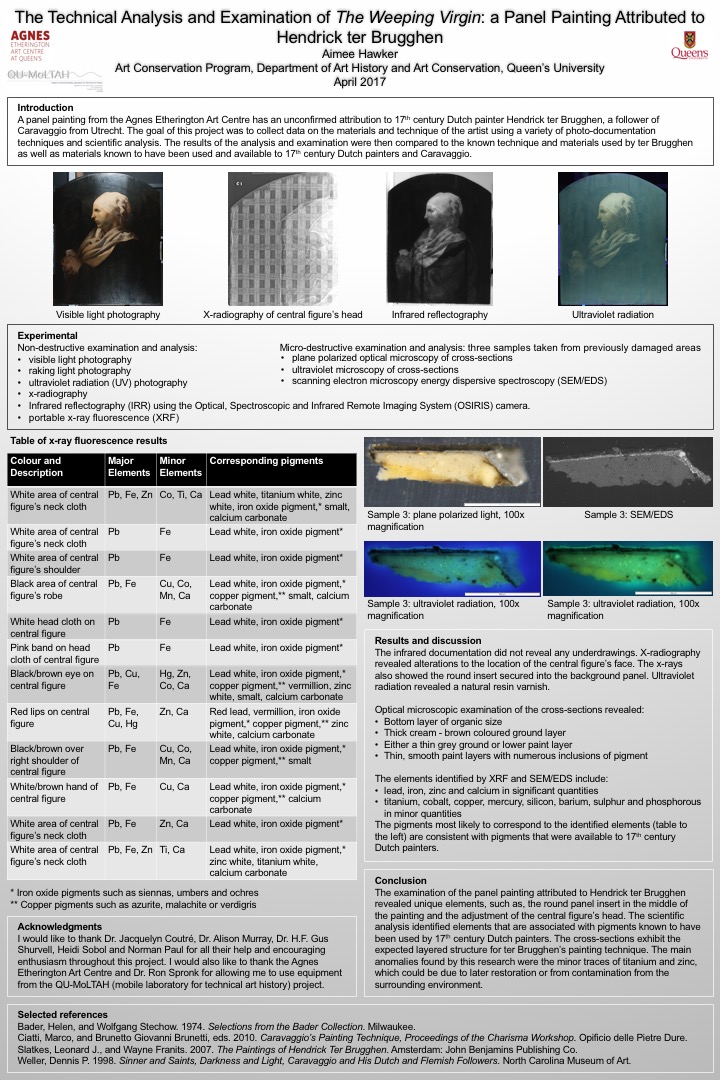 AImee Hawker
AImee Hawker
This project was fulfilled in partnership with the Agnes Etherington Art Centre. At the gallery there is a painting with an unconfirmed attribution, which could benefit from further study. The artwork consists of a pair of wood panels painted with oil medium, one panel depicts the Virgin and the other comprises the background; the Virgin panel is inserted into the larger background panel. These paintings have a tentative attribution to Hendrick ter Brugghen and are approximately dated to 1621 for the figure and 1629 for the other compositional elements. This project used analytical methods in order to provide insight into the materials and techniques of the artist. The imaging techniques consisted of ultraviolet radiation and infrared light to provide evidence, such as, the composition of pigment and underlying layers. The analytical methods include x-ray fluorescence (XRF), x-radiography, scanning electron microscopy / energy dispersive x-radiography spectroscopy and gas chromatography – mass spectroscopy. These paintings could also benefit from examination of the wood, either using dendrochronology or identification of the species, for dating evidence. By completing this project the gallery gains valuable insight into the potential pigment and material composition, construction and structure of the artwork, which can lead in the future to increased confidence in attribution.
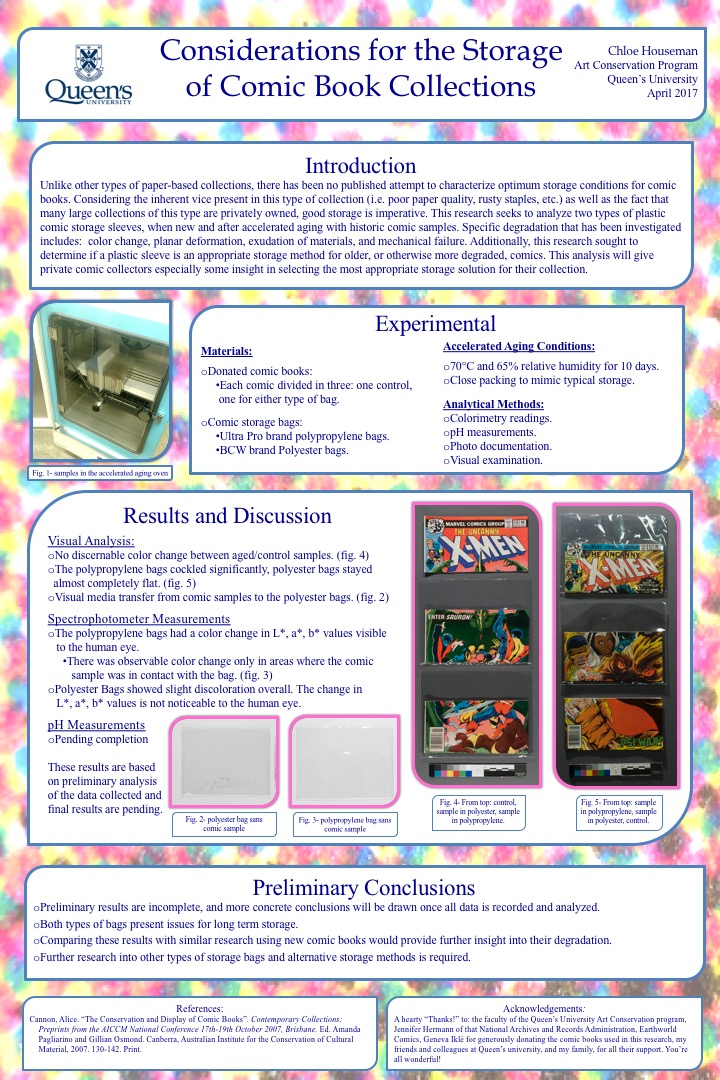 Chloe Houseman
Chloe Houseman
Unlike other types paper-based of collections, there has been no published attempt to characterize optimum storage conditions for comic books. Considering the inherent vice present in this type of collection (i.e. poor paper quality, rusty staples, etc.) as well as the fact that many large collections of this type are privately owned, good storage is imperative. This research seeks to analyze two types of plastic comic storage sleeves, both when new, and after being aged with historic comic samples. This accelerated aging provided insight into how these bags may degrade, including: color change, physical deformation, and media transfer. Additionally, the experiment sought to determine if a plastic sleeve is an appropriate storage method for older, or otherwise more degraded, comics. The comics were also examined both pre- and post-aging. This study found that polyester bags hold their shape, but are more likely to have ink transfer from the comic books, but polypropylene bags cockle and discolor with minimal ink transfer. This analysis gives private comic collectors especially some insight in selecting the most appropriate storage solution for their collection.
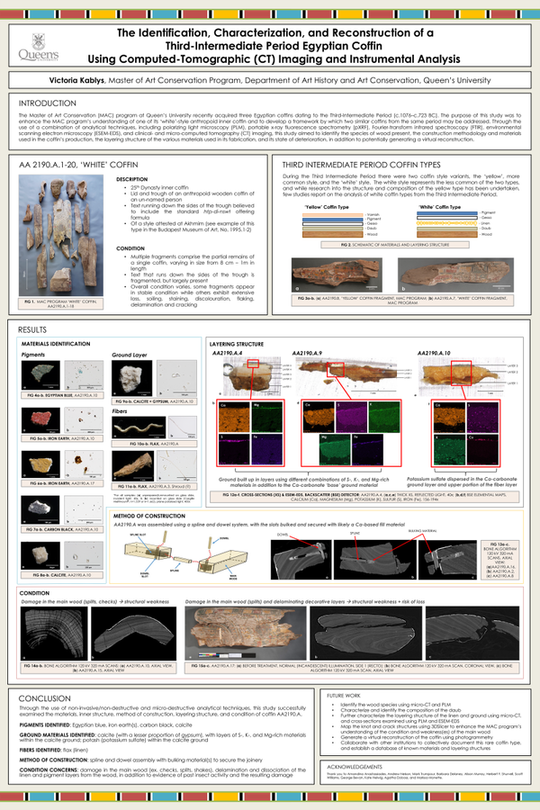 Victoria Kablys
Victoria Kablys
The Master of Art Conservation (MAC) program at Queen’s University recently acquired three Egyptian coffins dating to the Third-Intermediate Period (c.1076–c.723 BC). While preliminary analysis was conducted by students in the MAC program to identify the pigments and layering structure of the coffins’ painted elements, both the types of wood and the construction techniques used in their manufacture remained unexplored. This research project focused on identifying and analyzing the wooden component and layering structure of the MAC program’s 25th Dynasty ‘white’ coffin (AA2190.A) using non-destructive and micro-destructive analytical techniques including: polarizing light microscopy (PLM), portable x-ray fluorescence spectrometry (pXRF), Fourier transform infrared spectroscopy (FTIR), scanning electron microscopy with energy dispersive x-ray spectroscopy (SEM-EDS), and clinical and micro- computed tomography (CT) imaging. This research served as a pilot project in establishing a framework by which to address the program’s two remaining coffins, while exploring the application of a variety of analytical techniques through multi-disciplinary and collaborative research. Non-invasive/non-destructive and micro-destructive analytical techniques allowed for the successful characterization of white coffin’s materials, inner structure and method of construction, layering structure, and condition. The results of this research include the identification of the pigments, fibers, and ground layers; the exploration and elucidation of the spline and dowel construction system; the preliminary characterization of the layering structure of the coffin’s preparatory and decorative elements; and the documentation of areas of damage, loss and vulnerability. Information gathered from this study was instrumental in the characterization of the white coffin and its state of preservation, and in contributing information that will guide conservators in establishing the parameters of its conservation treatment.
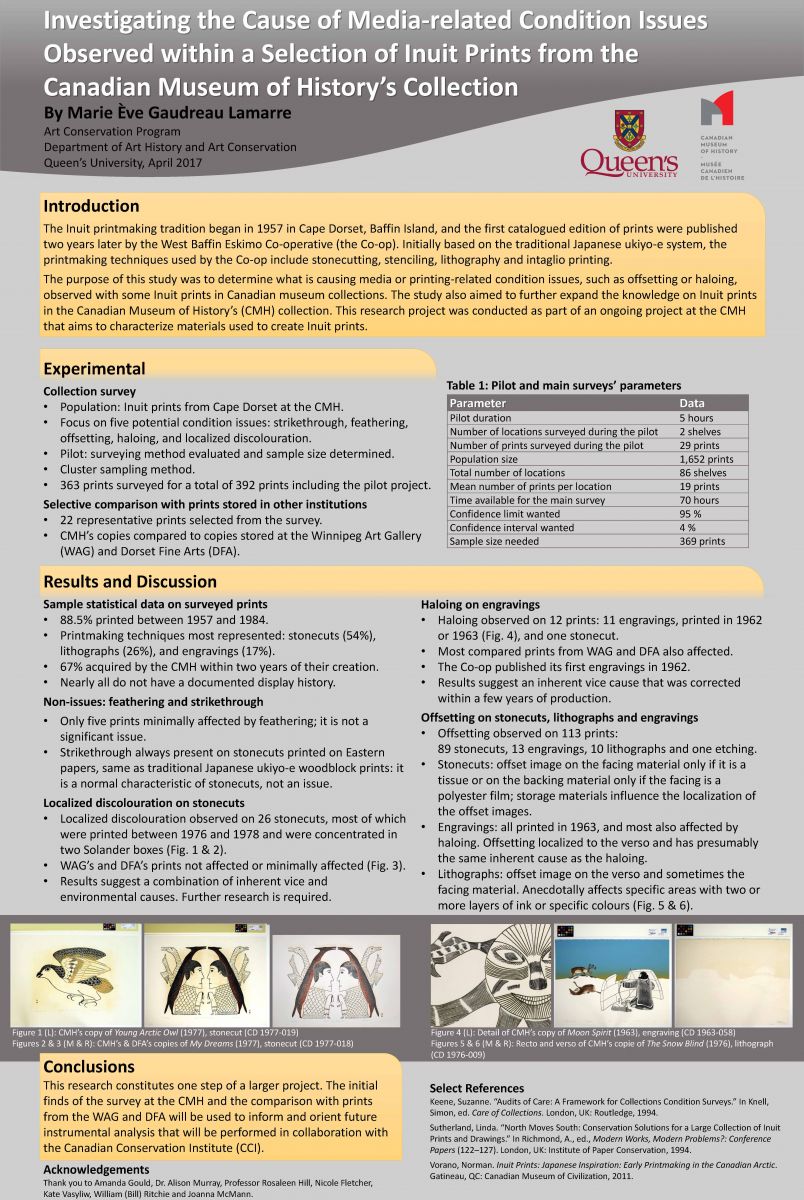 Marie Éve Gaudreau Lamarre
Marie Éve Gaudreau Lamarre
The purpose of this study is to determine what is causing media-related condition issues, such as offsetting or haloing, observed with some Inuit prints at the Canadian Museum of History (CMH). The media, support, printing technique and environmental conditions were studied as potential causes. A survey of CMH’s prints, supported by a comparison with prints exhibited or stored in other institutions such as the Winnipeg Art Gallery, looked at storage conditions and display history to determine if any issues are caused by environmental conditions. In addition, archival research offered more insight on techniques and specific products used. It was determined that feathering is not a significant issue, that strikethrough is a normal characteristic of stonecuts printed on Eastern papers, and that haloing is mostly only affecting the first few editions of engravings. Offsetting of the oil binder, by far the most common issue, is presumably caused by inherent vice in the ink; however, the location of the offsetting appears to be influenced by the paper substrate and the storage material in direct contact with the prints. Finally, localized discolouration found on some stonecuts from the late 1970s is suspected to be the result of combined offsetting from several prints catalyzed by past storage conditions. This research project has been conducted as part of an ongoing project at the CMH that aims to characterize materials used to create Inuit prints. The project aimed not only to broaden curators’ and conservators’ knowledge of this traditional and contemporary artistic process but also aimed to benefit Inuit artists and printmakers.
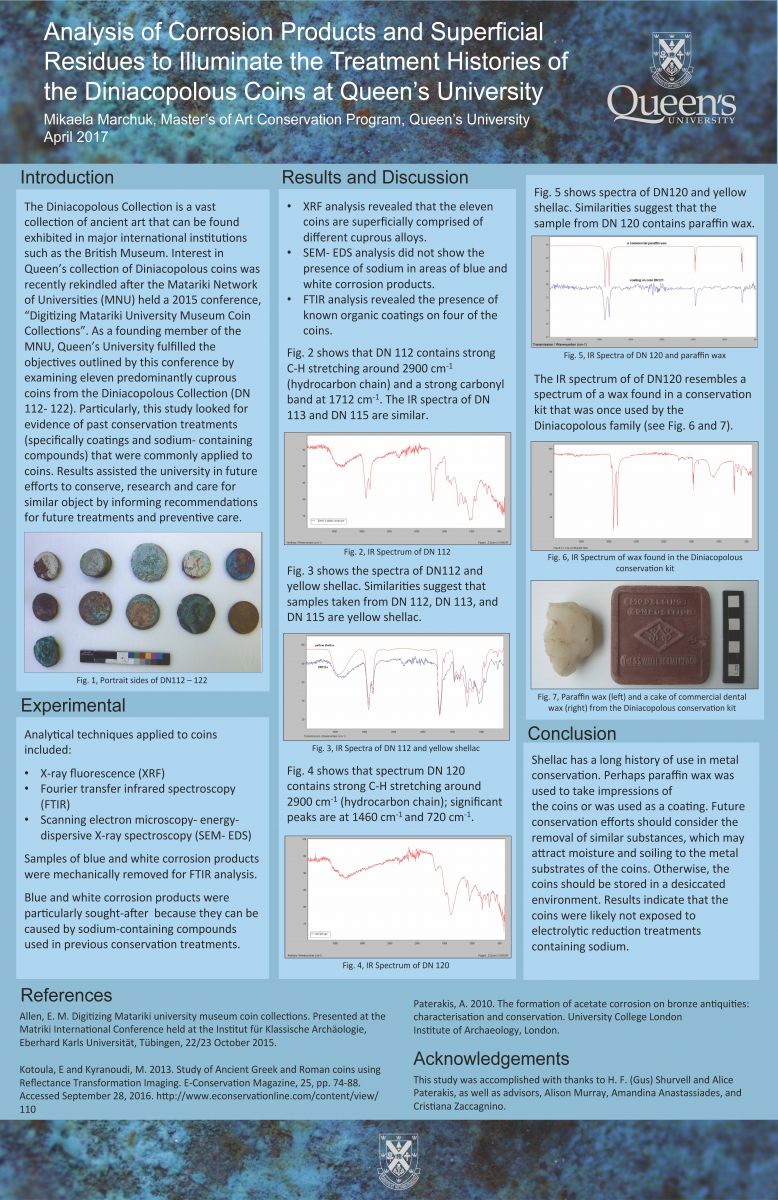 Mikaela Marchuk
Mikaela Marchuk
The Diniacopolous Collection is a vast collection of ancient art that can be found exhibited in major international institutions, such as the British Museum. Interest in Queen’s collection of Diniacopolous coins was recently rekindled after the Matariki Network of Universities (MNU) held a 2015 conference, “Digitizing Matariki University Museum Coin Collections”. As a founding member of the MNU, Queen’s University fulfilled the objectives outlined by this conference by examining eleven predominantly cupreous coins from the Diniacopolous Collection. Particularly, this study looked for evidence of past treatments (specifically, coatings and sodium-containing compounds) that were commonly applied to coins. Analytical techniques used in this study included X-ray fluorescence (XRF), Fourier transfer infrared spectroscopy (FTIR), and scanning electron microscopy energy-dispersive X-ray spectroscopy (SEM-EDS). While XRF and SEM-EDS analysis revealed little information about the treatment histories of the coins, FTIR confirmed that yellow shellac and paraffin wax are present on the surfaces of some specimens in Queen’s possession. Results assisted the University in future efforts to conserve, research and care for similar objects by informing recommendations for future conservation treatments and ongoing preventive care.
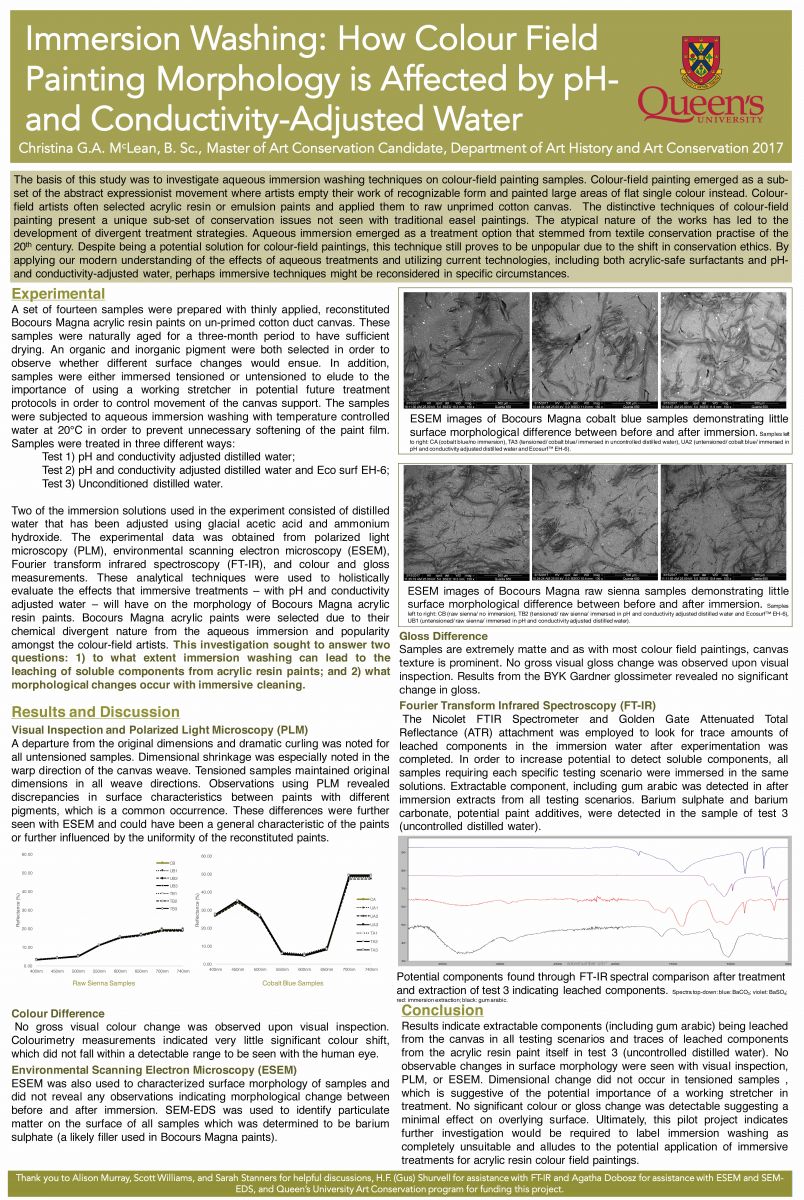 Christina G.A. McLean
Christina G.A. McLean
The basis of this study was to investigate aqueous immersion washing techniques on colour-field painting samples. Colour-field painting emerged as a sub-set of the abstract expressionist movement where artists emptied their work of recognizable form and painted large areas of flat, single colour instead. Colour-field artists often selected acrylic resin or emulsion paints and applied them to raw unprimed cotton canvas. The distinctive techniques of colourfield painting present a unique sub-set of conservation issues not seen with traditional easel paintings. The atypical nature of the works has led to the development of divergent treatment strategies. Aqueous immersion emerged as a treatment option that stemmed from textile conservation practise of the 20th century. Despite being a potential solution for colour-field paintings, this technique still proves to be unpopular due to the shift in conservation ethics. By applying our modern understanding of the effects of aqueous treatments and utilizing current technologies, including both acrylic-safe surfactants and pH- and conductivity-adjusted water, this study investigated whether immersive techniques might be reconsidered in specific circumstances. The experimental data was obtained from polarized light microscopy (PLM), environmental scanning electron microscopy (ESEM), Fourier transform infrared spectroscopy (FT-IR), and colour and gloss measurements. These analytical techniques were used to holistically evaluate the effects that immersive treatments, with pH- and conductivity-adjusted water, have on the morphology of Bocours Magna acrylic resin paints. Bocours Magna acrylic paints were selected due to their chemical divergence and popularity amongst the colour-field artists. This investigation sought to answer two questions: 1) to what extent immersion washing can lead to the leaching of soluble components from acrylic resin paints; and 2) what morphological changes occur with immersive cleaning. The results of all testing scenarios indicated little significant morphological change with aqueous immersion. Fourier Transform Infrared Spectroscopy (FTIR) revealed leaching of more soluble components in uncontrolled distilled water, which would indicate the need for pH- and conductivity-adjusted water as well as acrylic-safe surfactants.